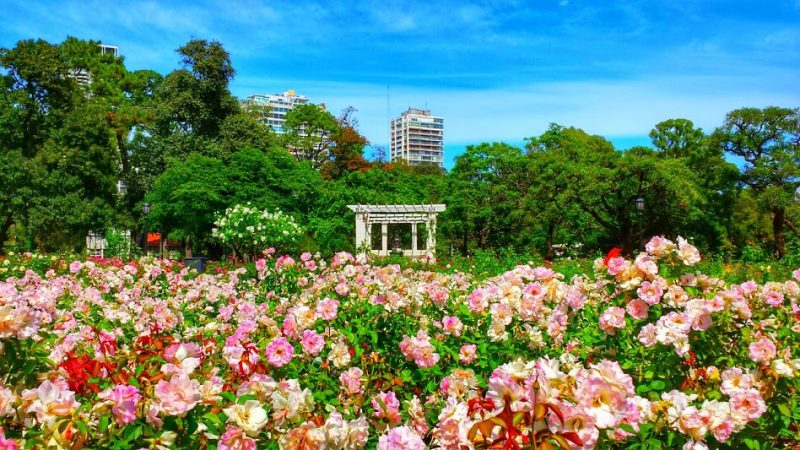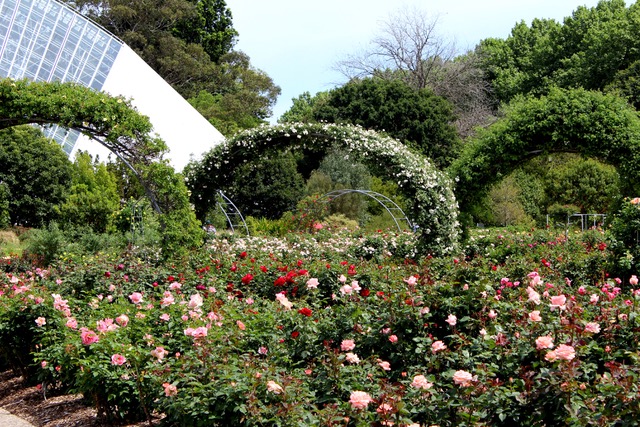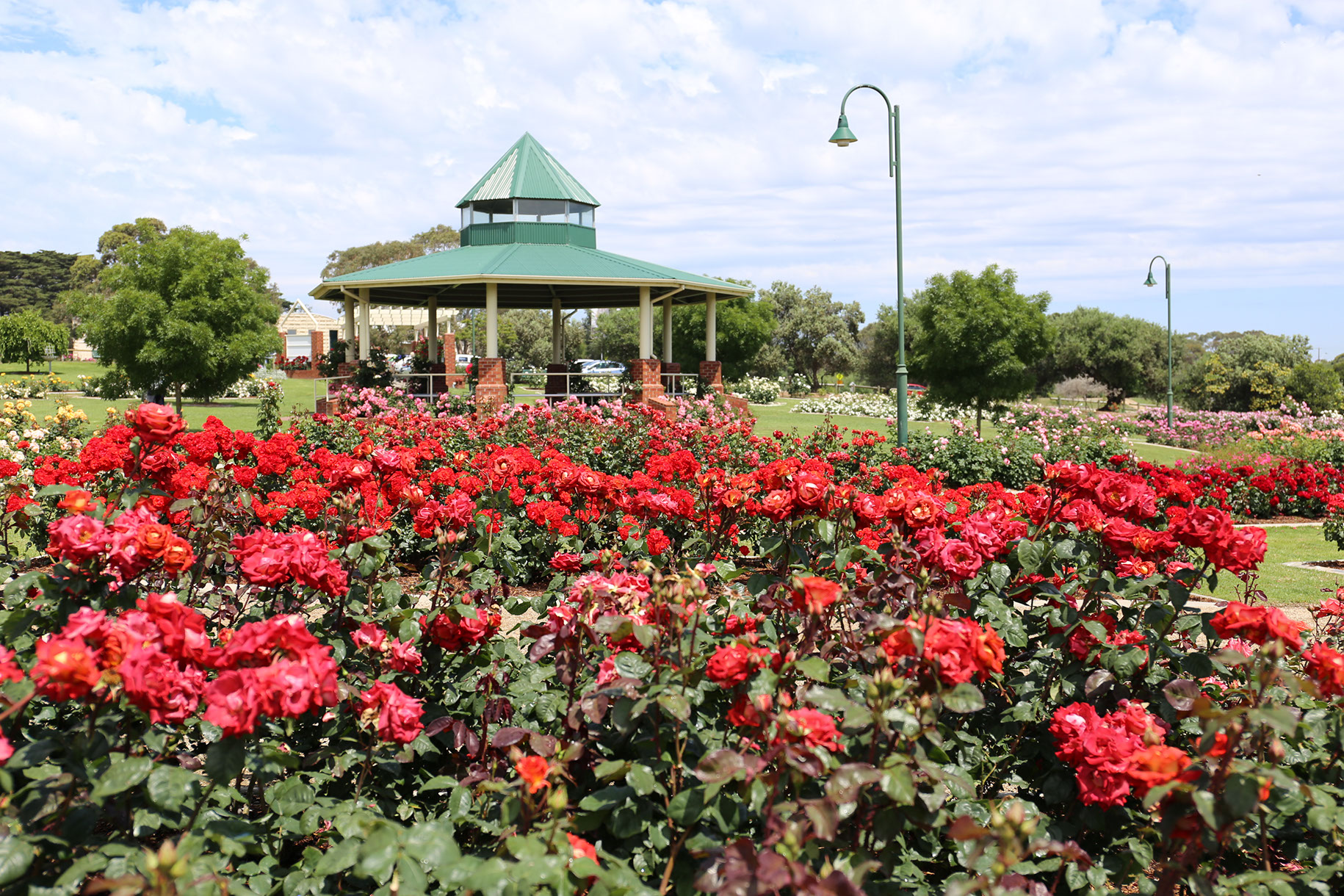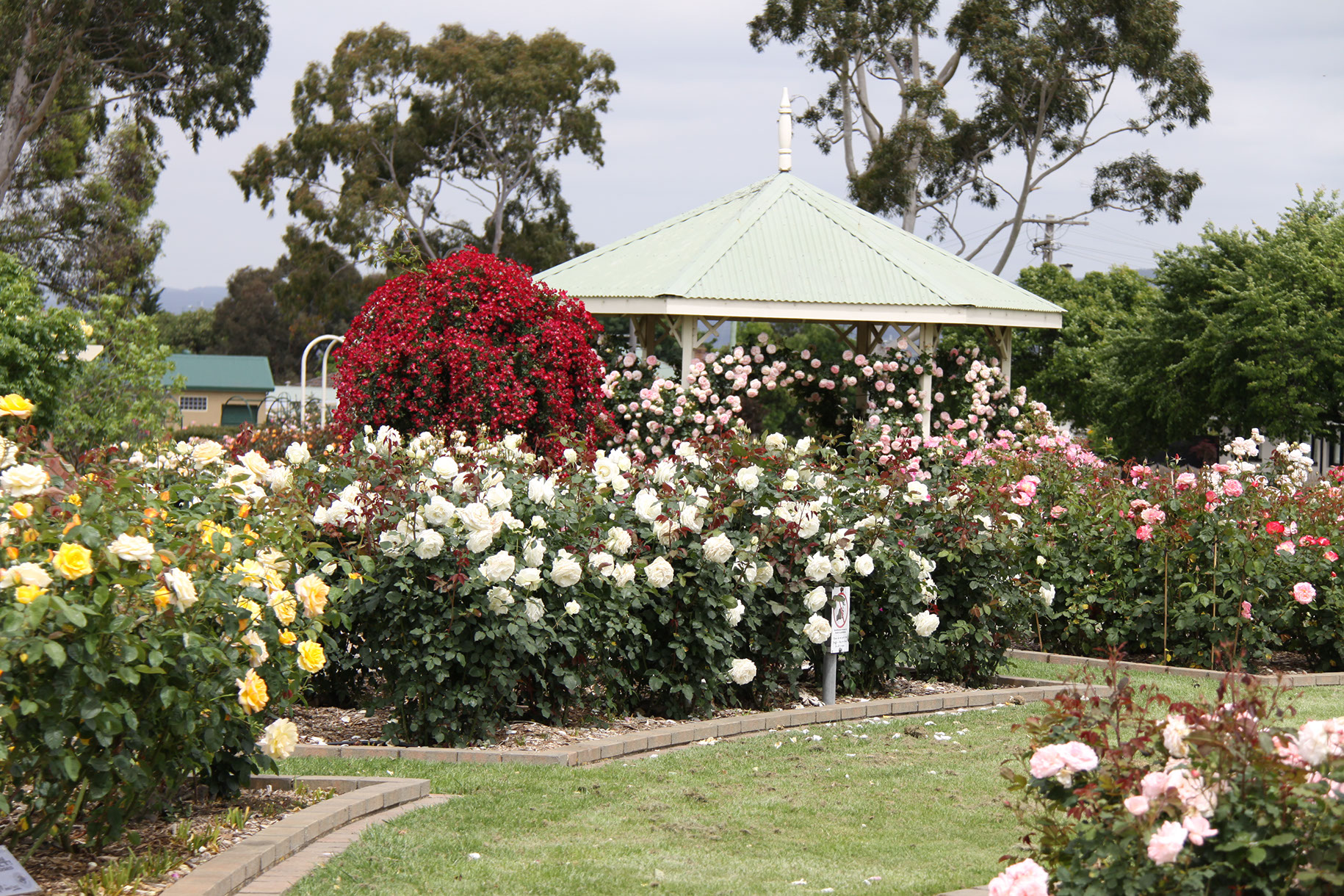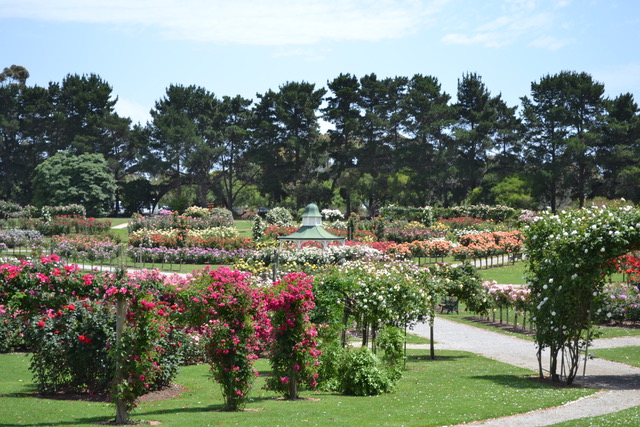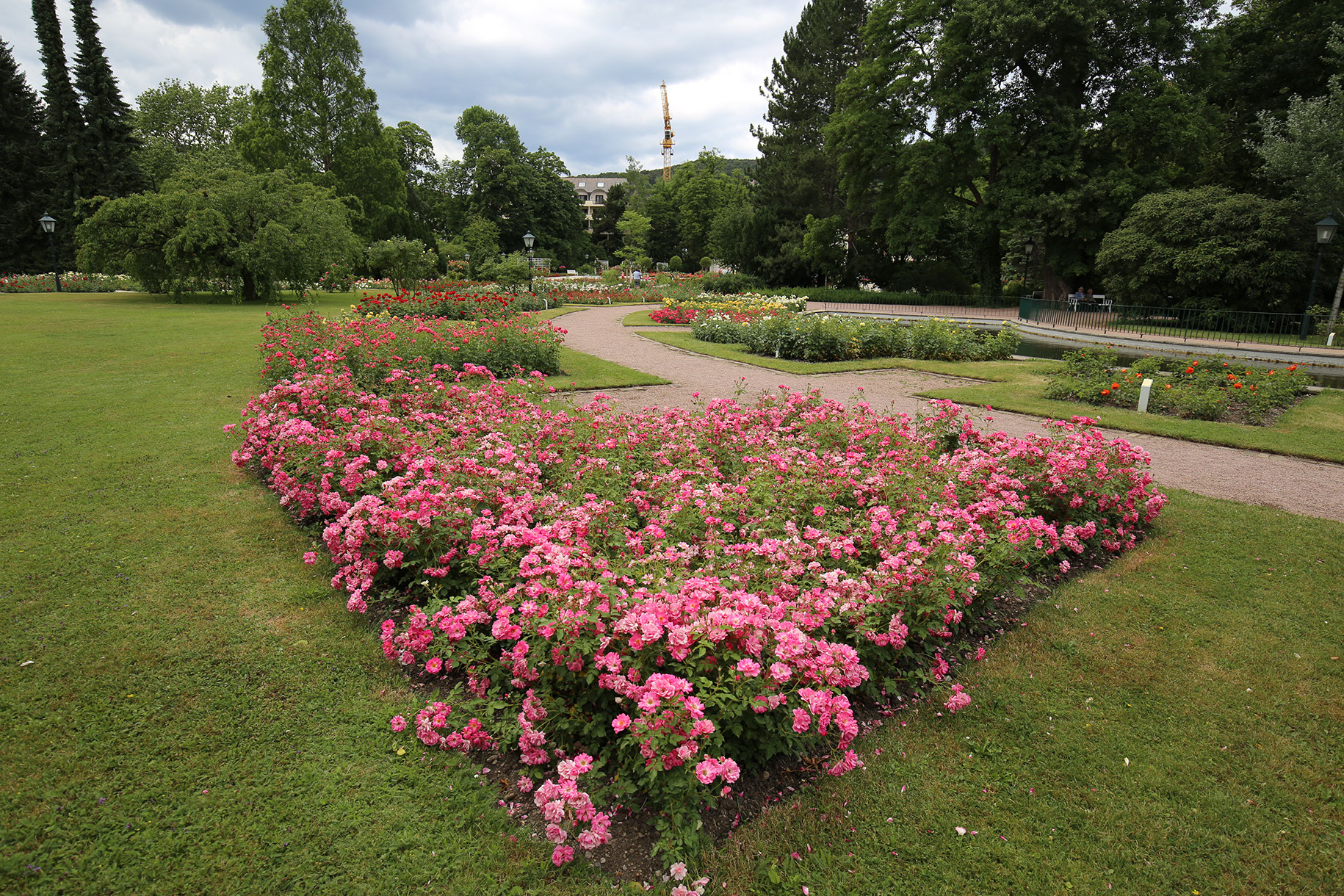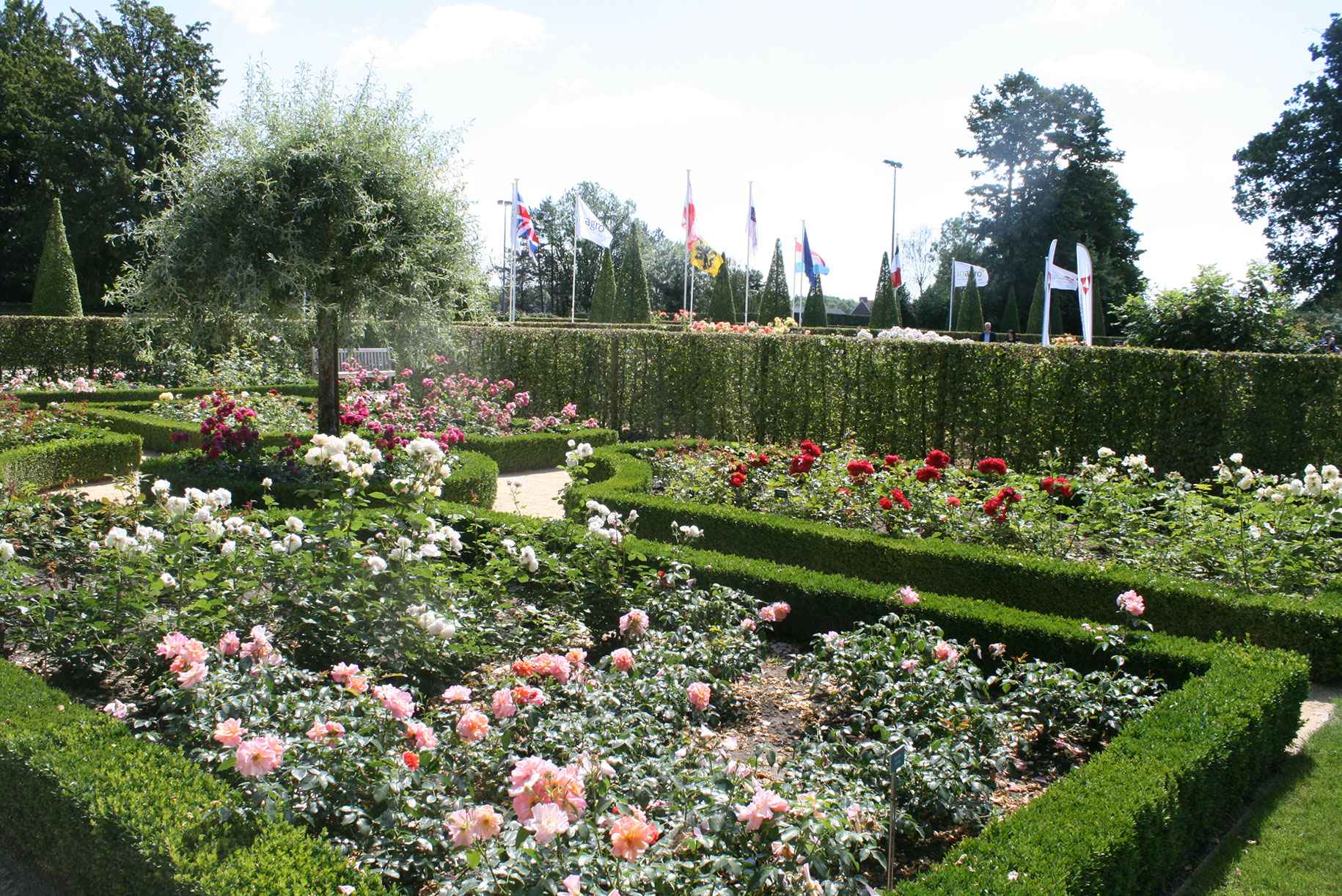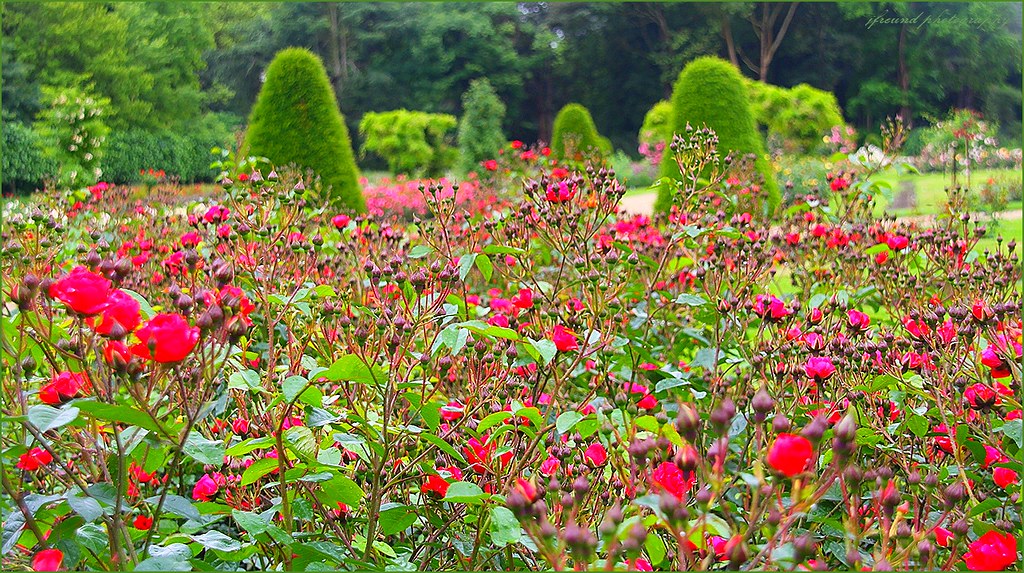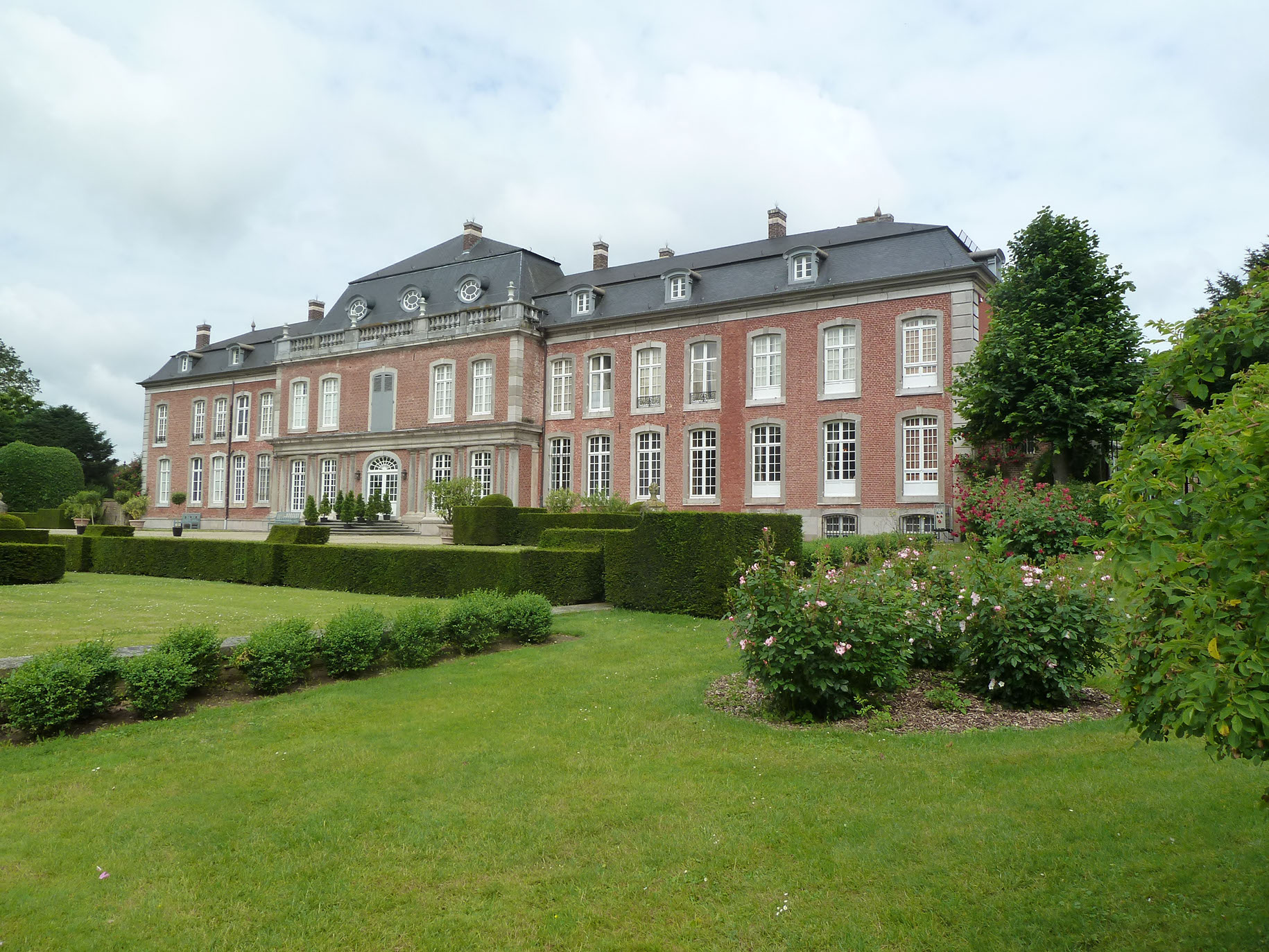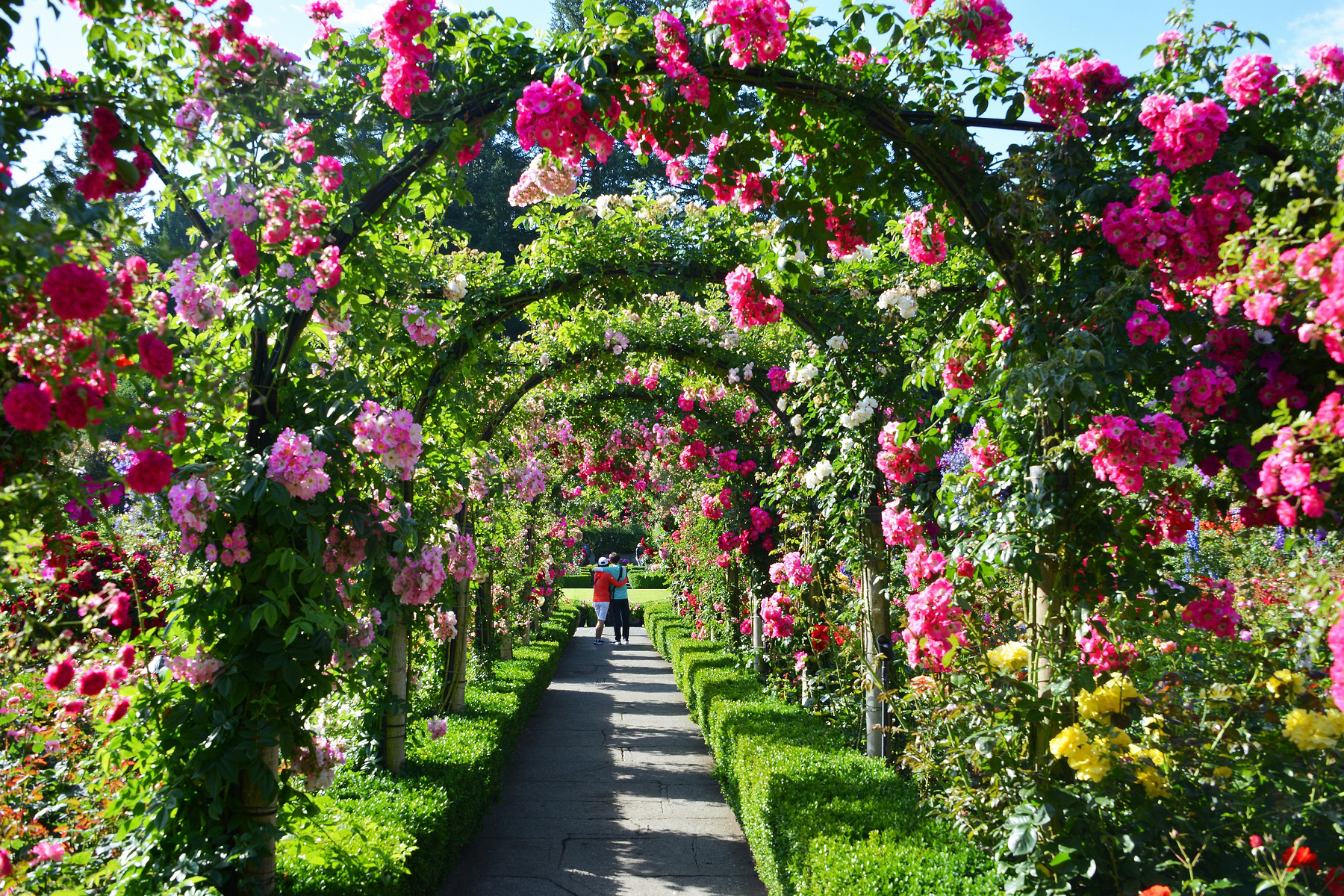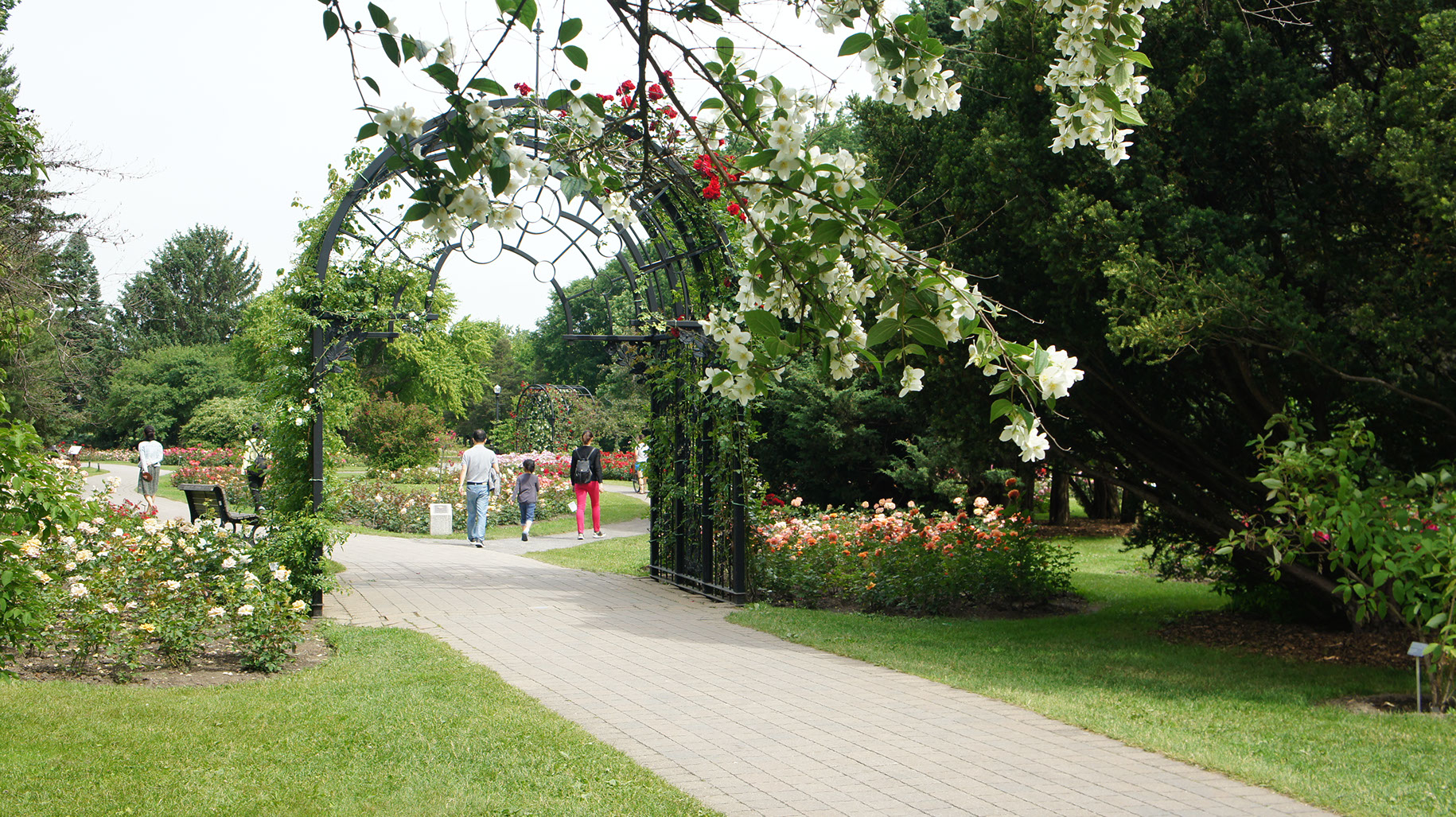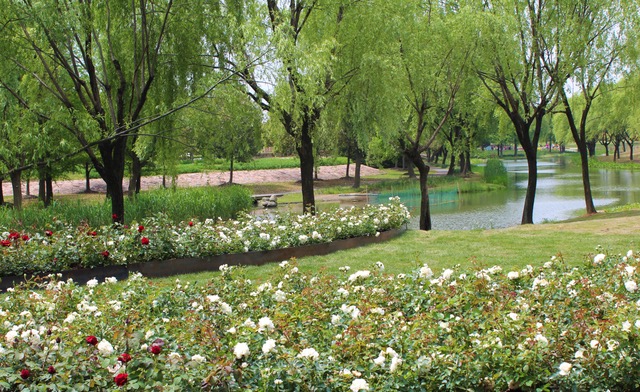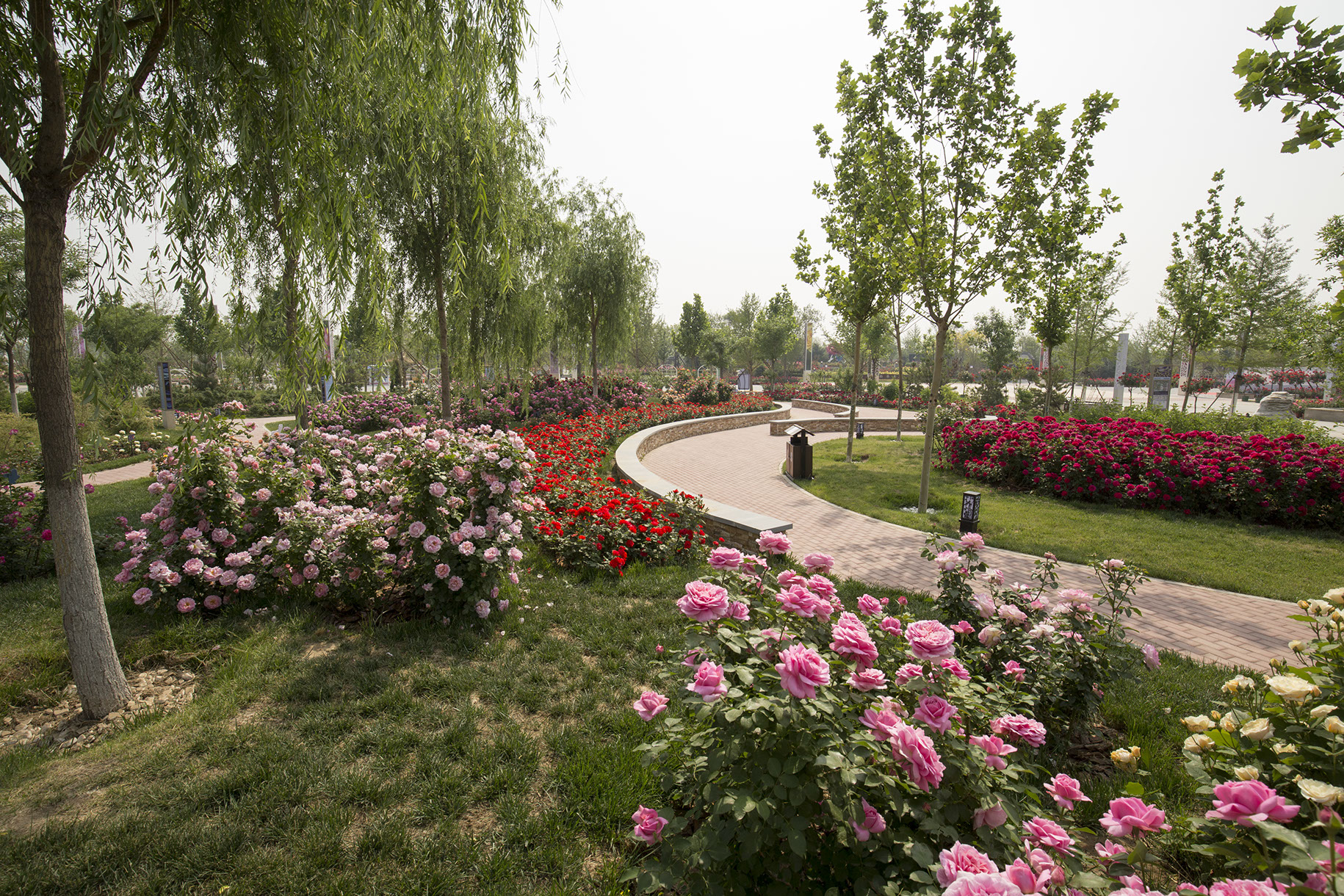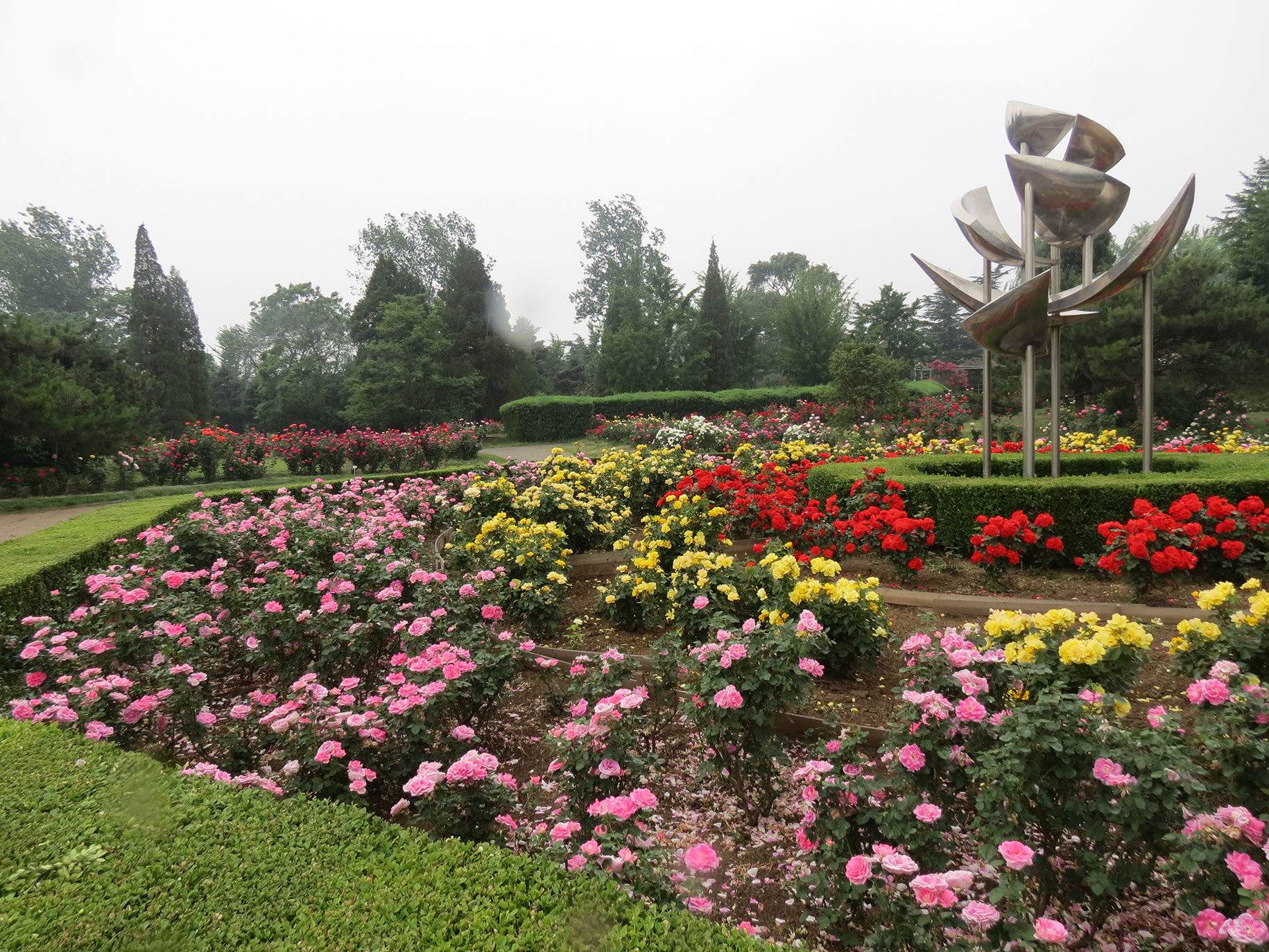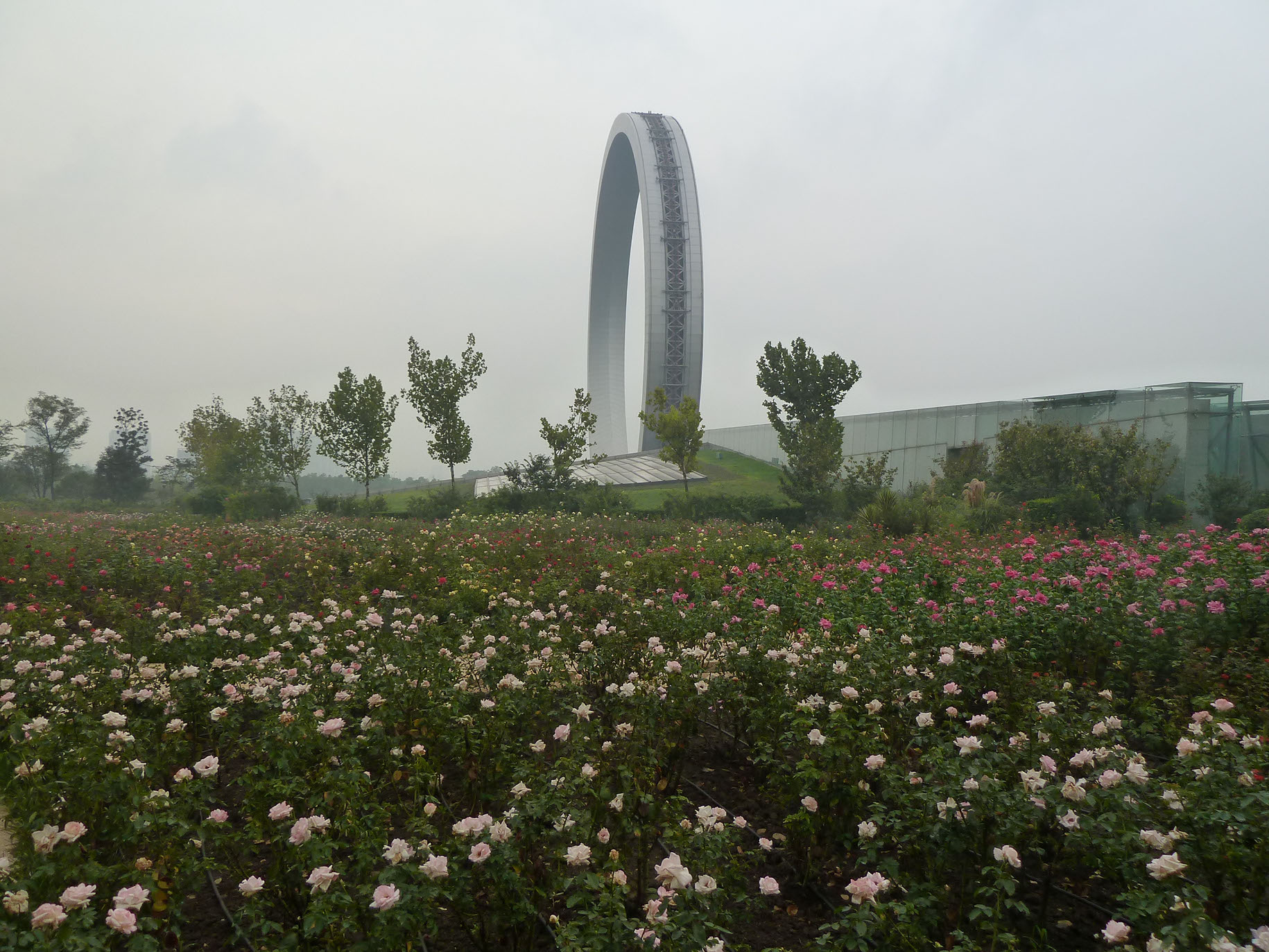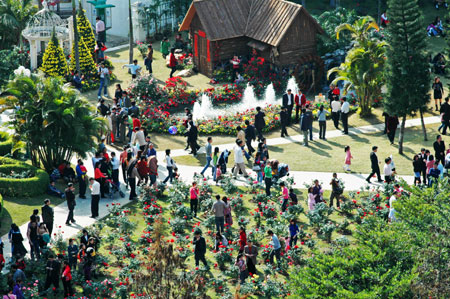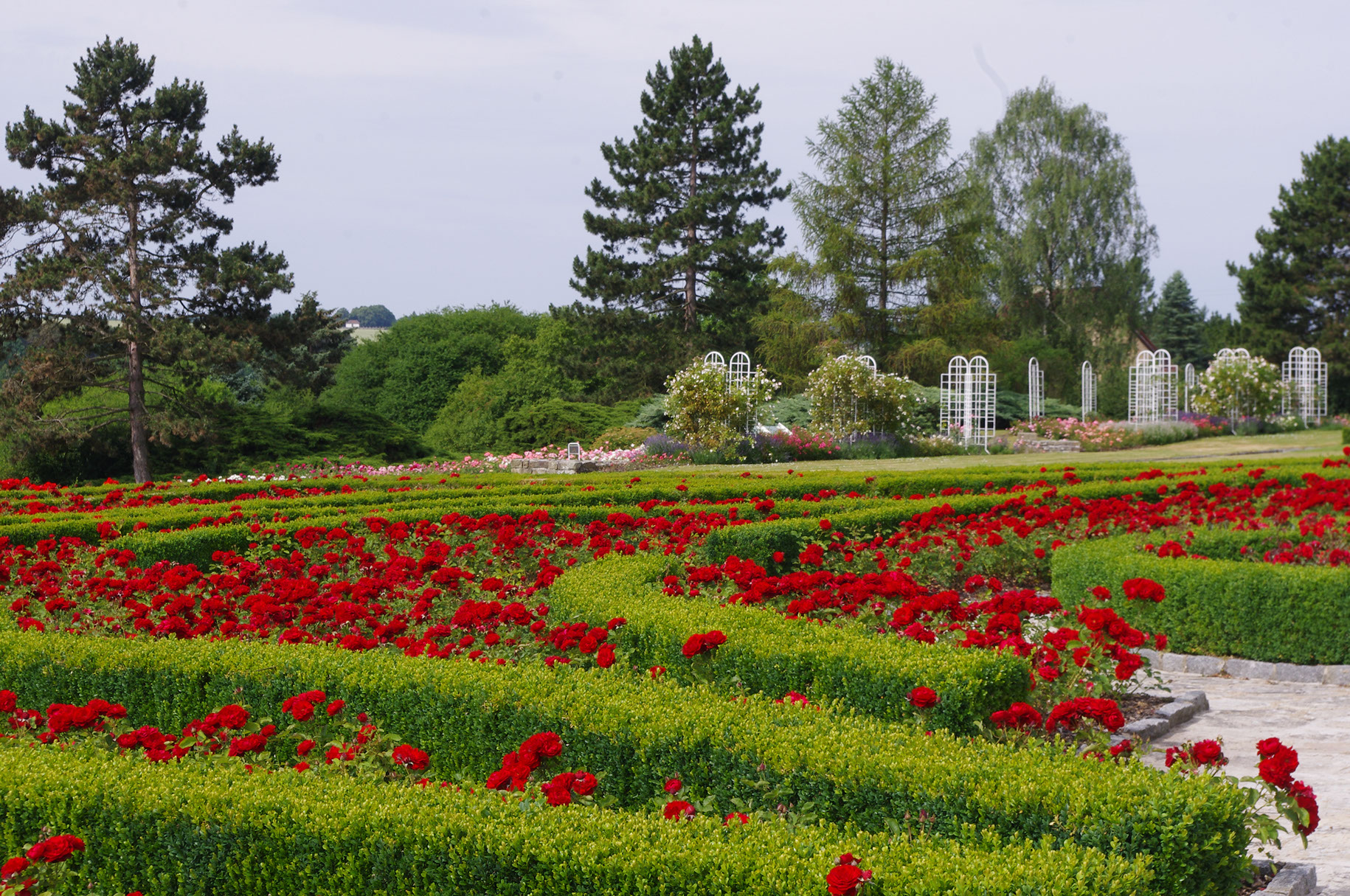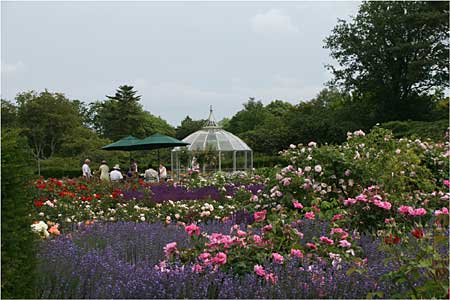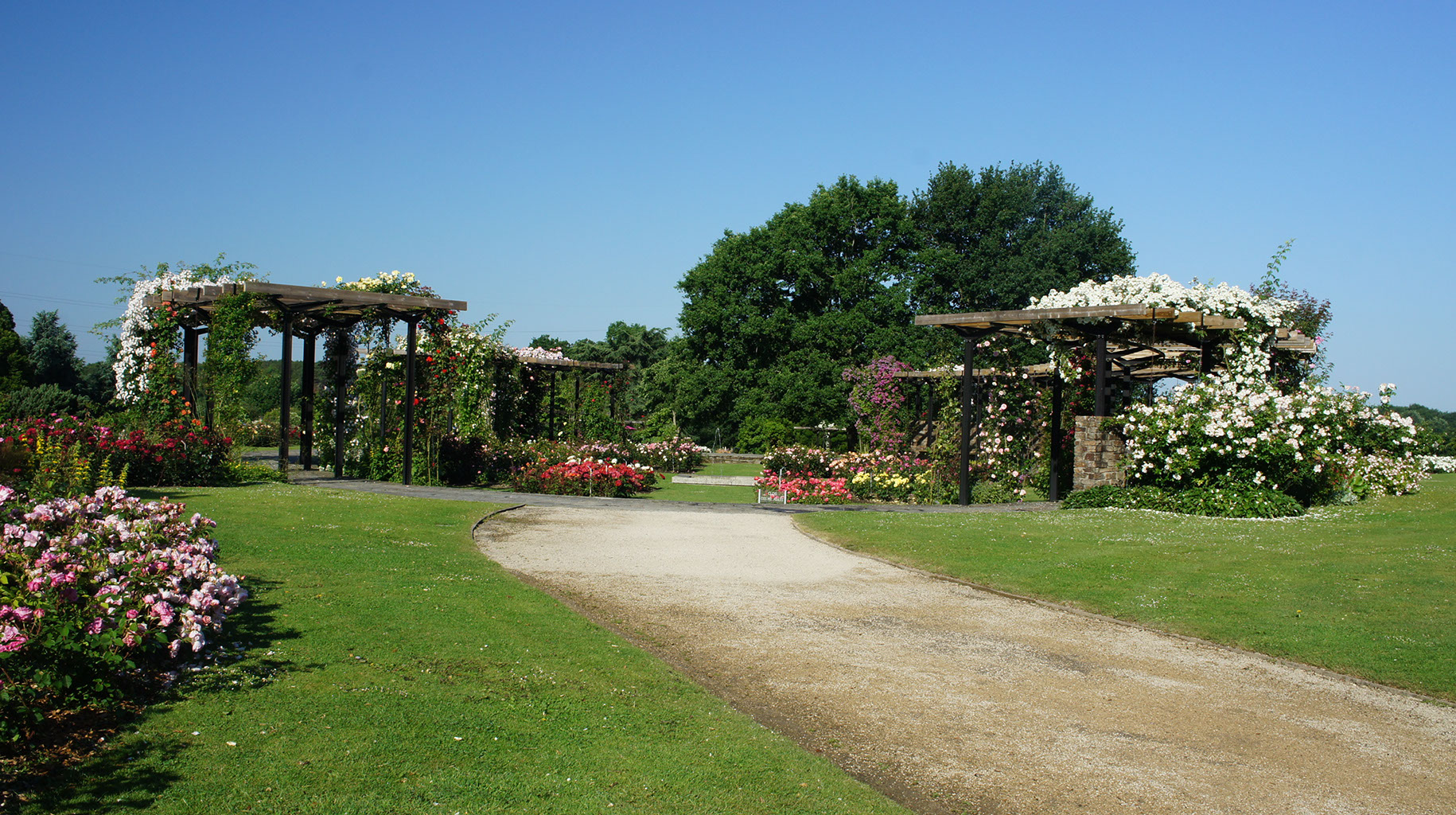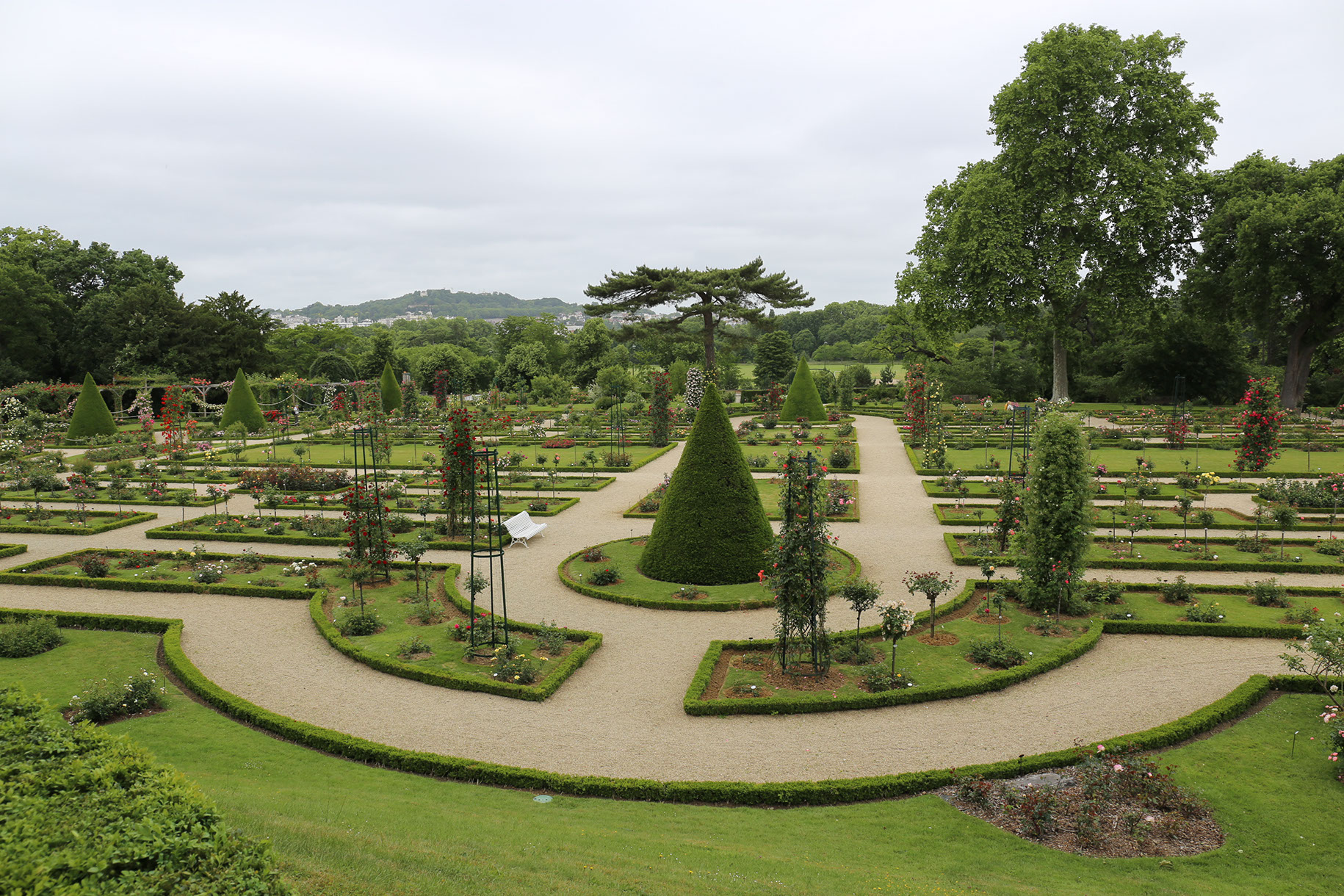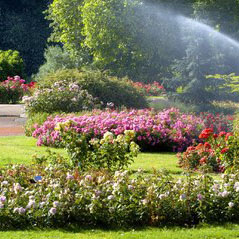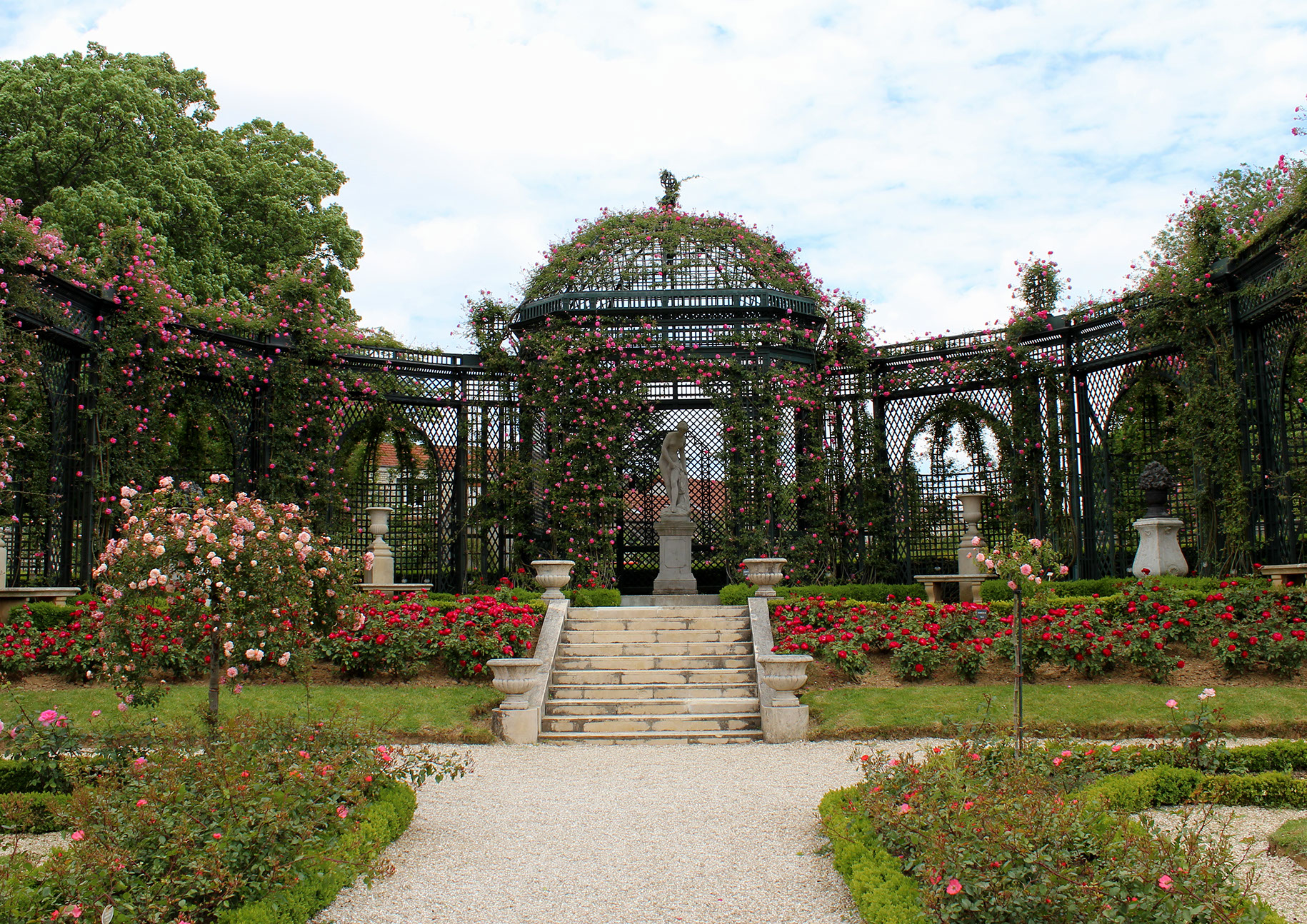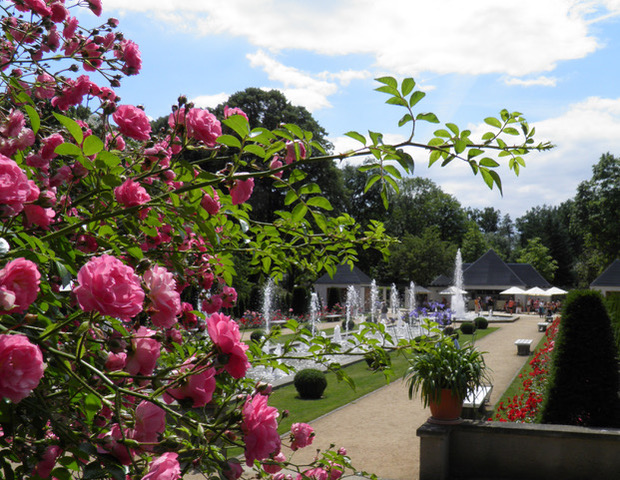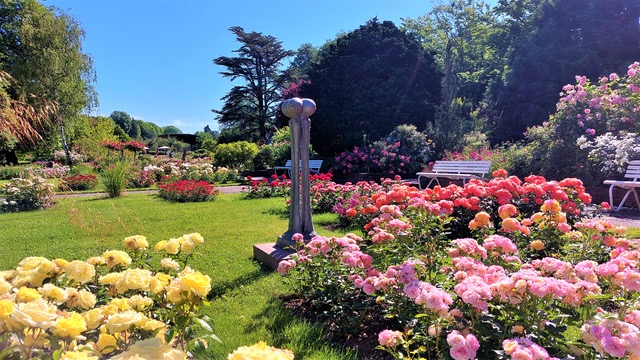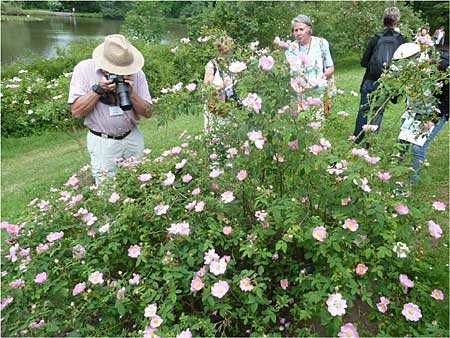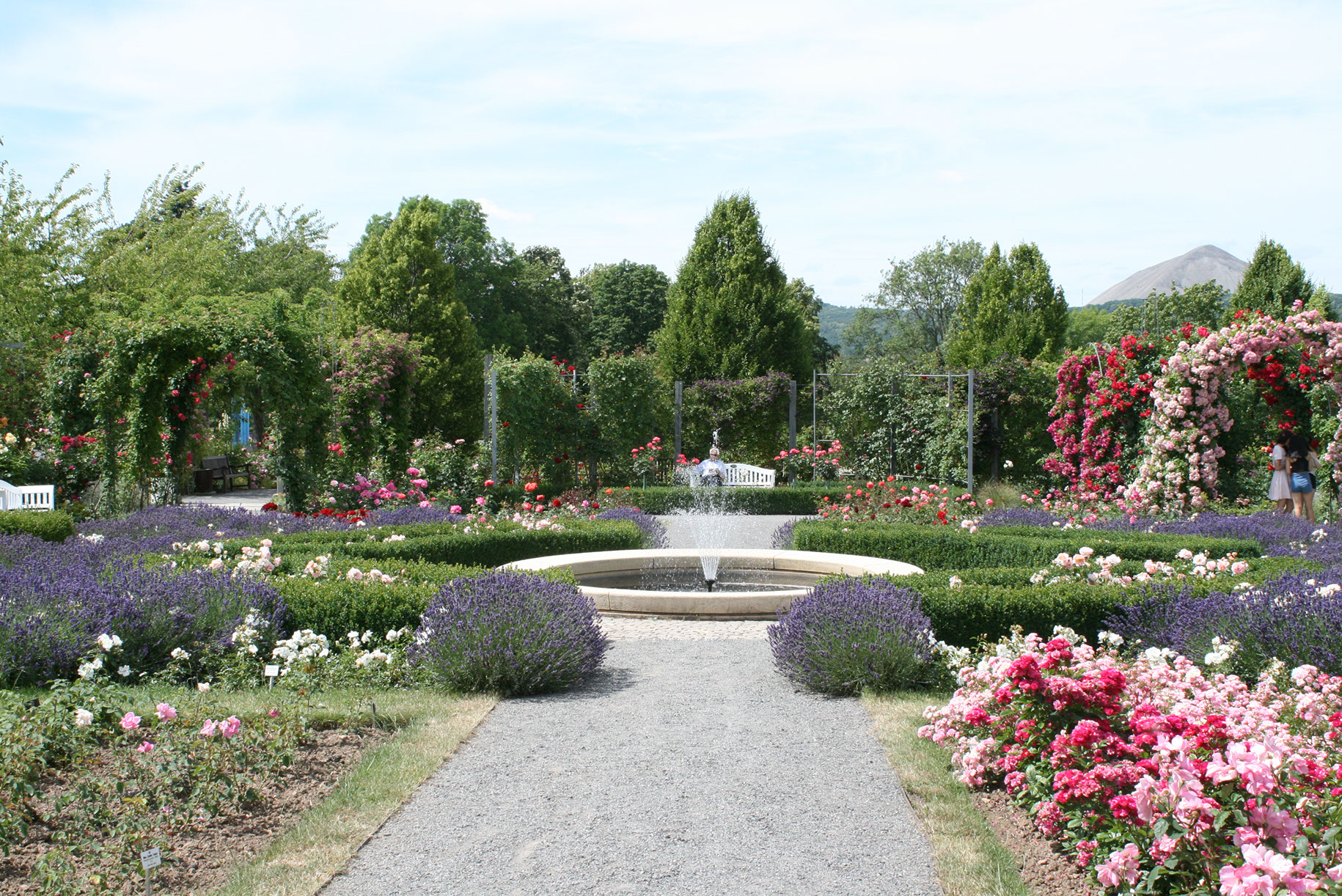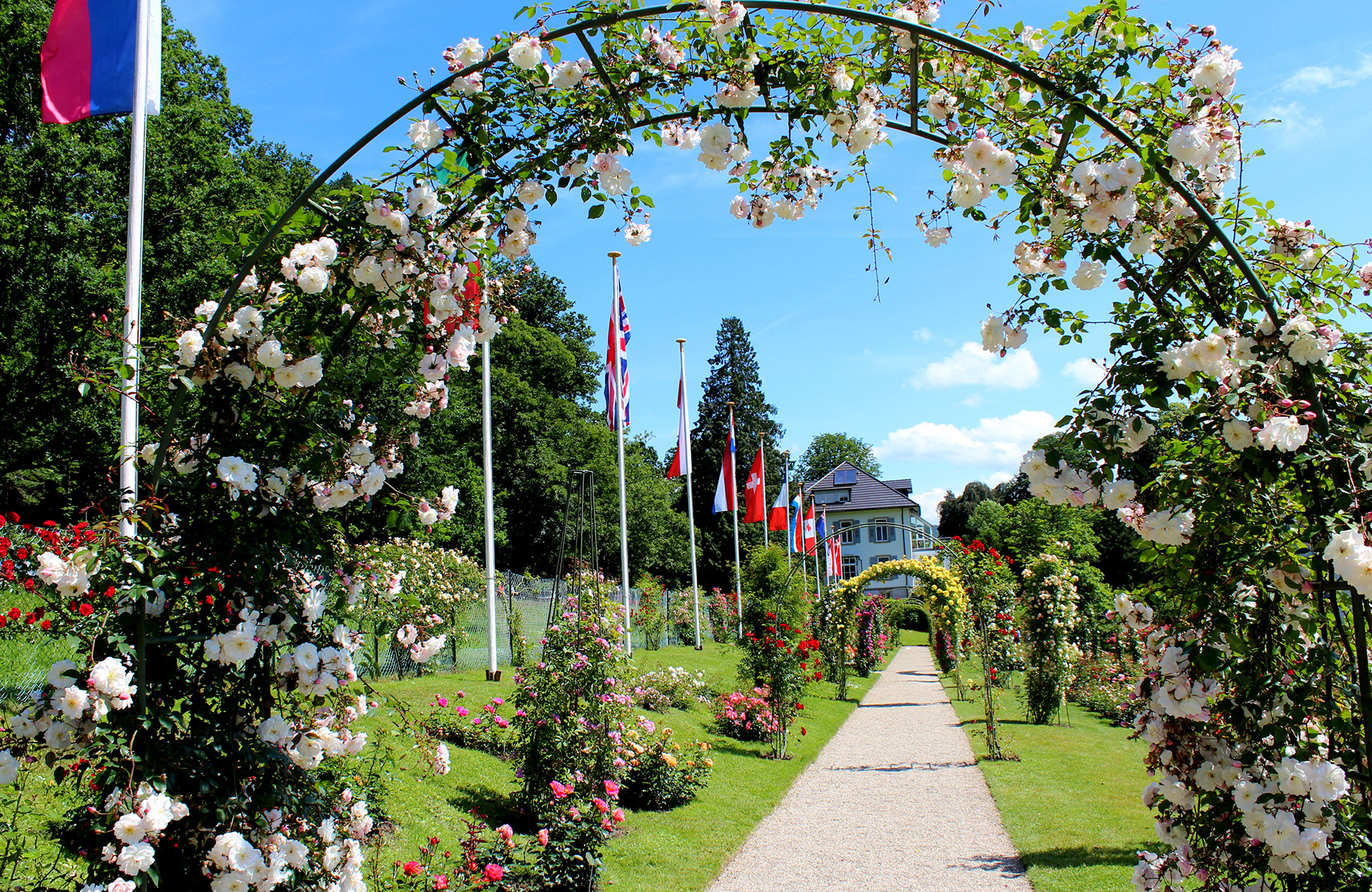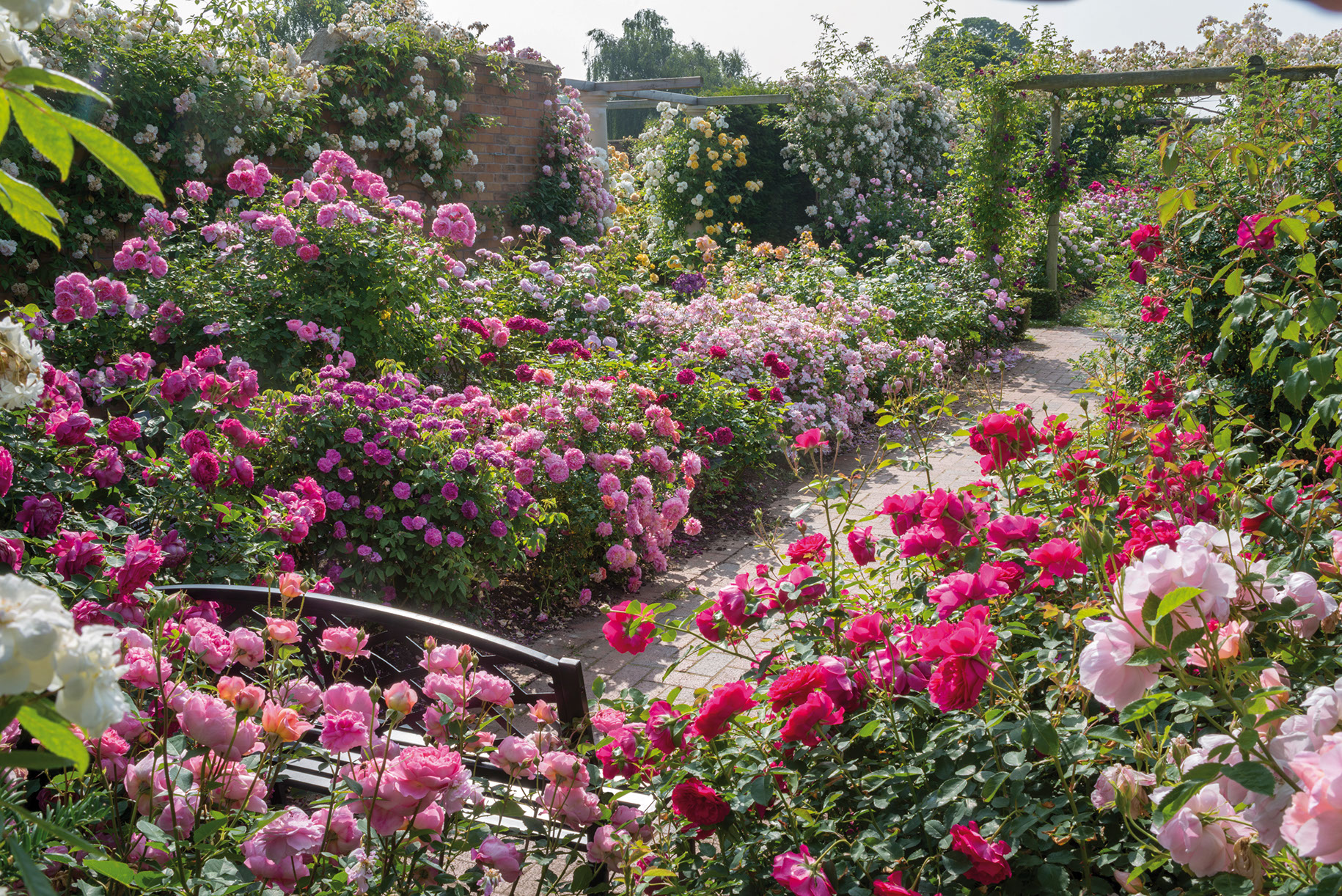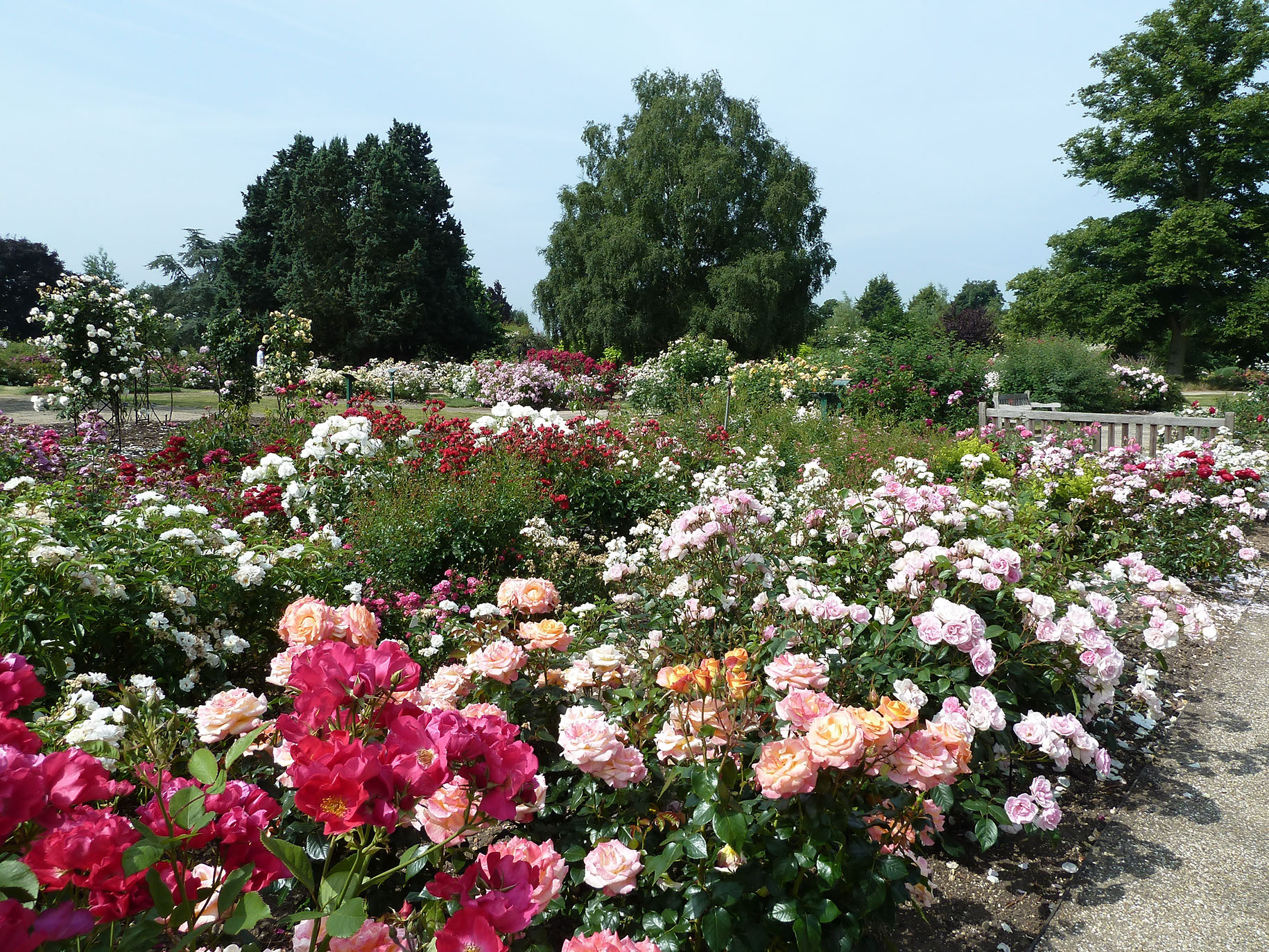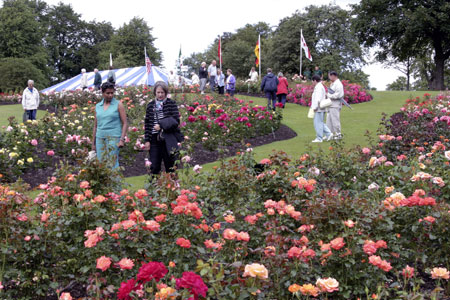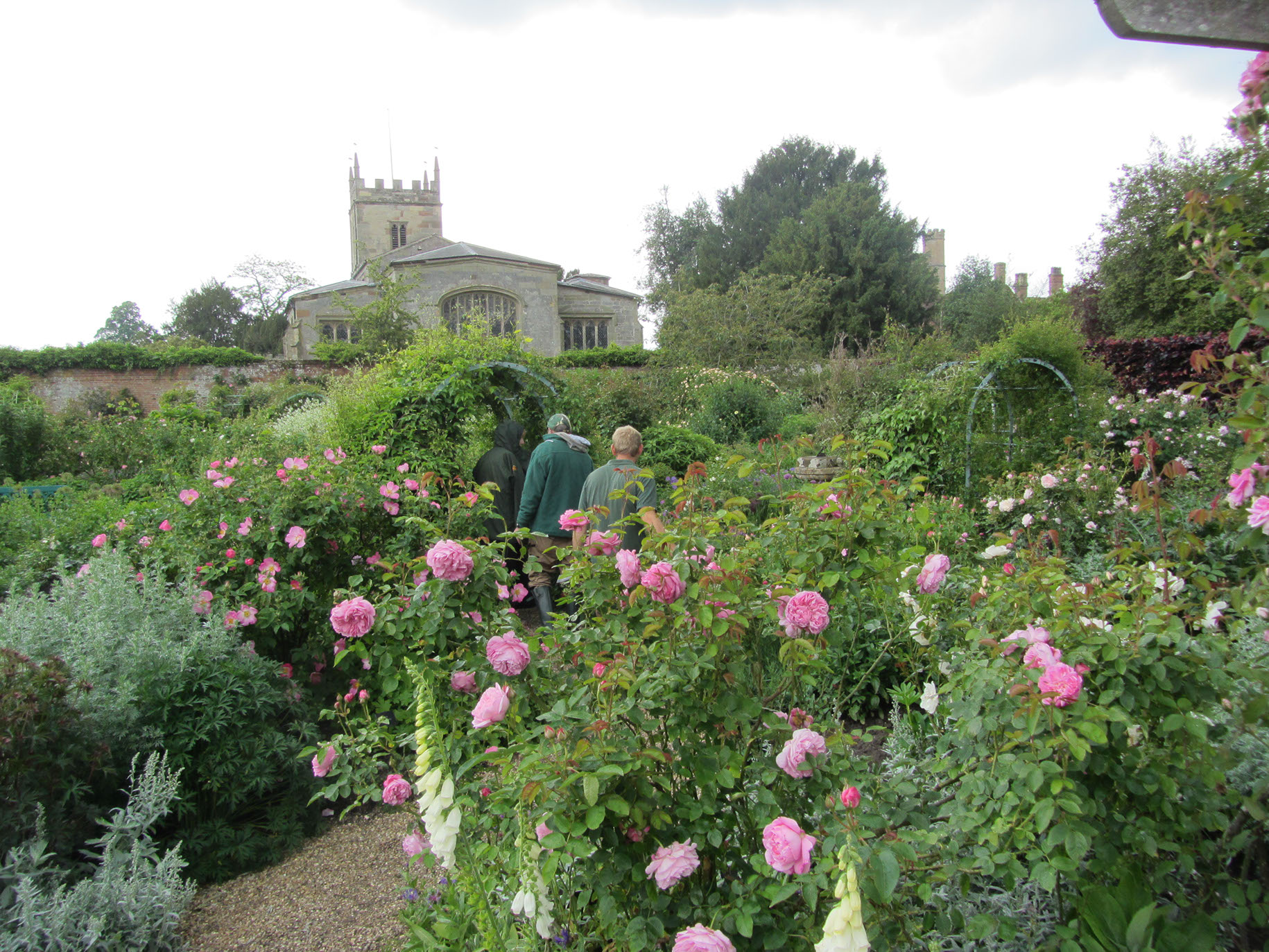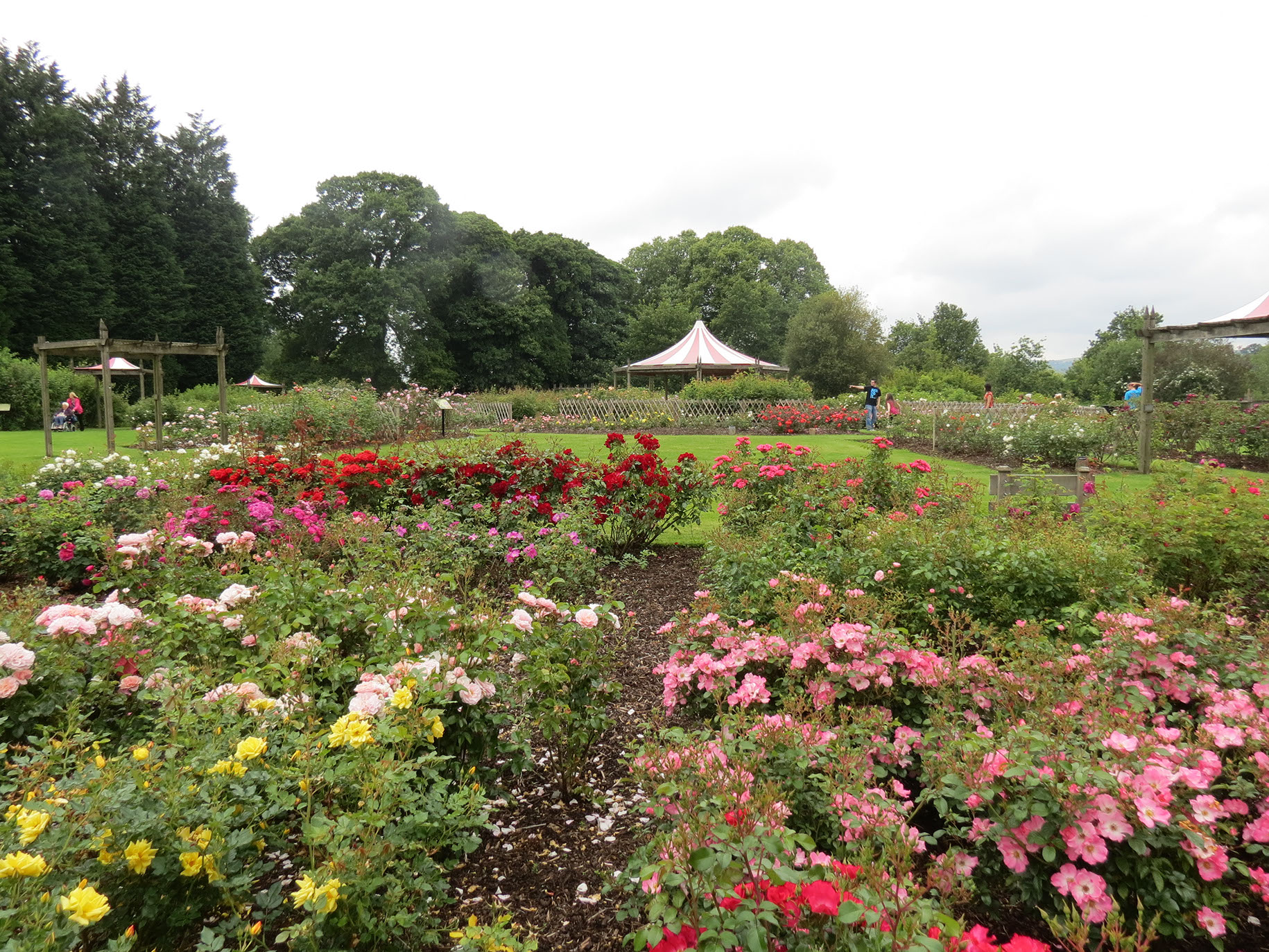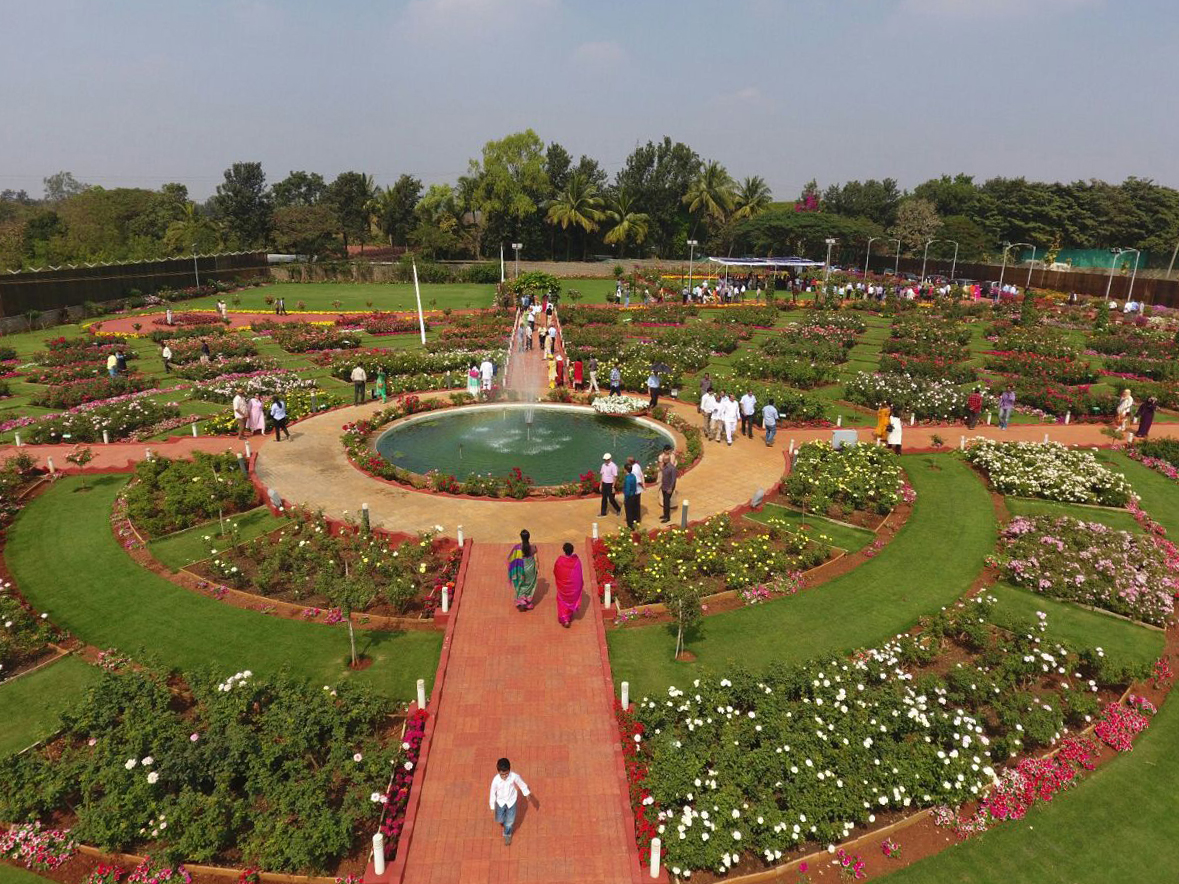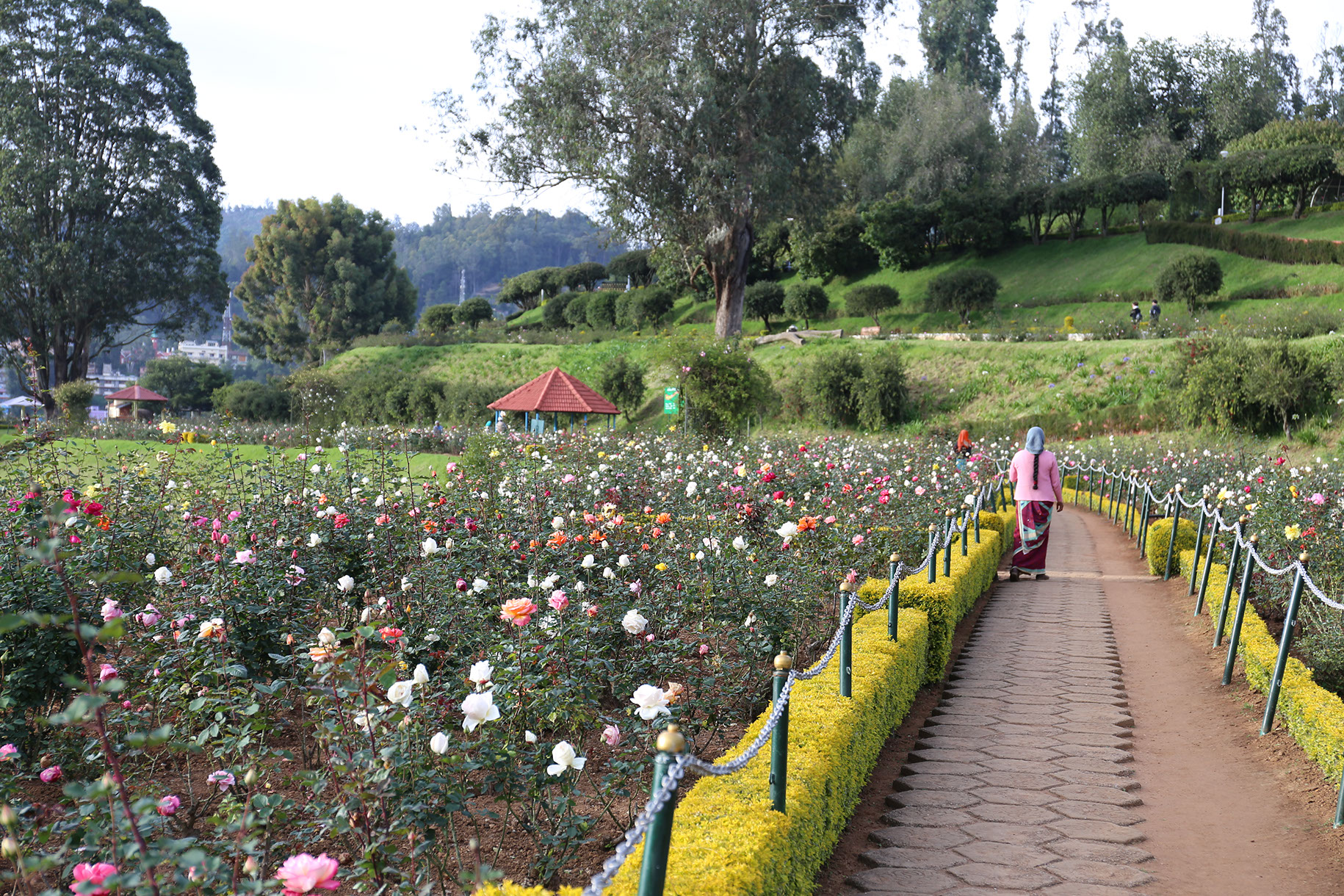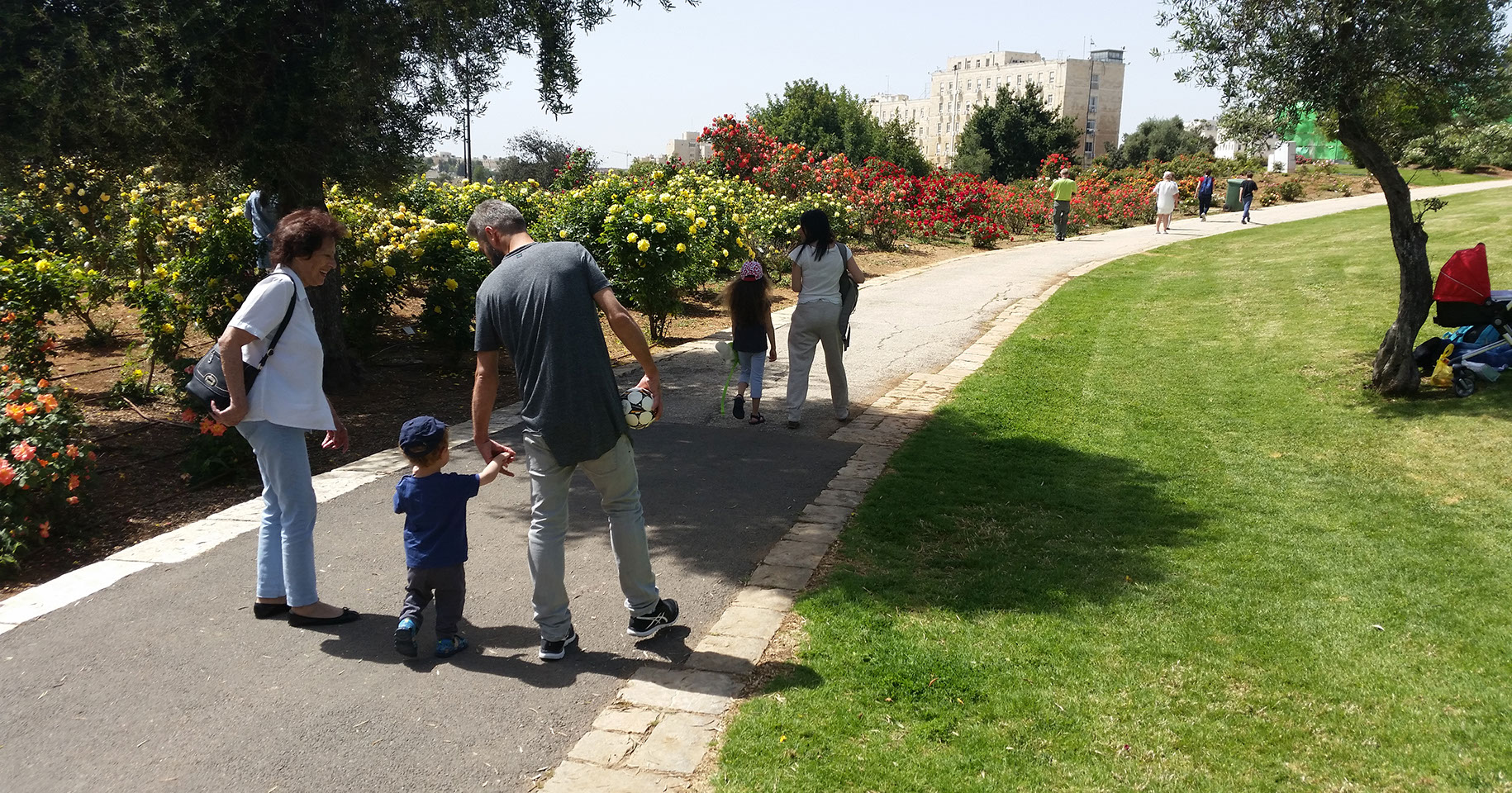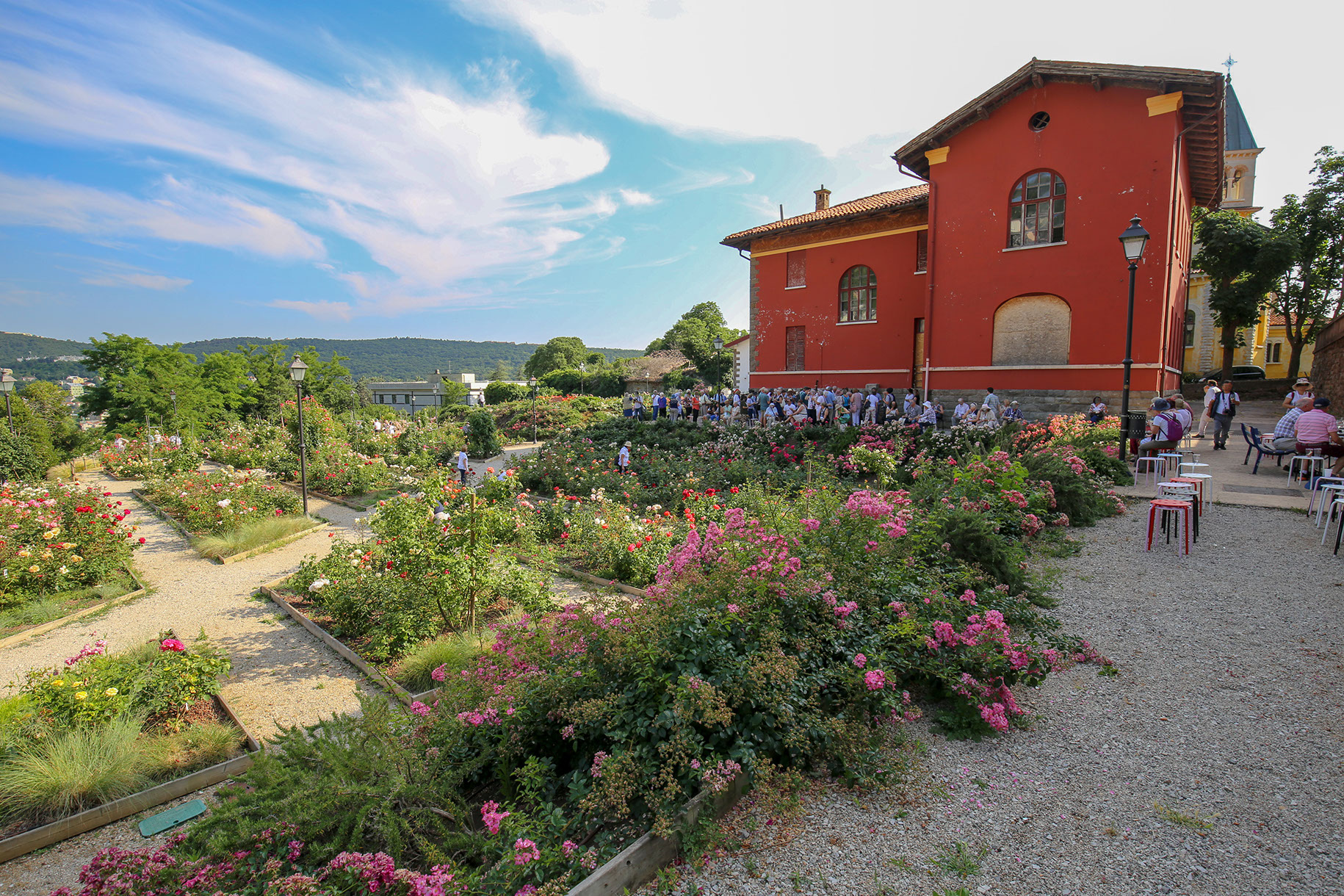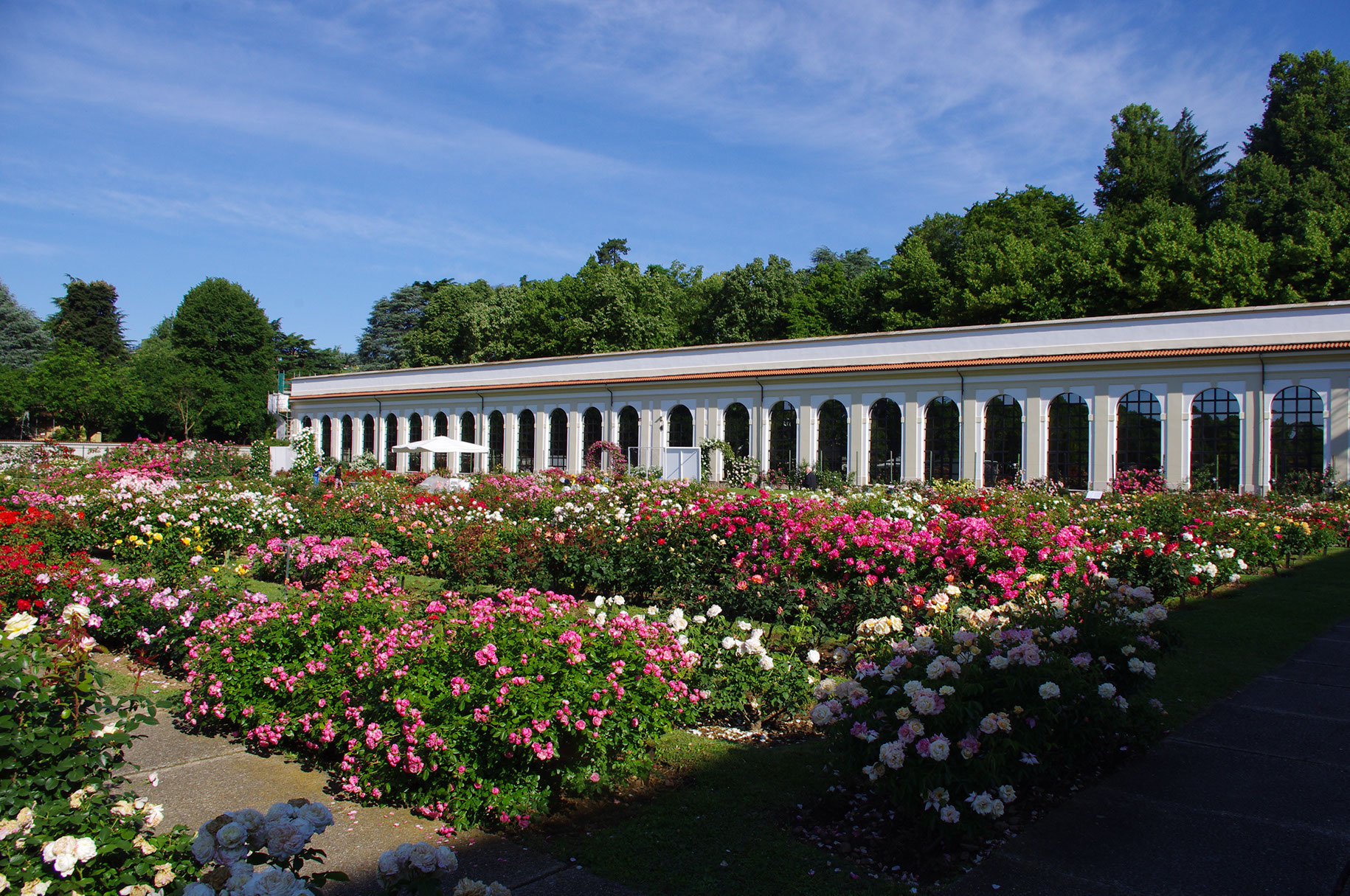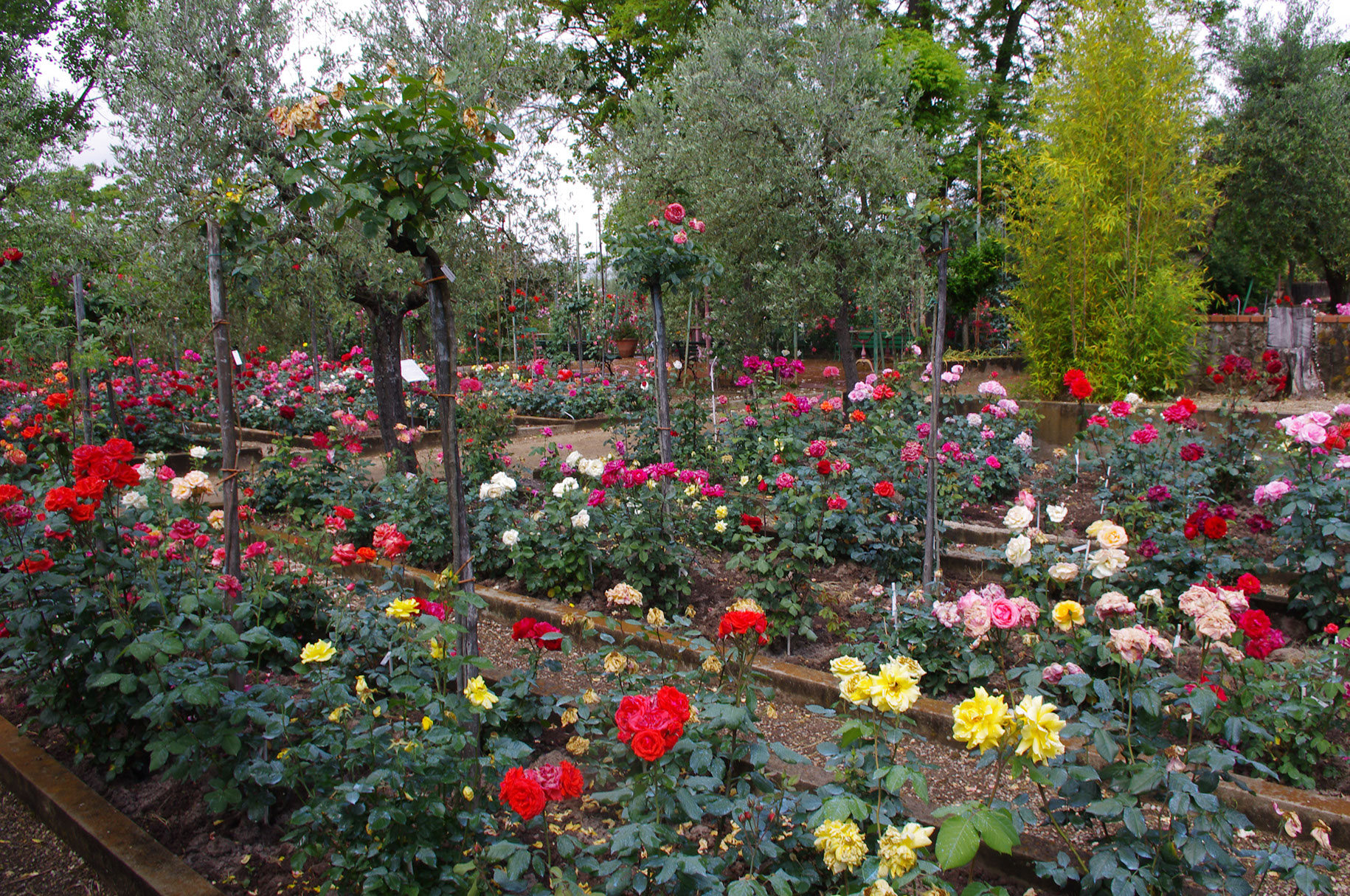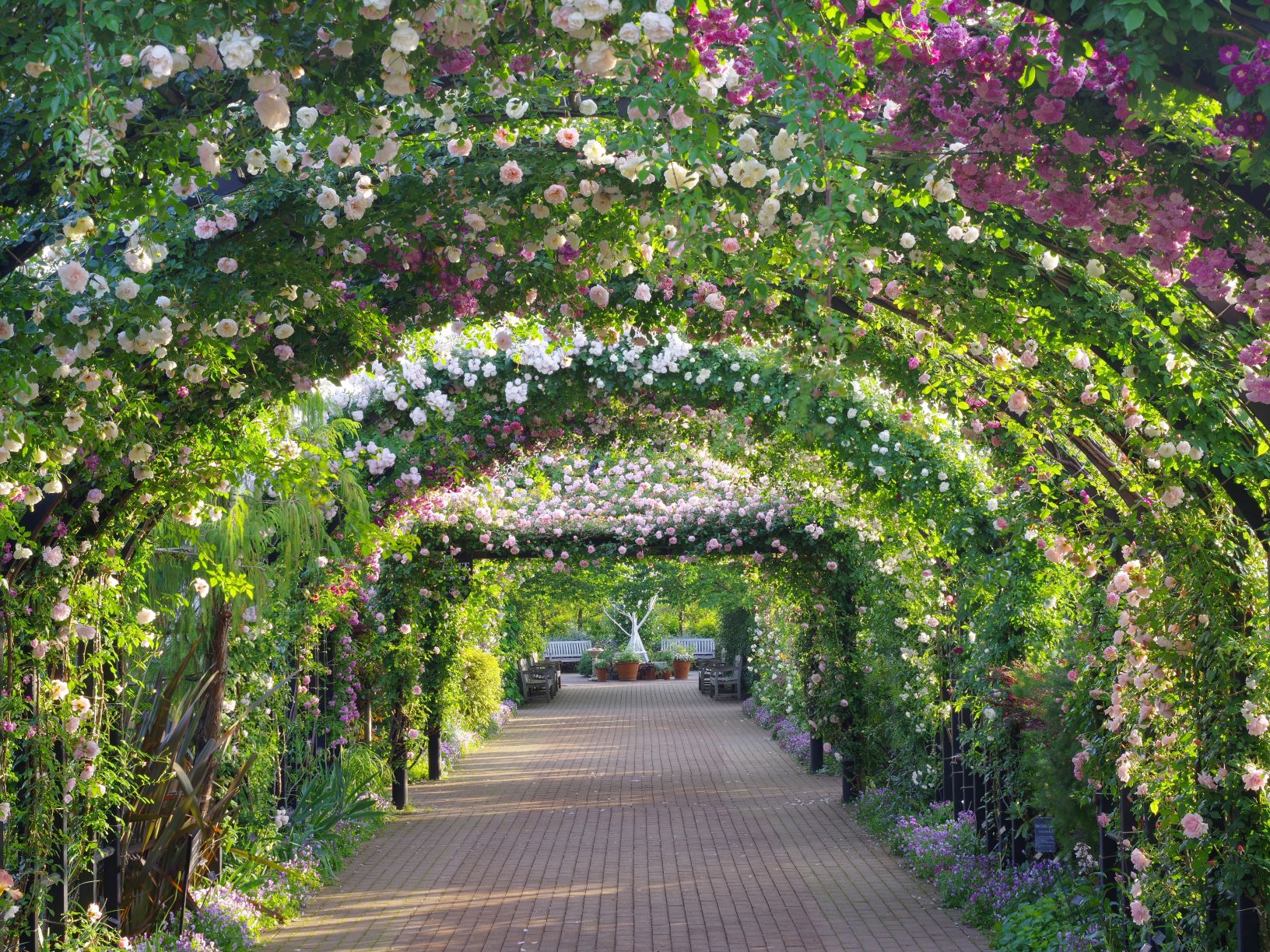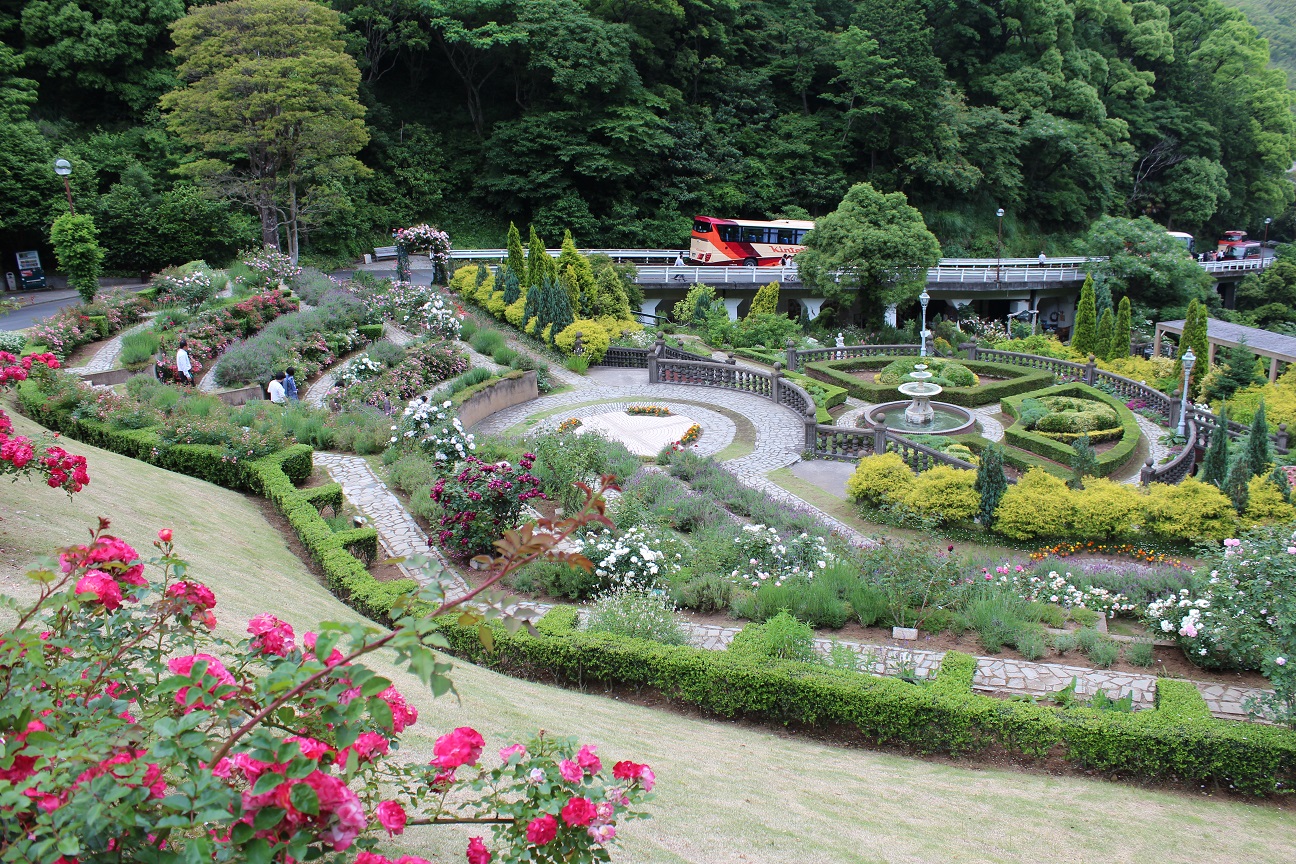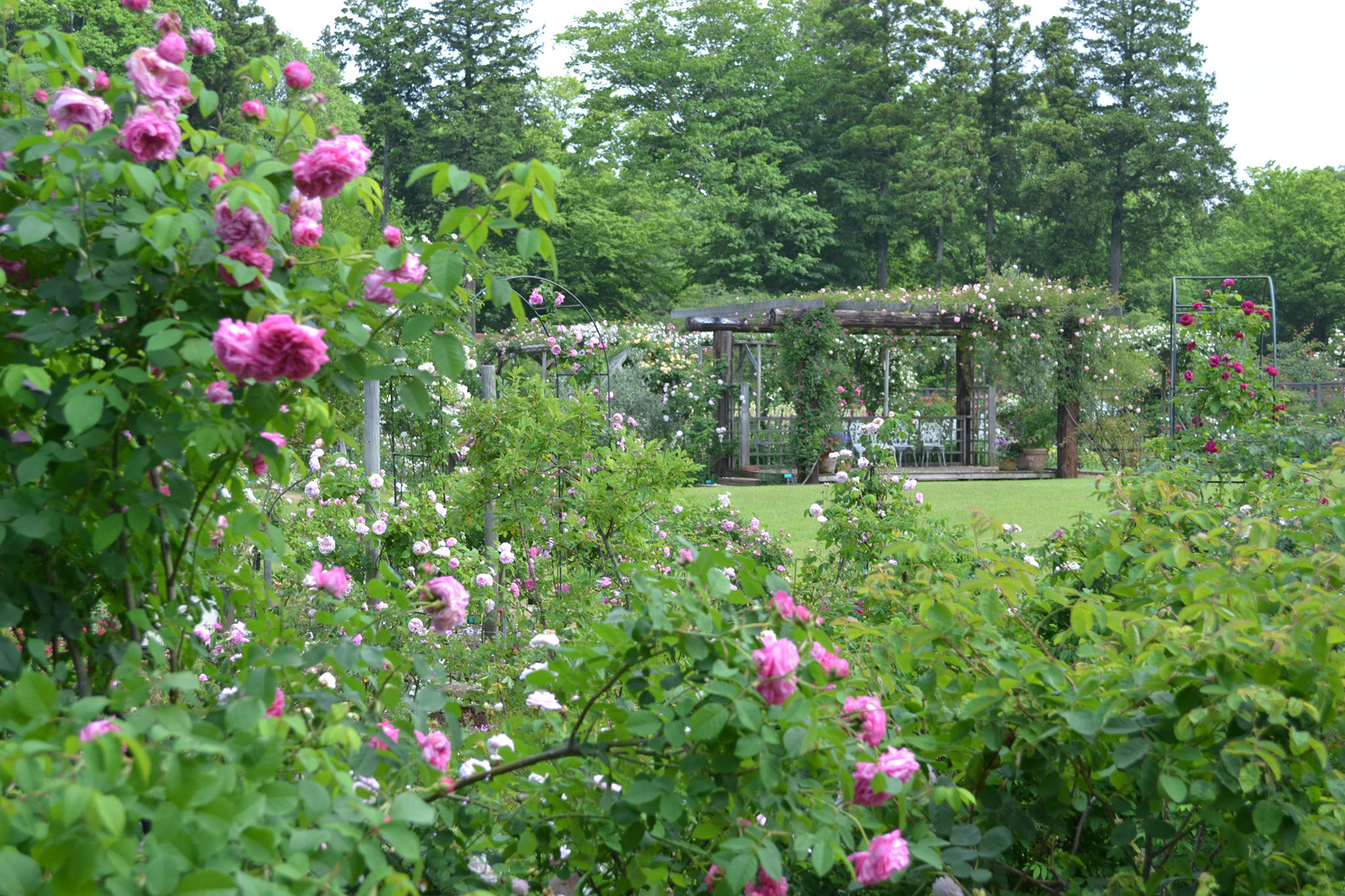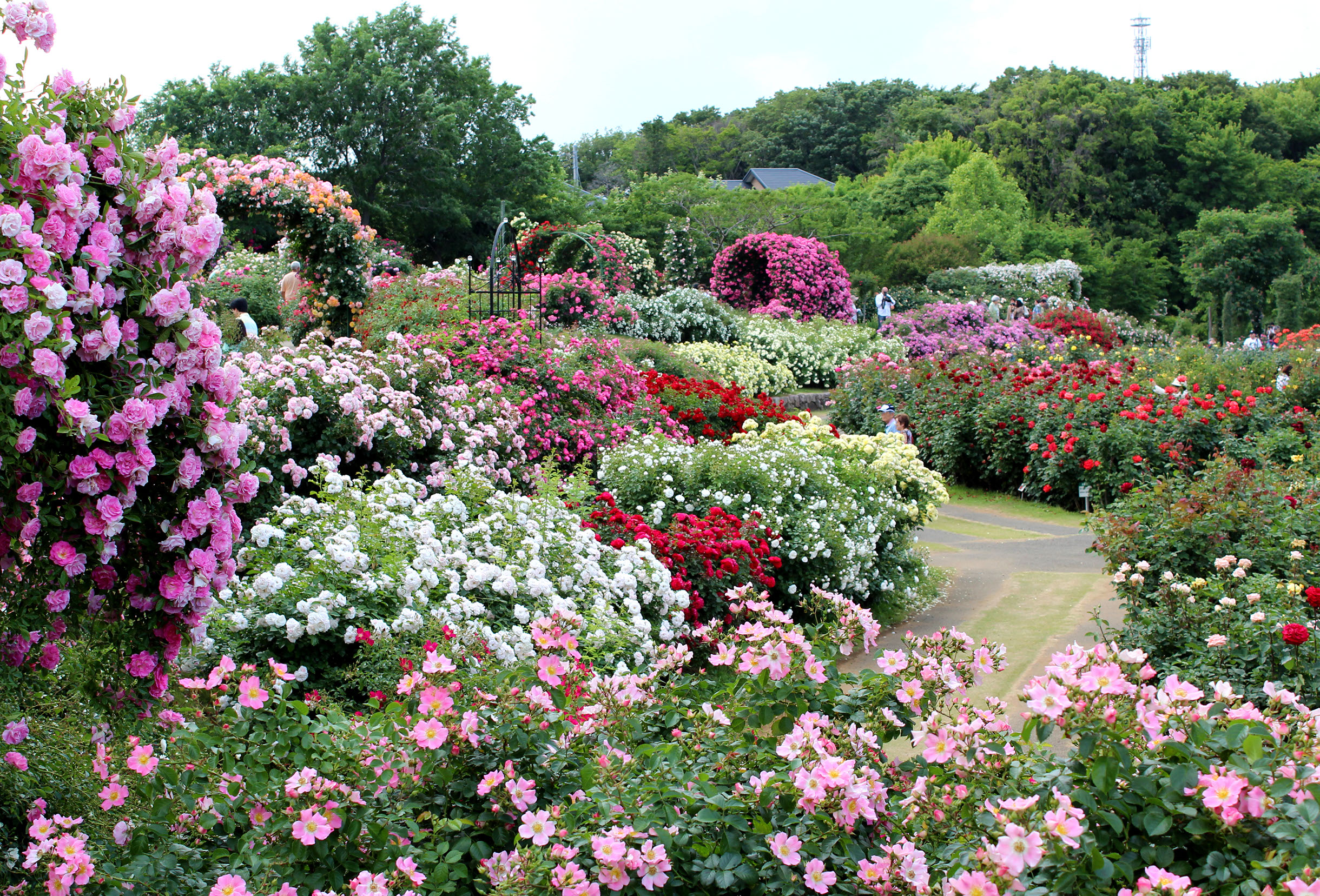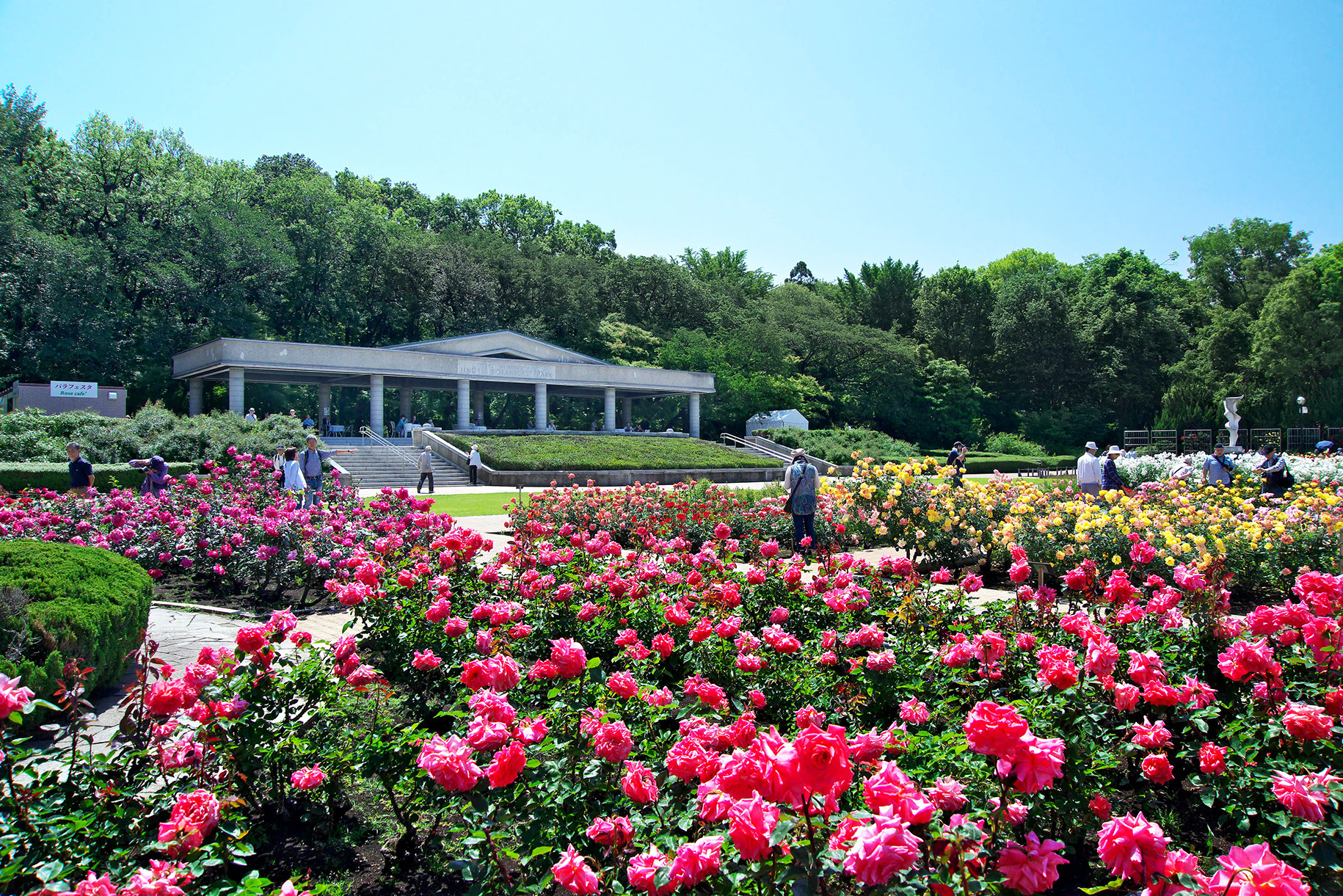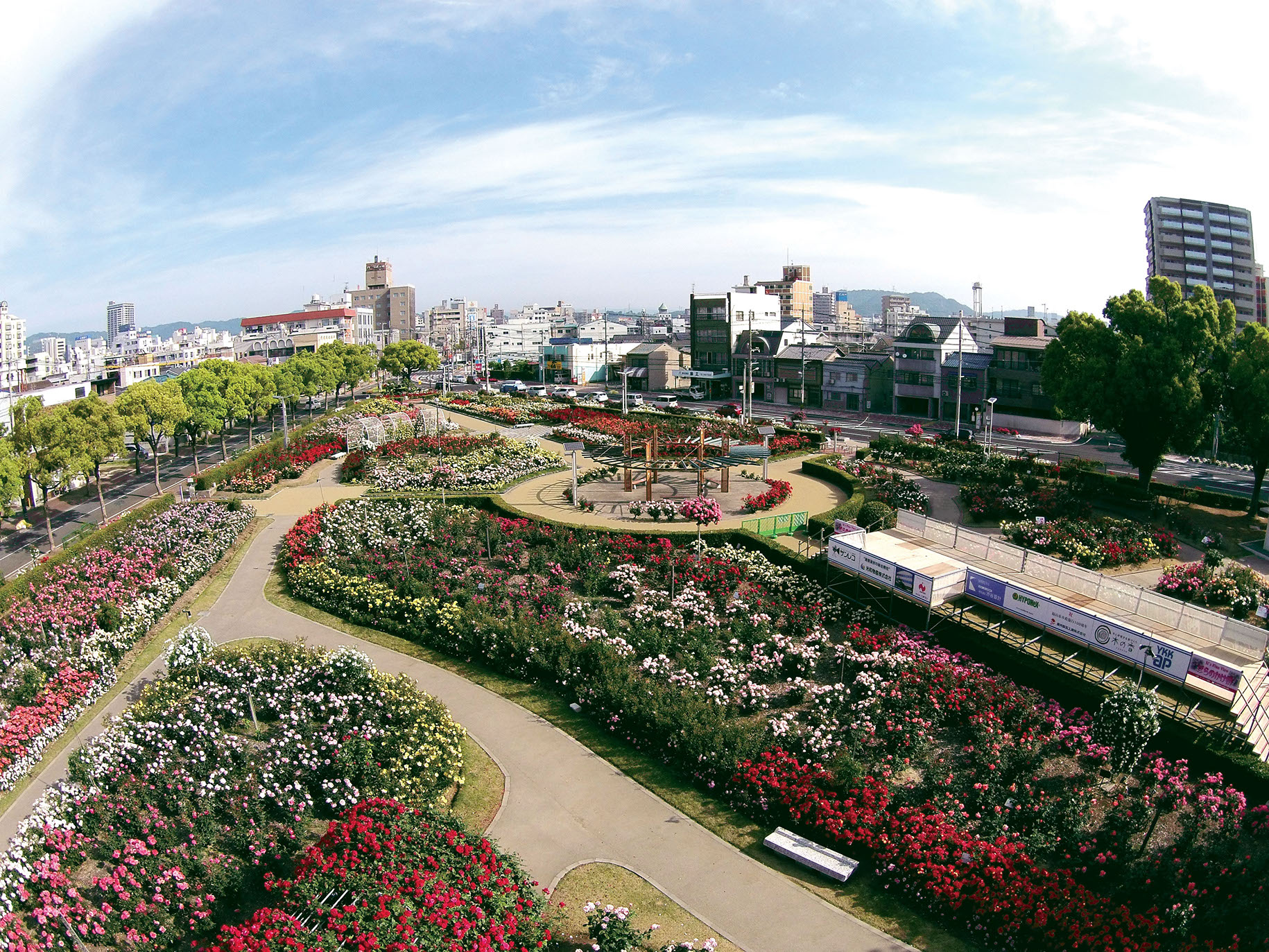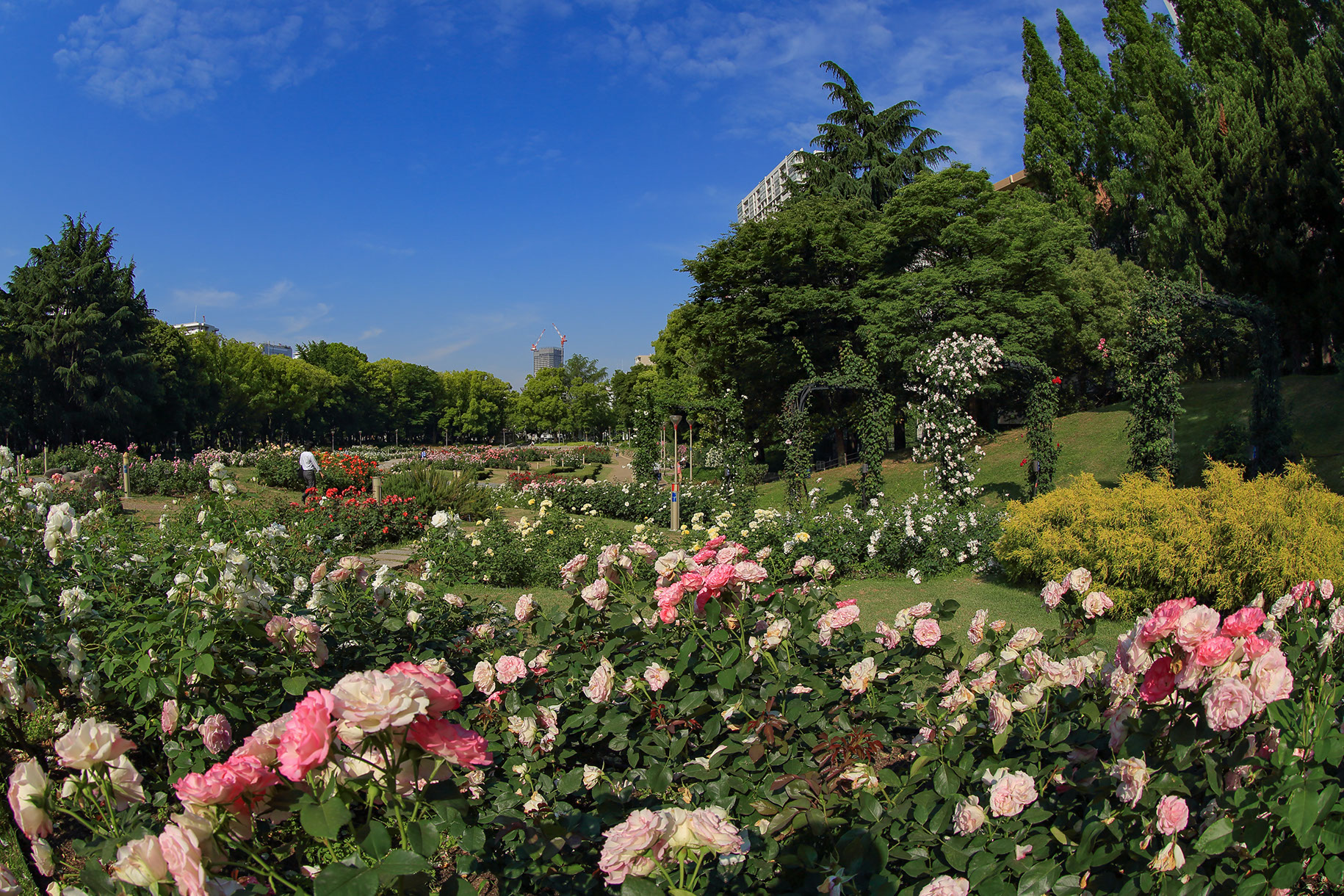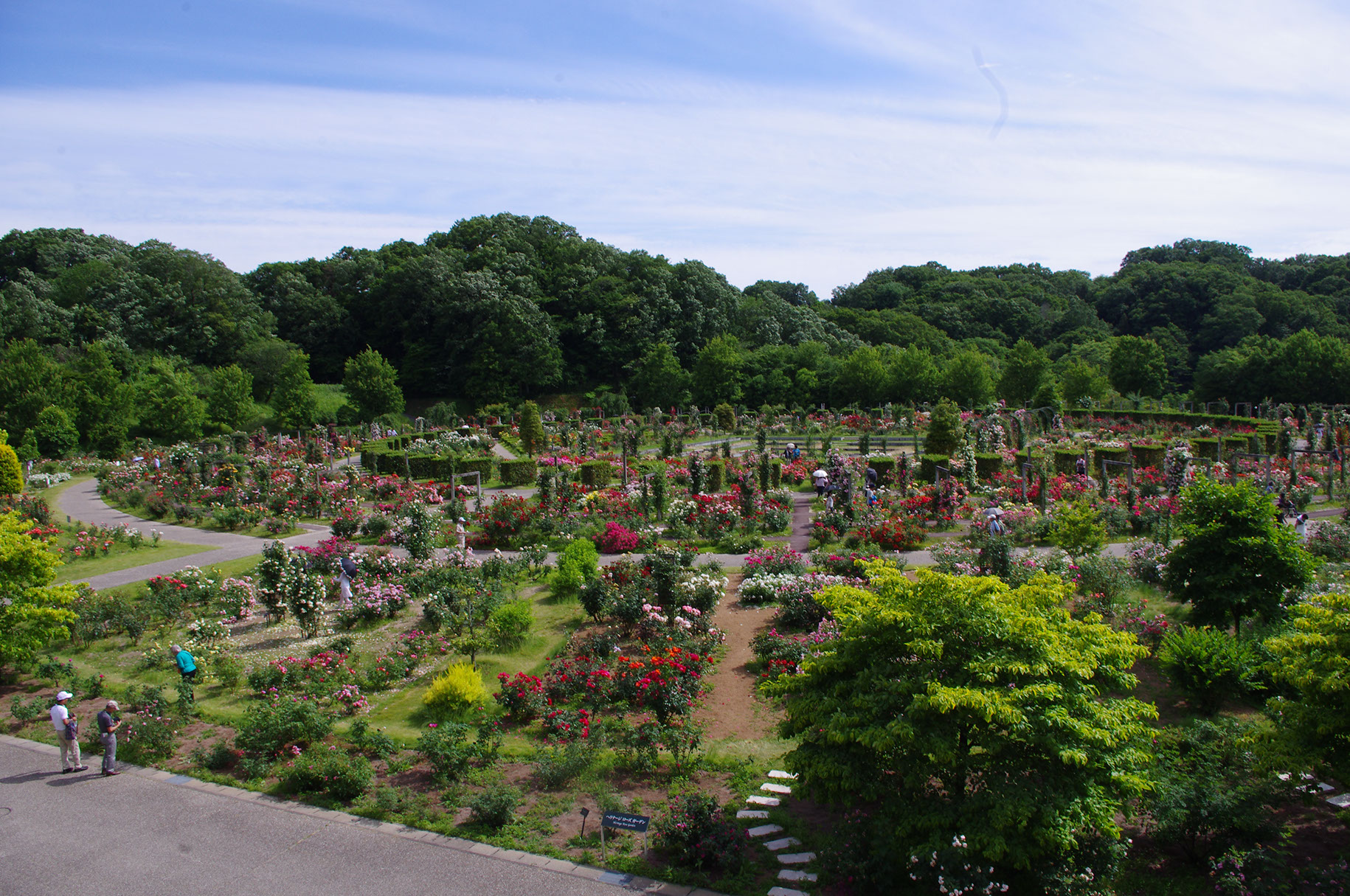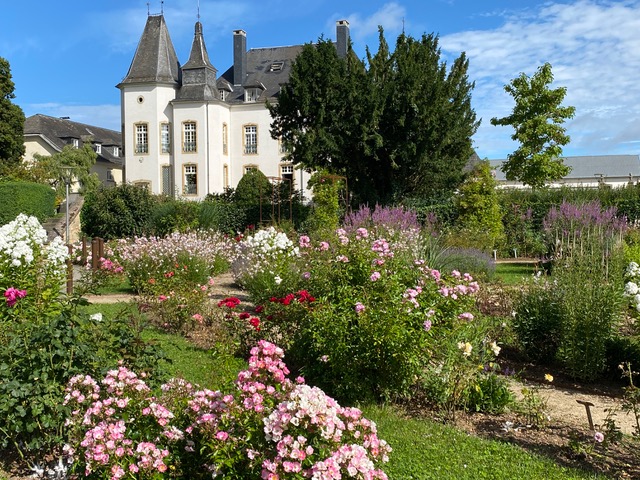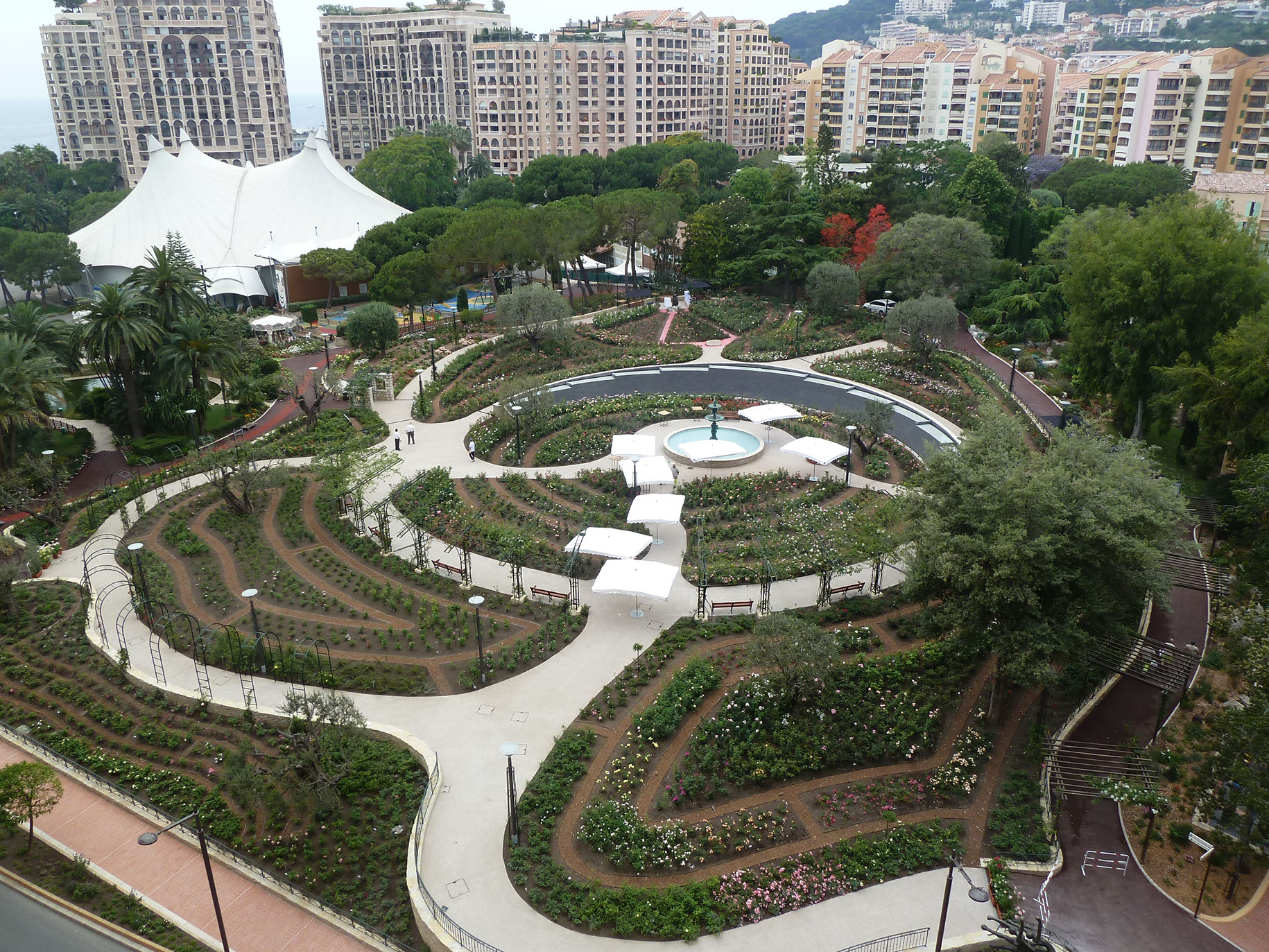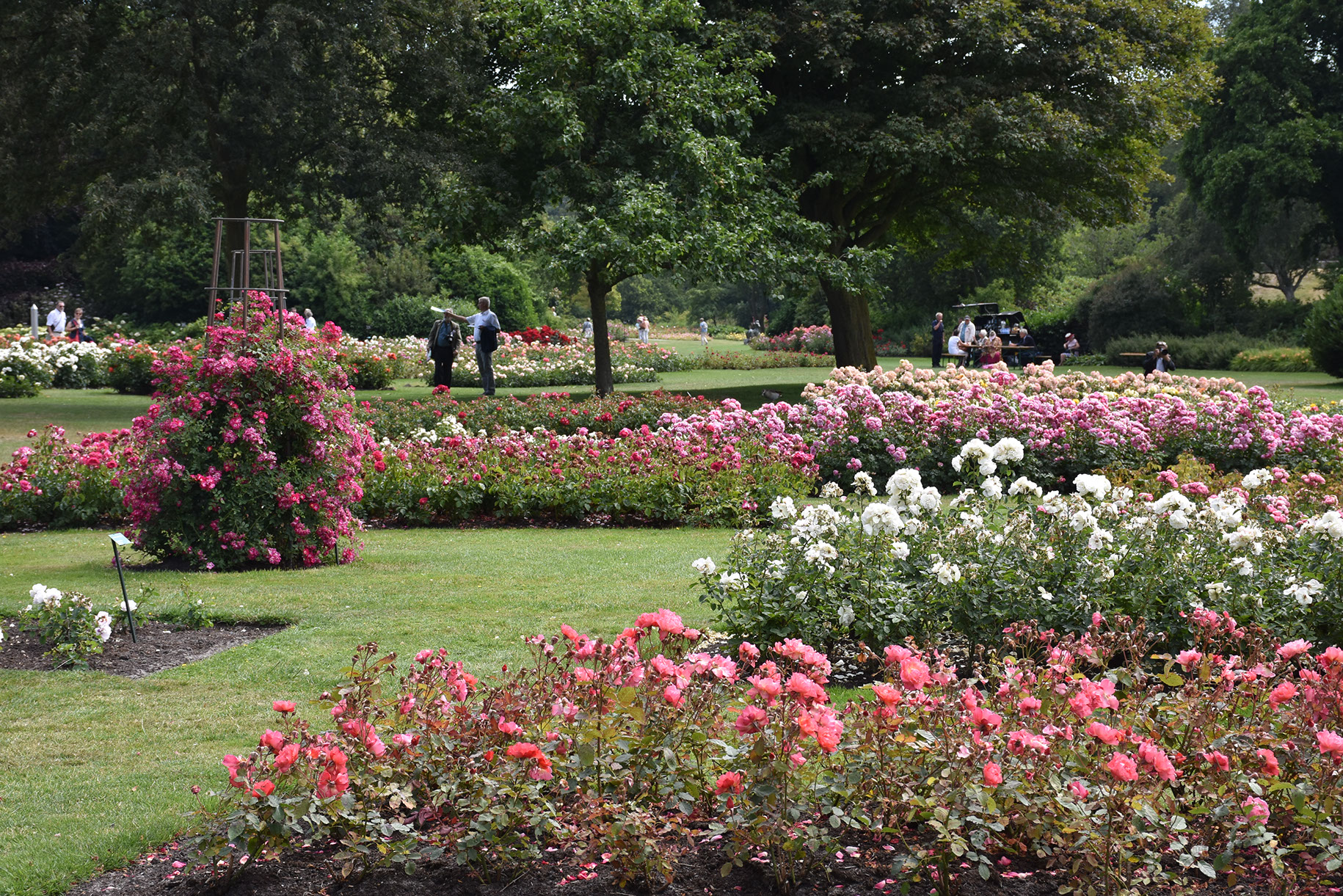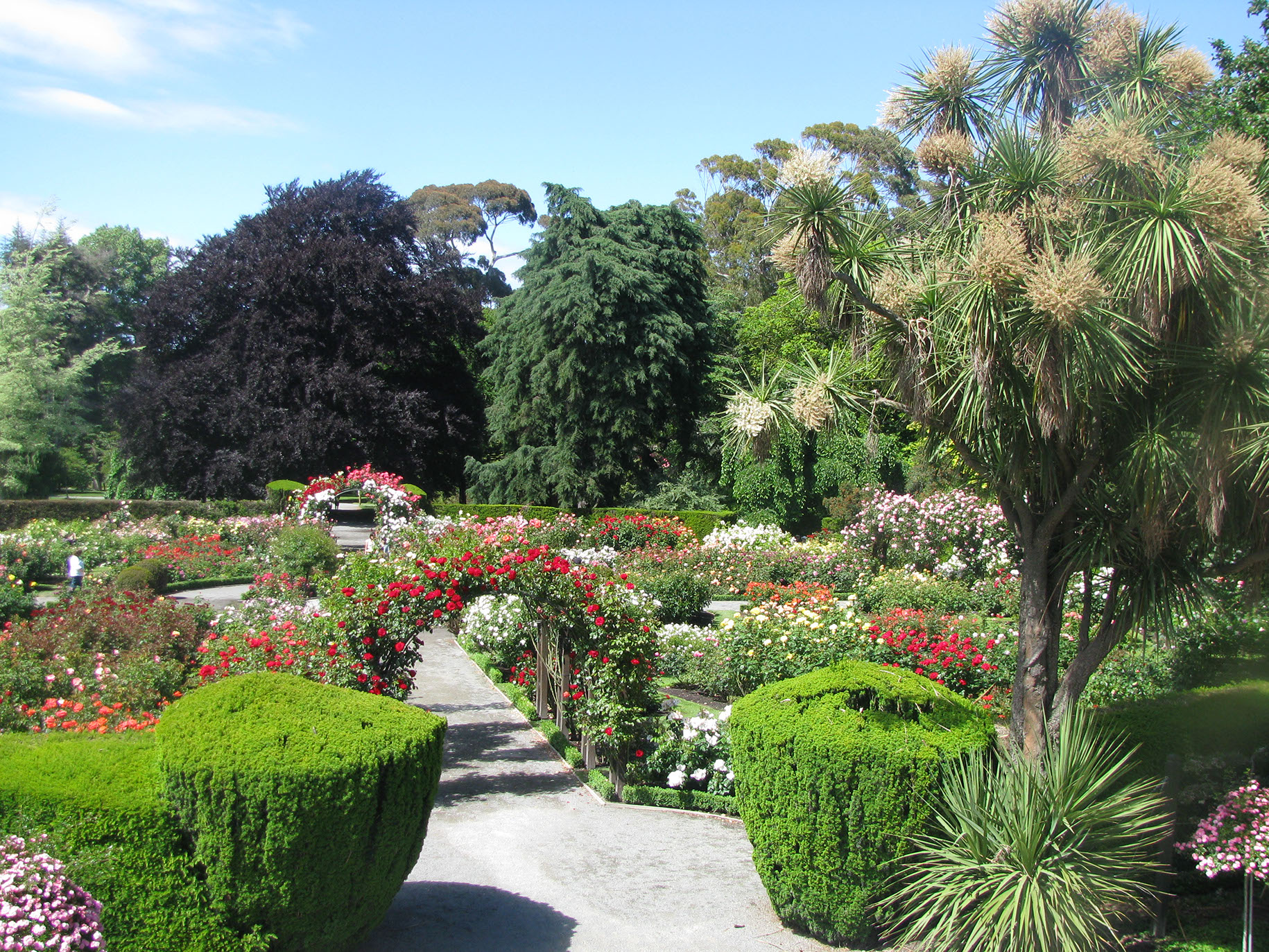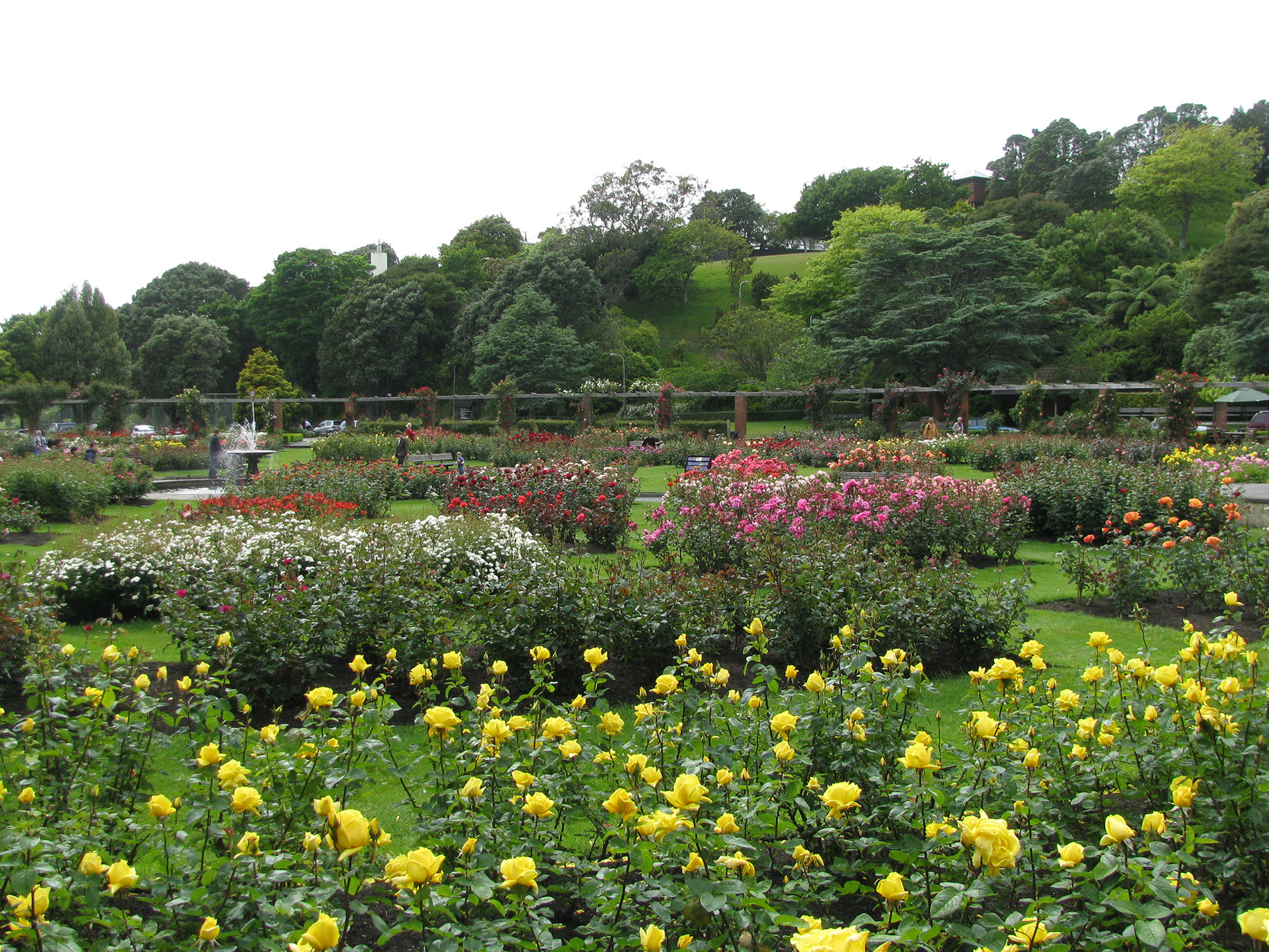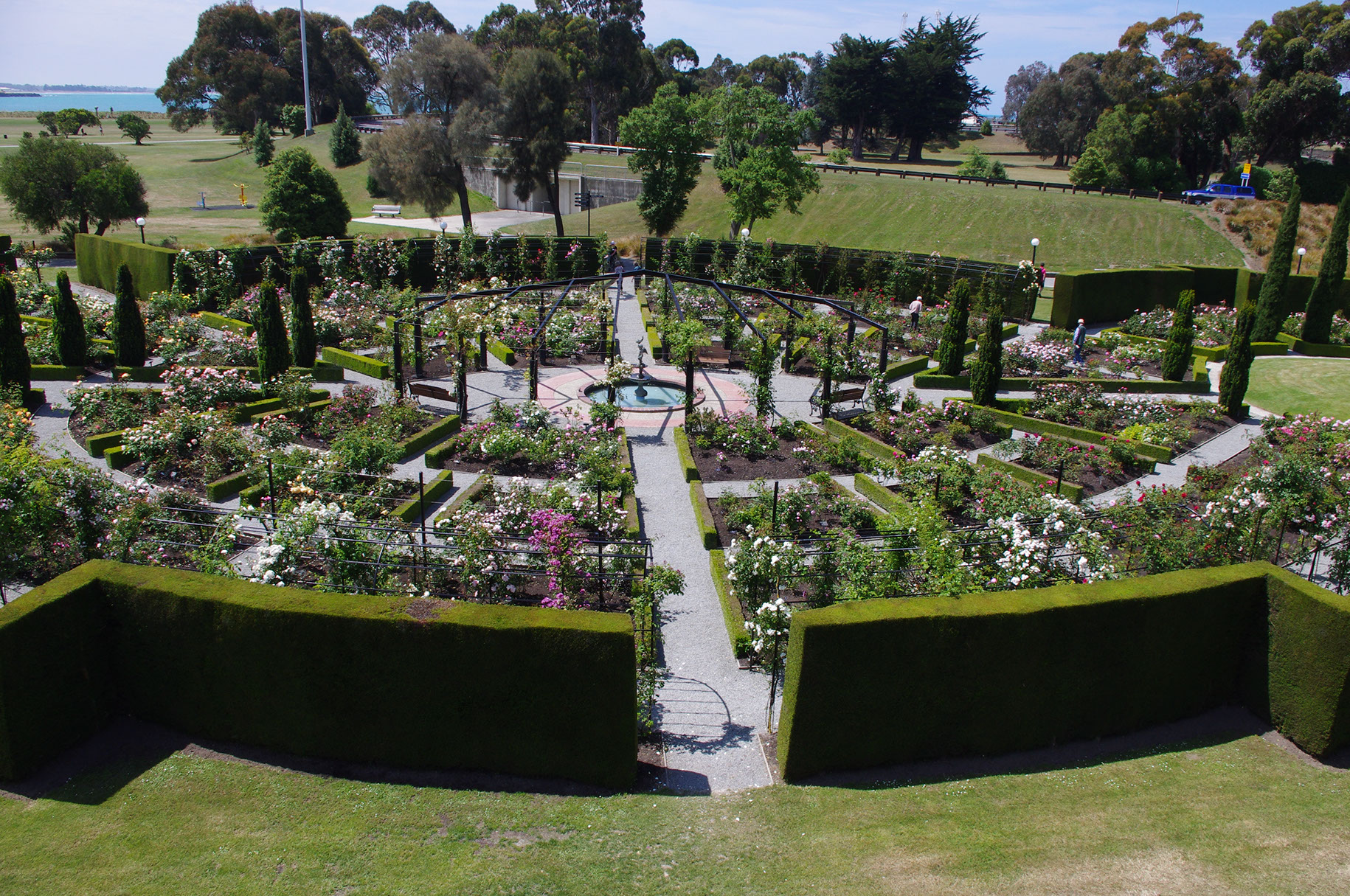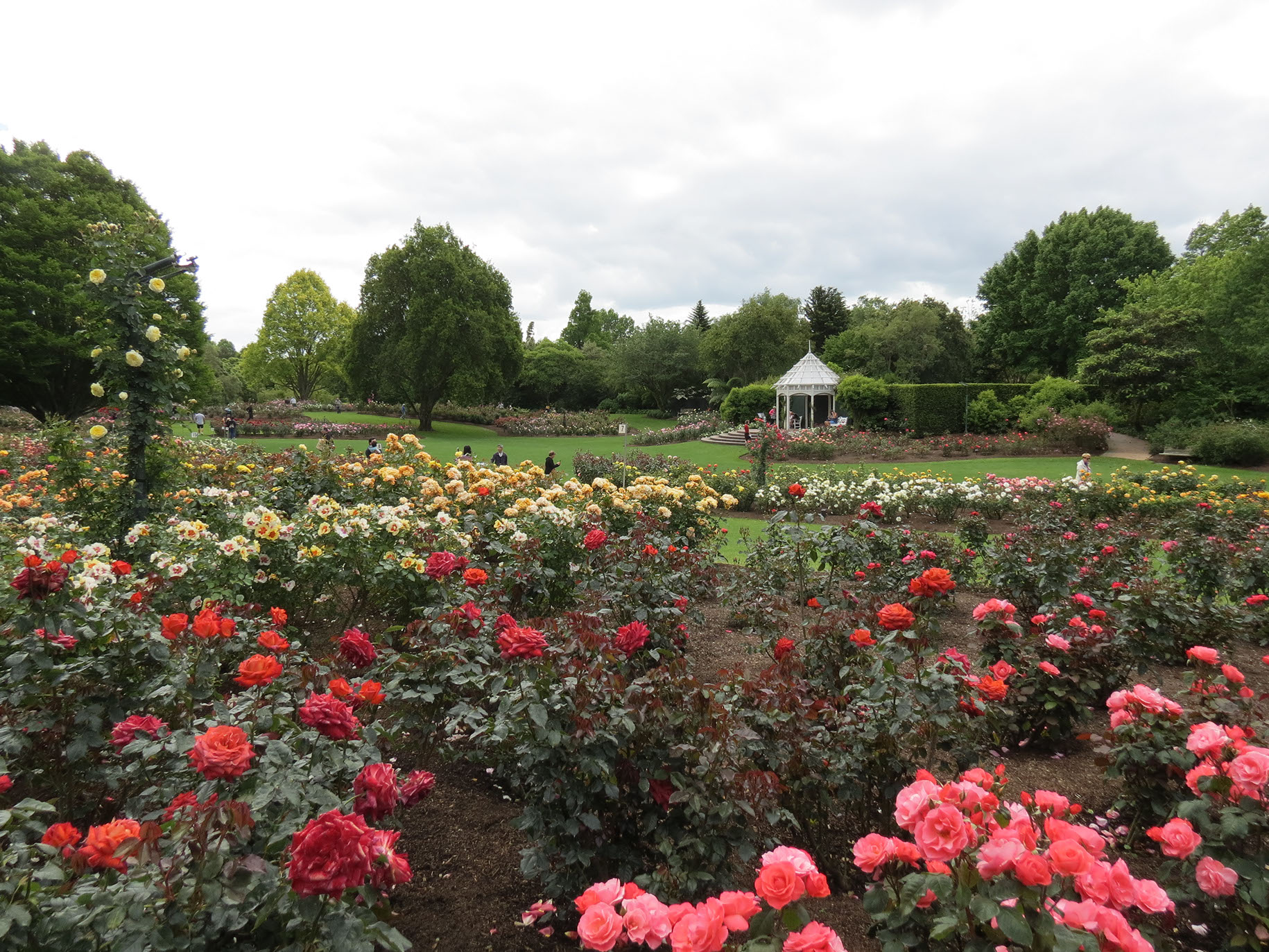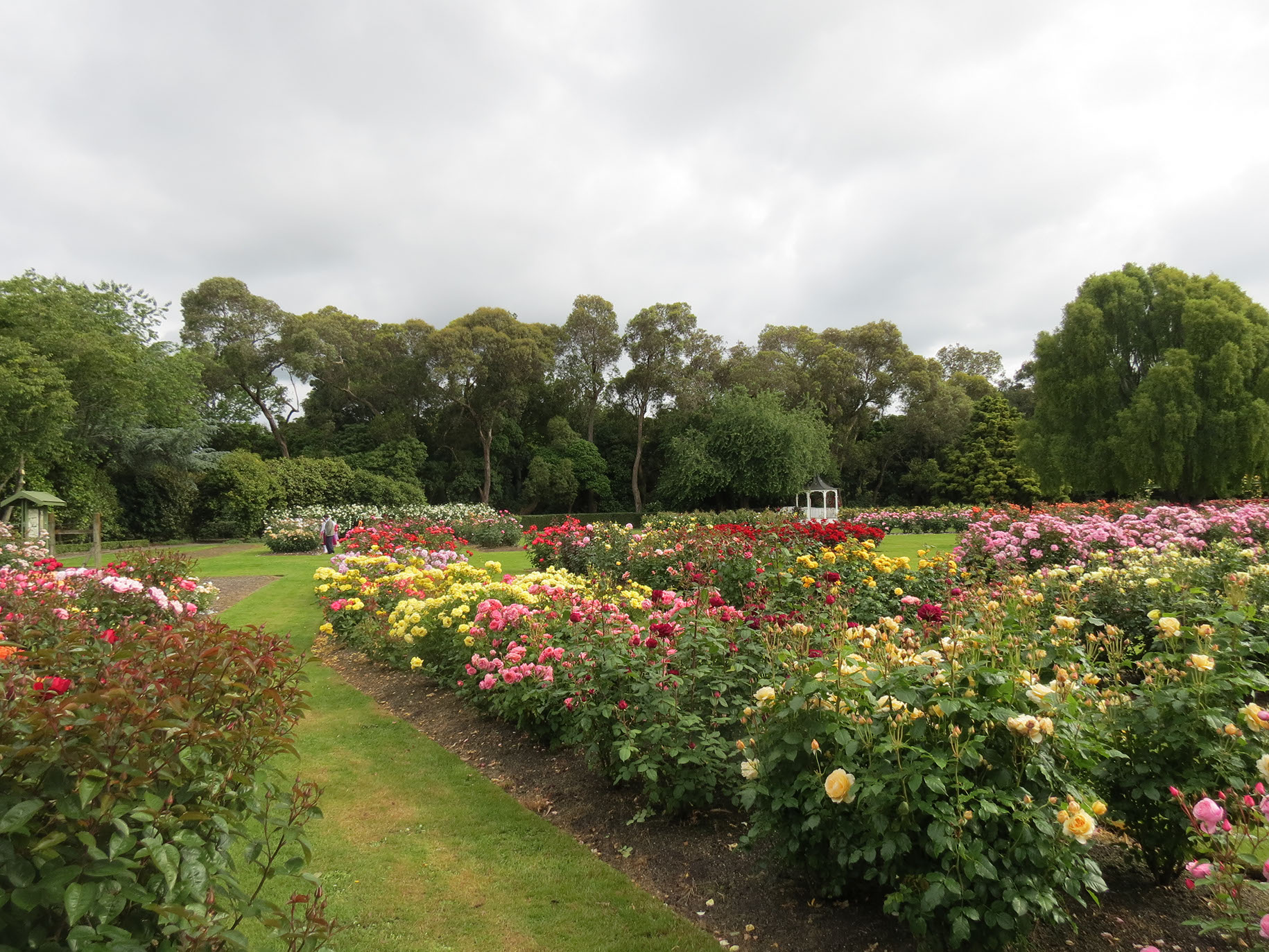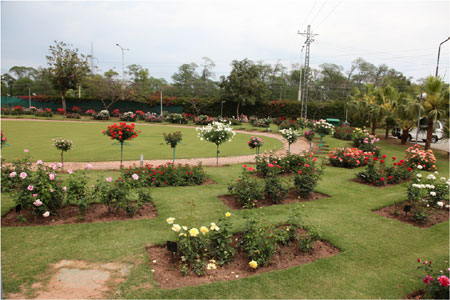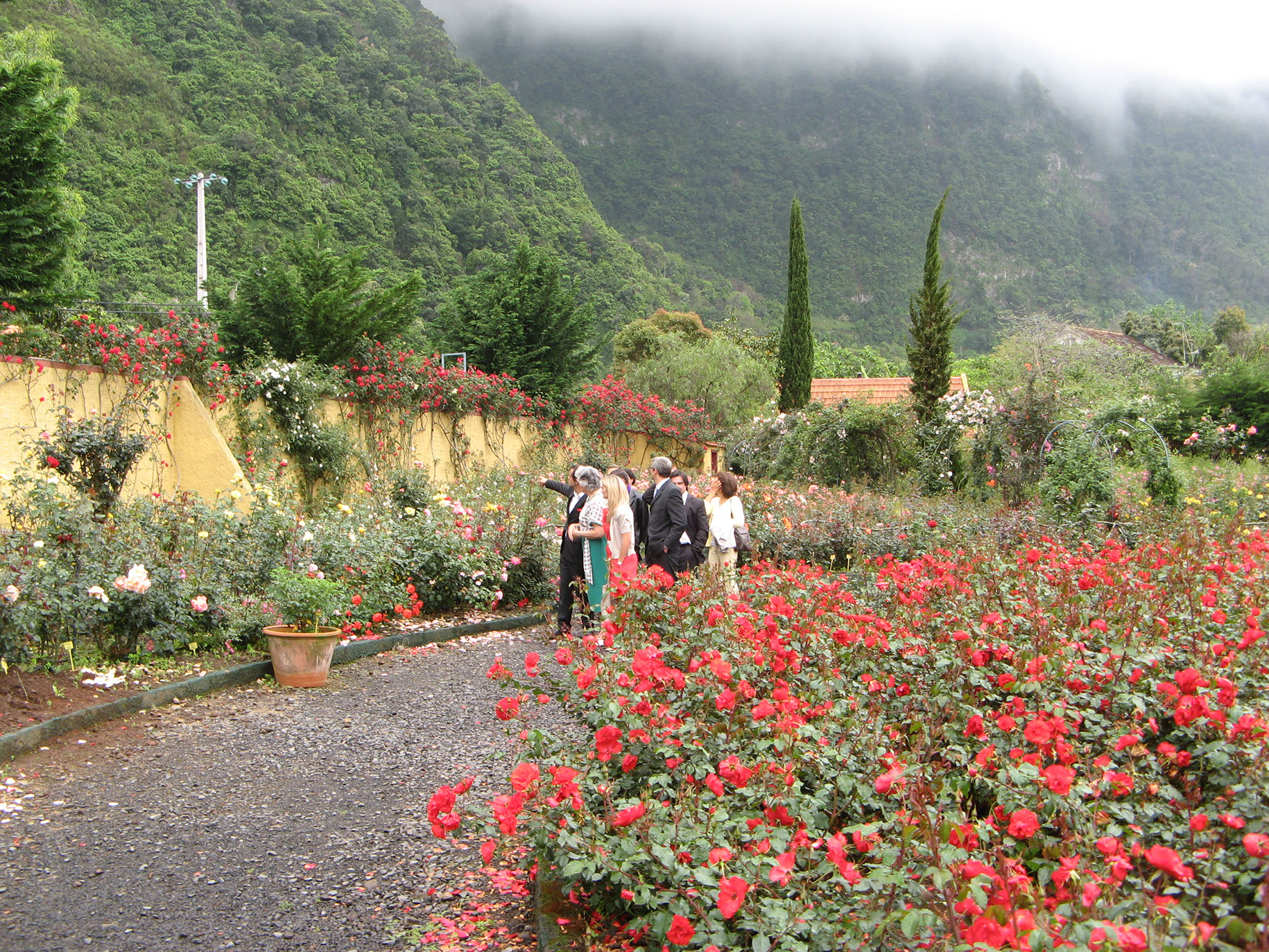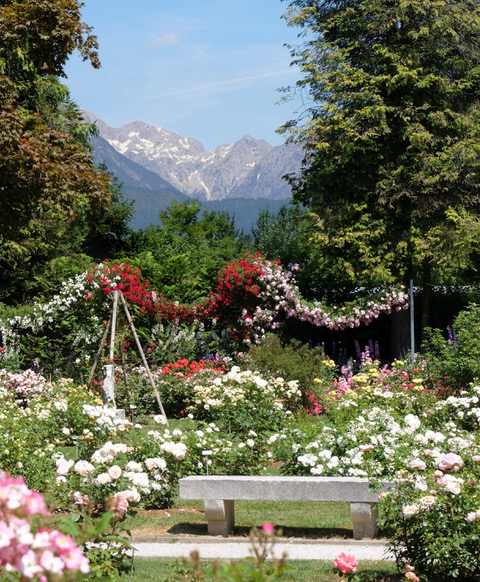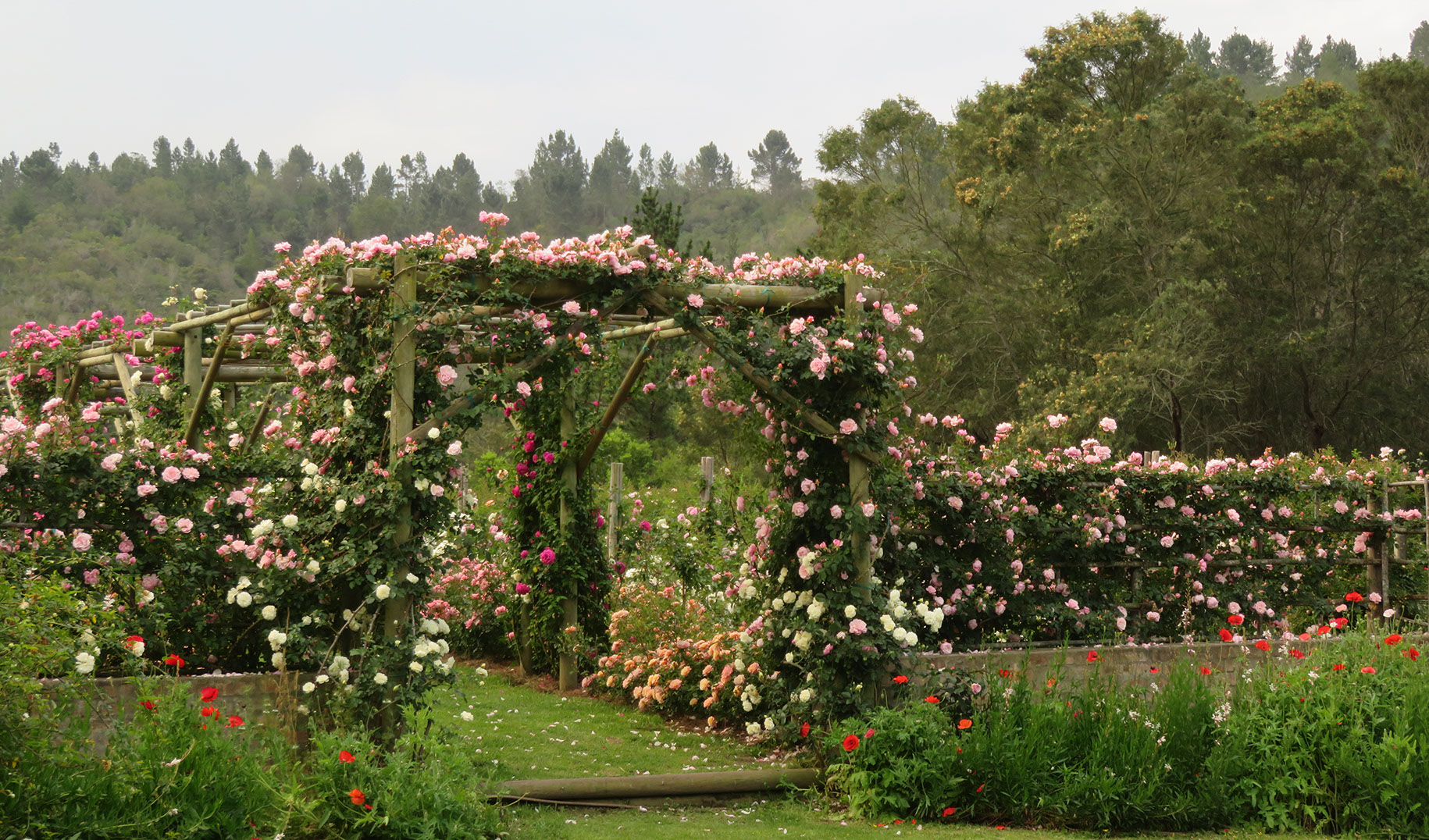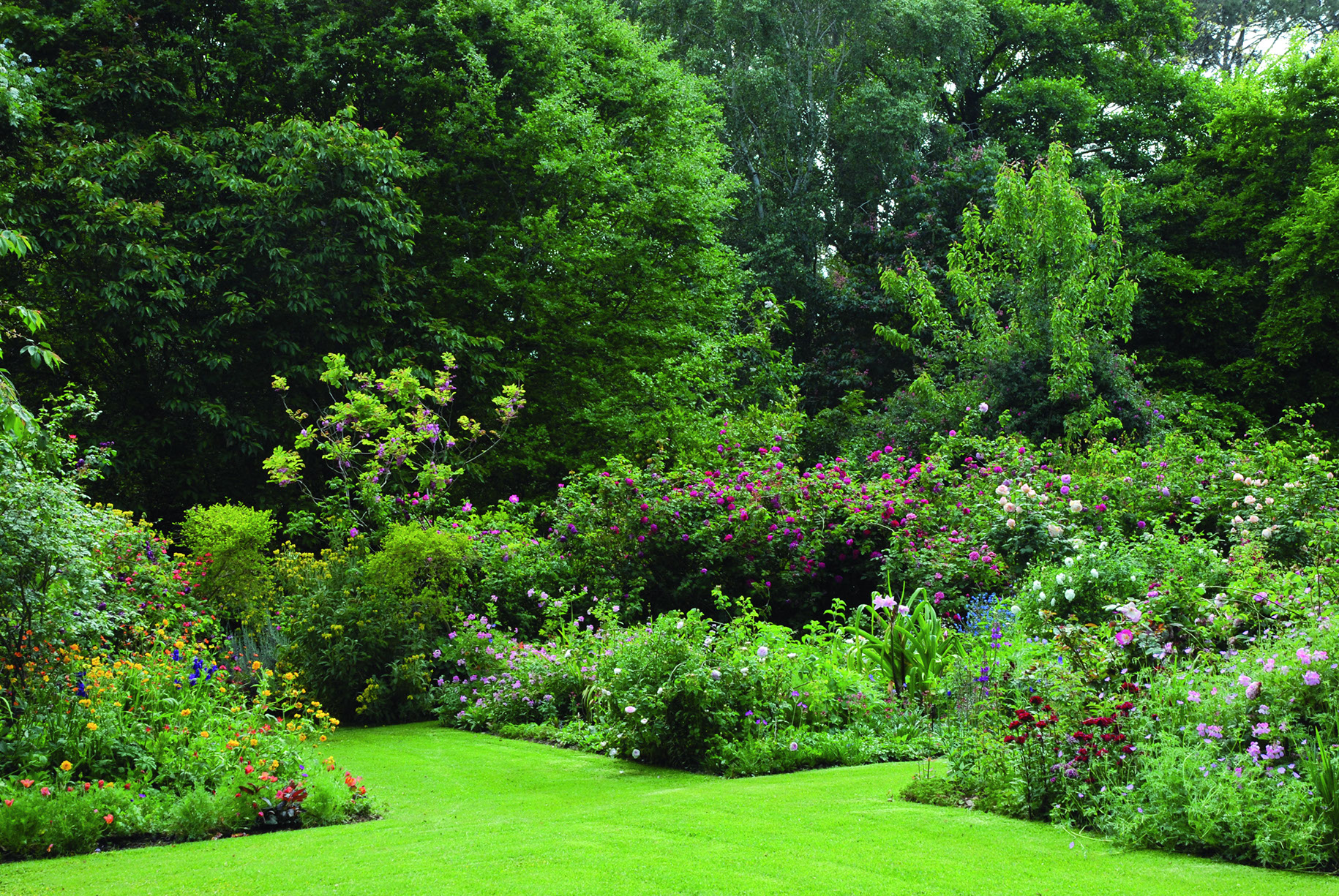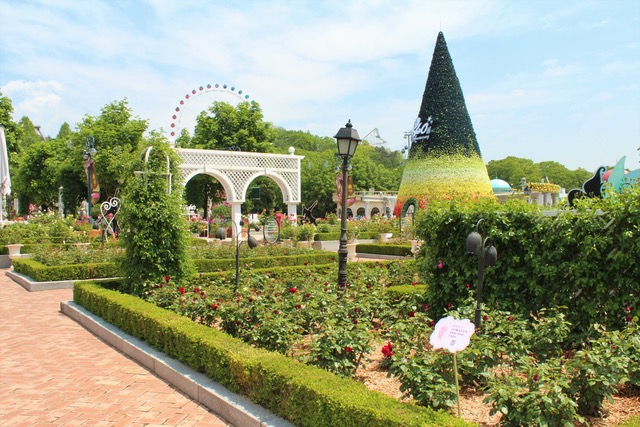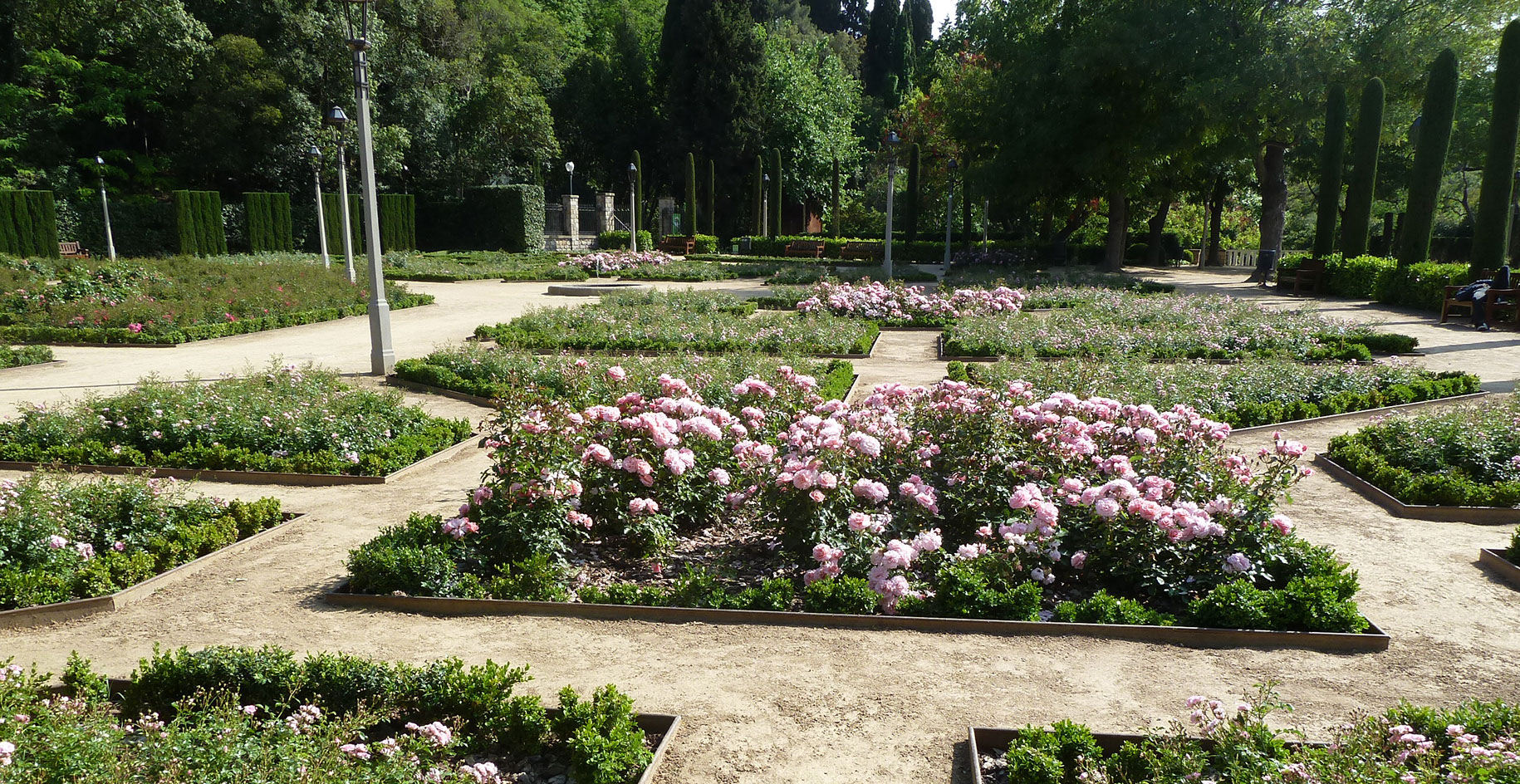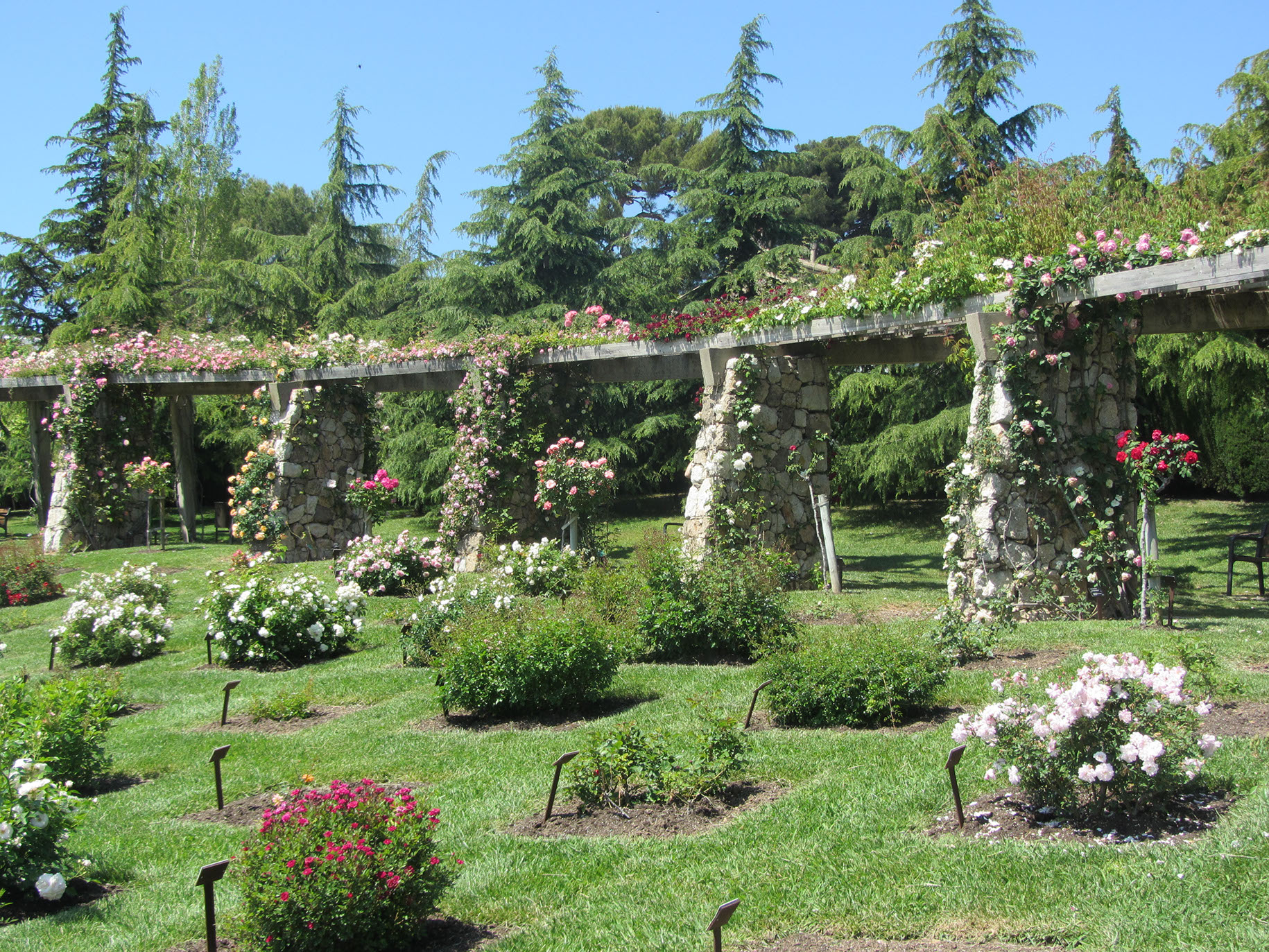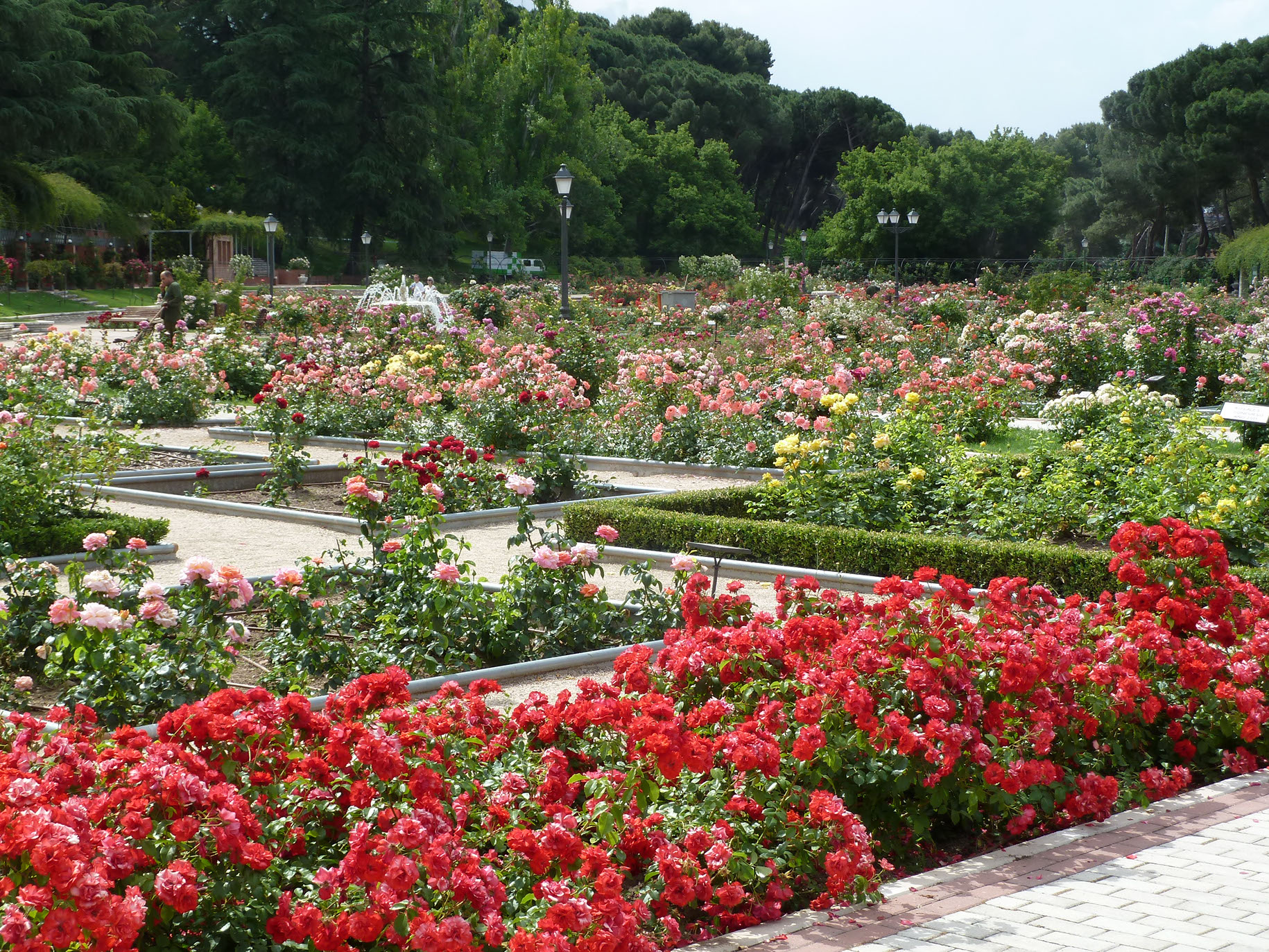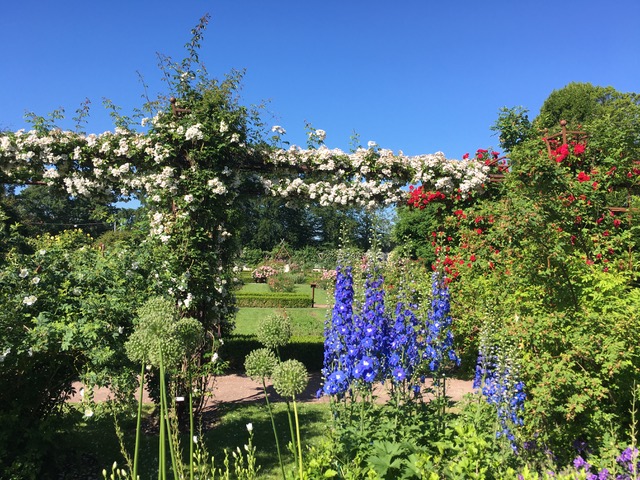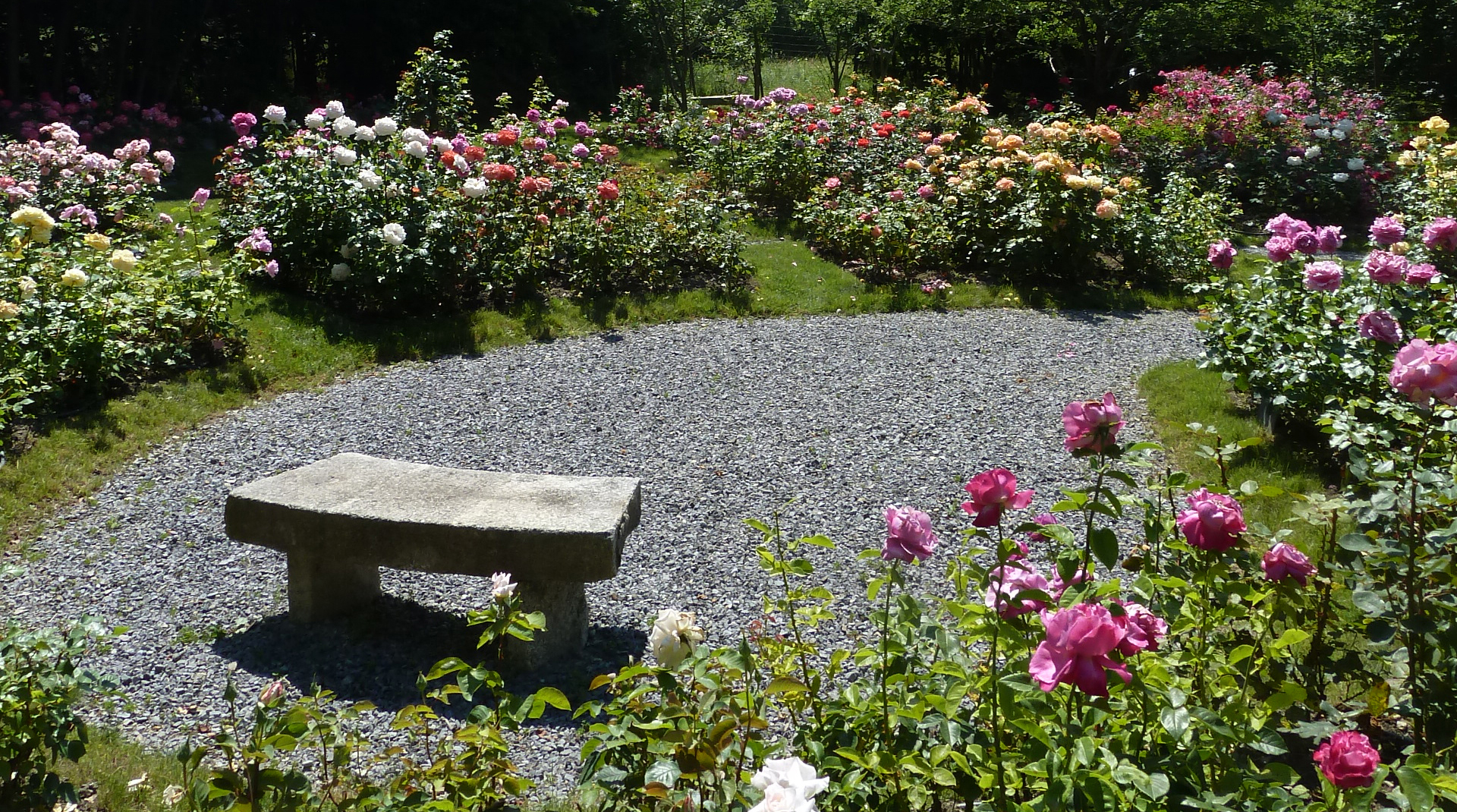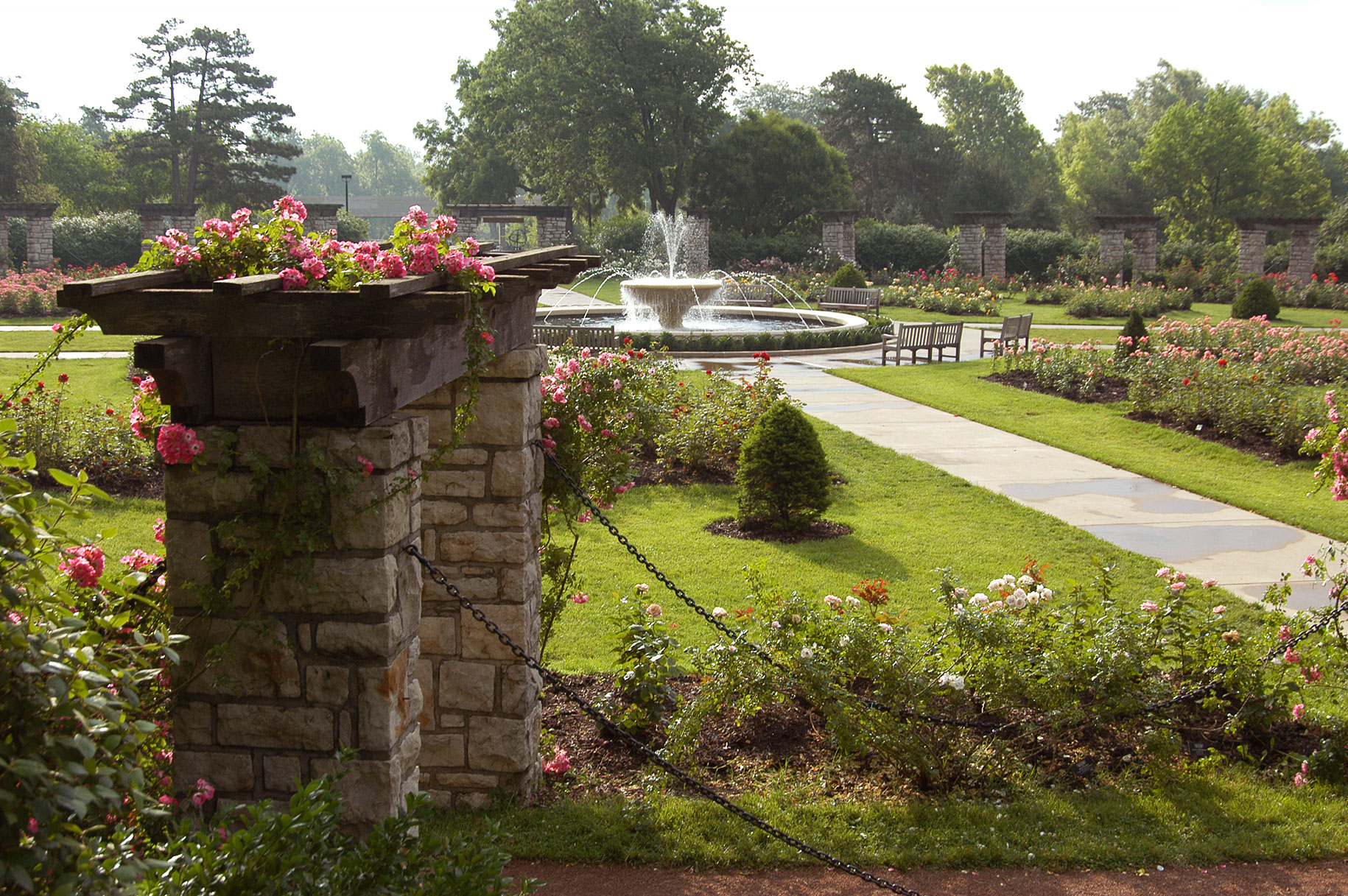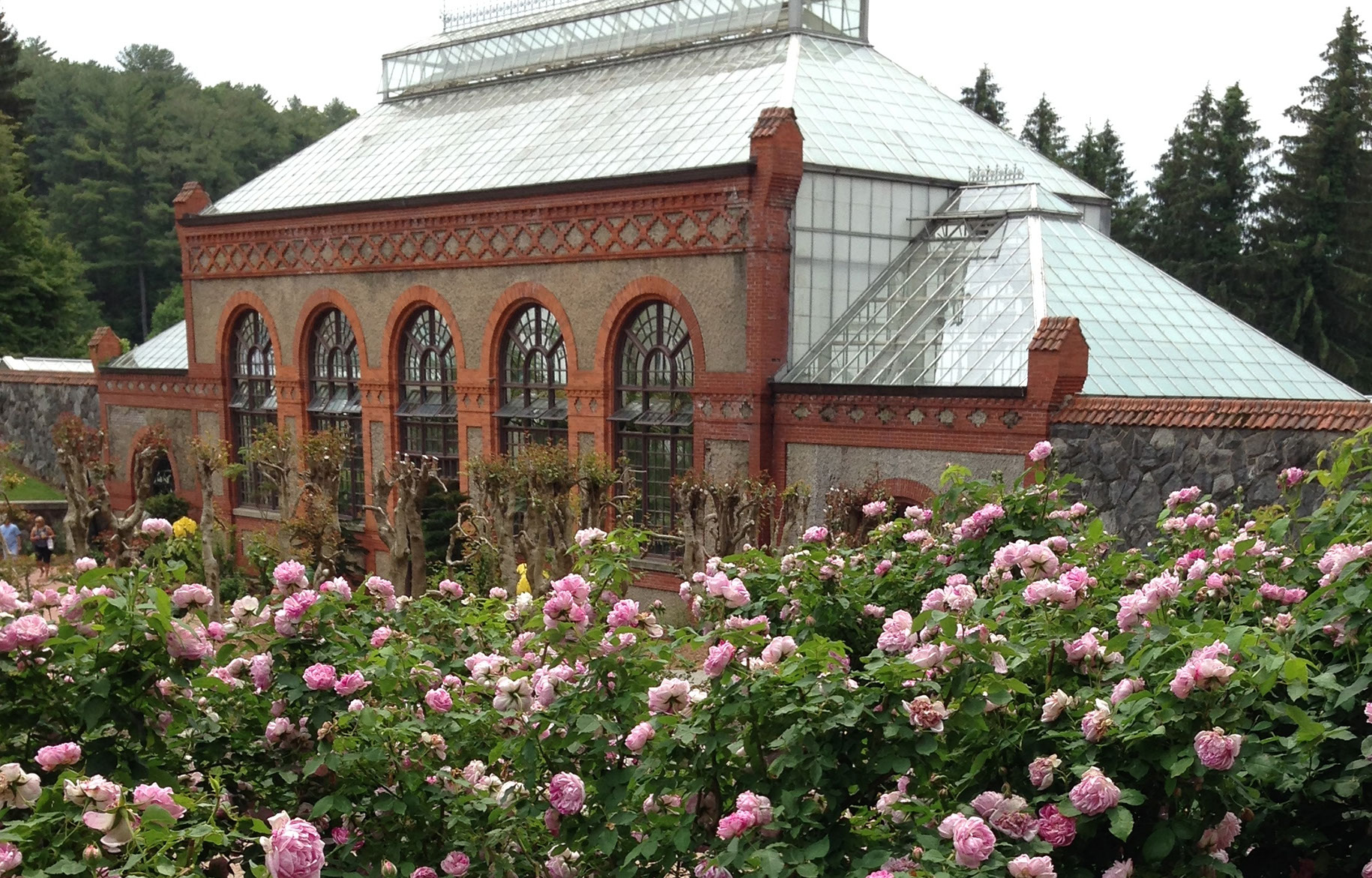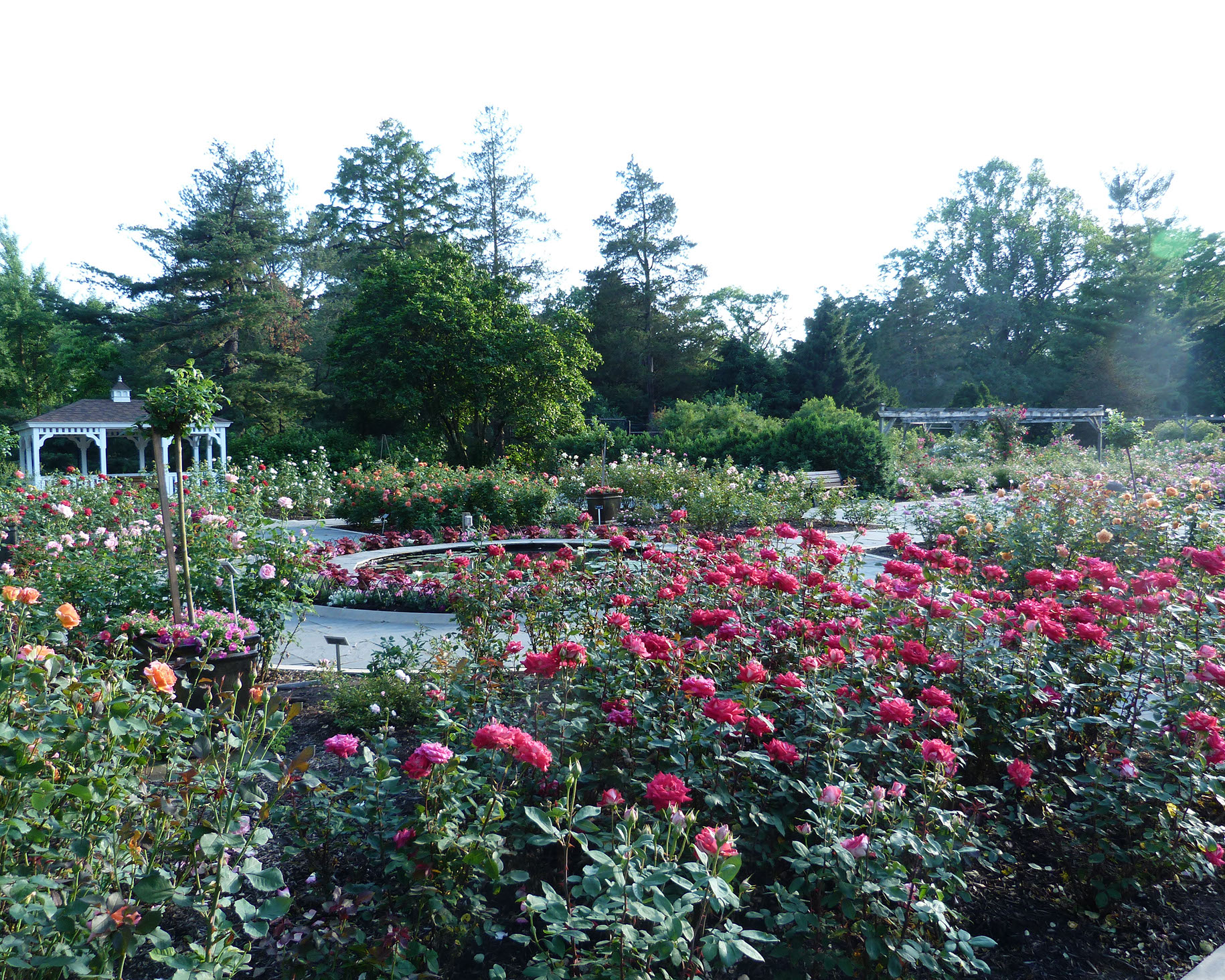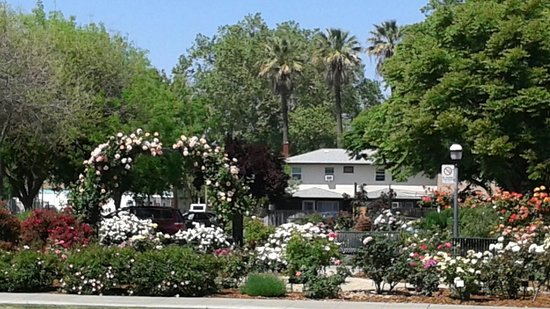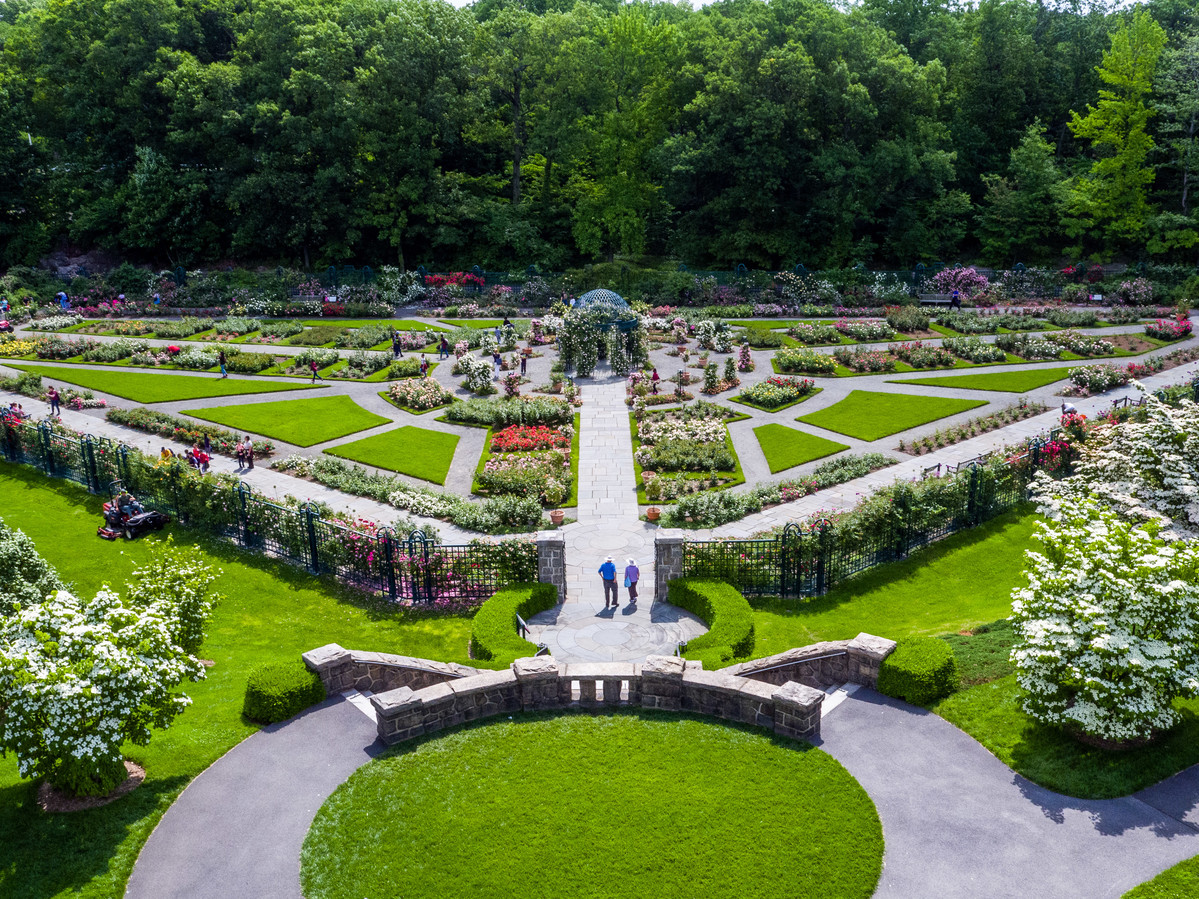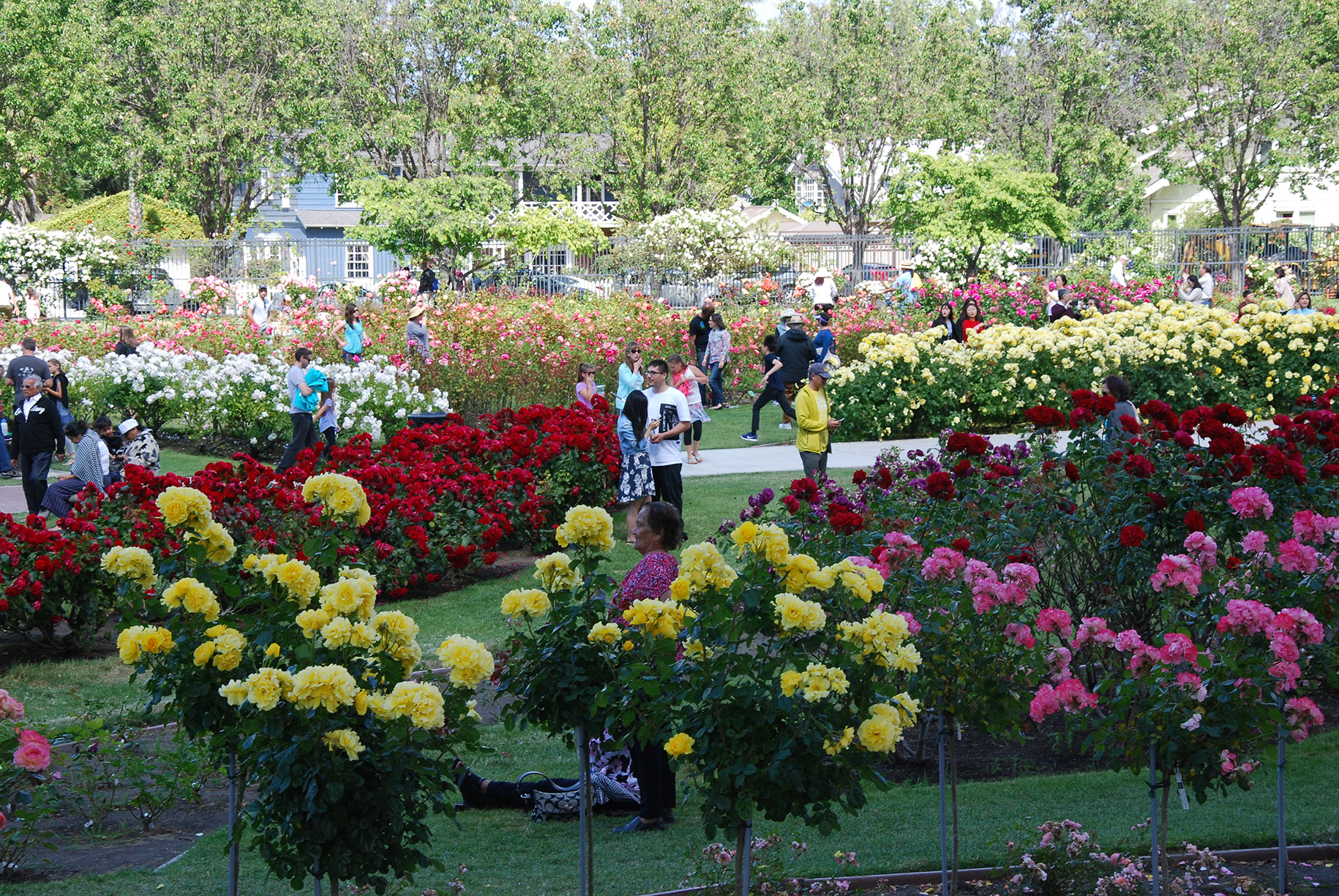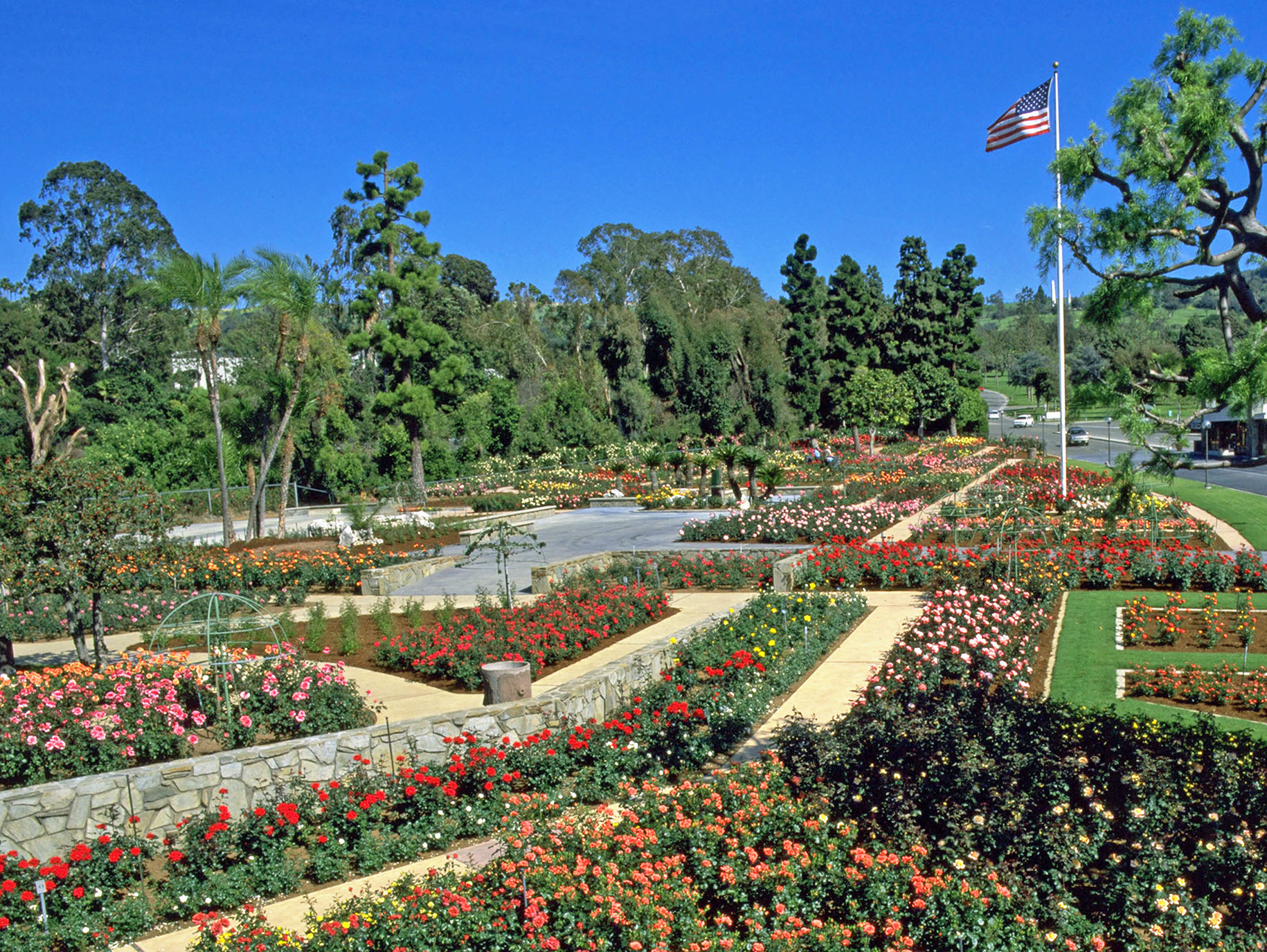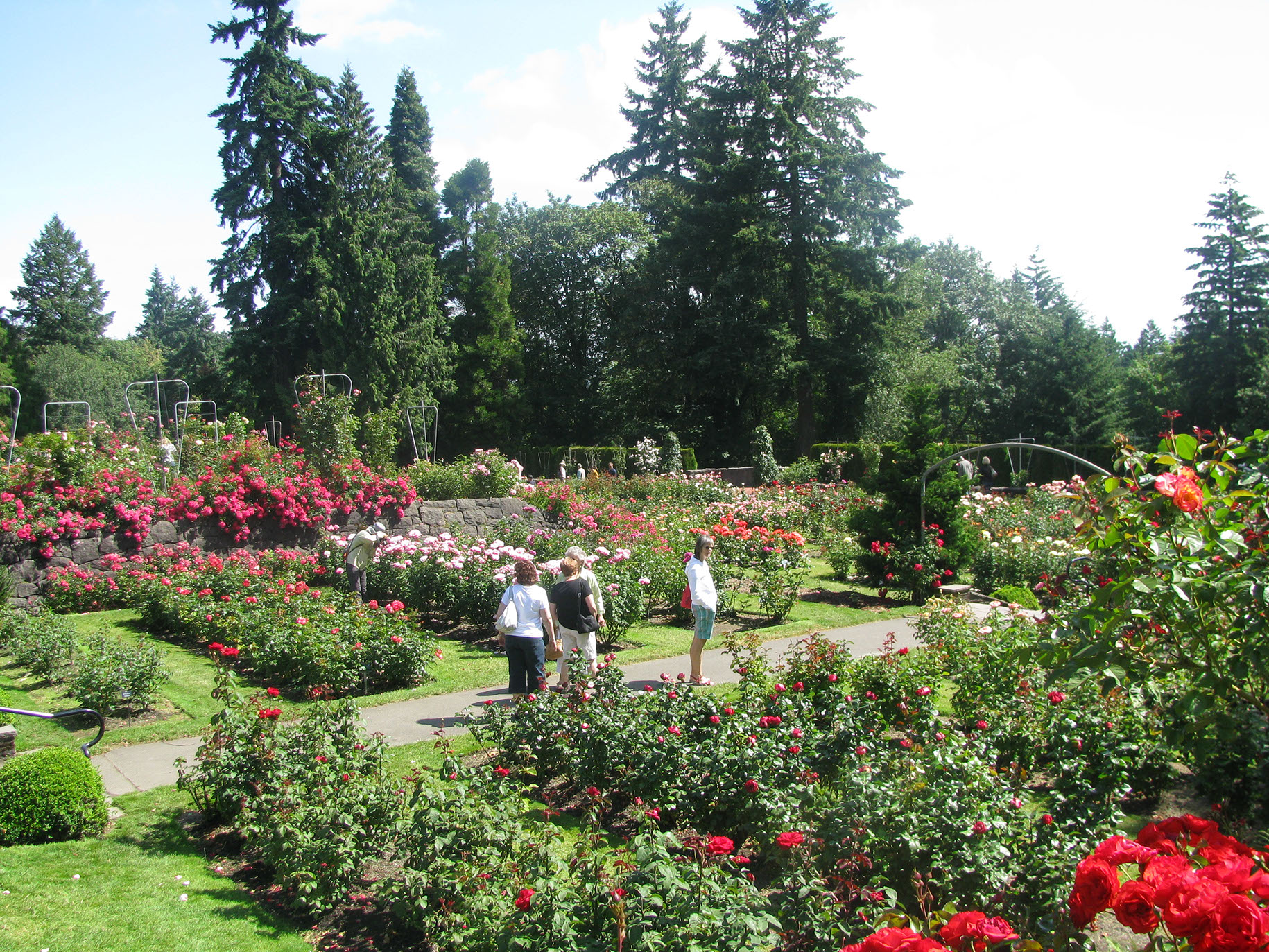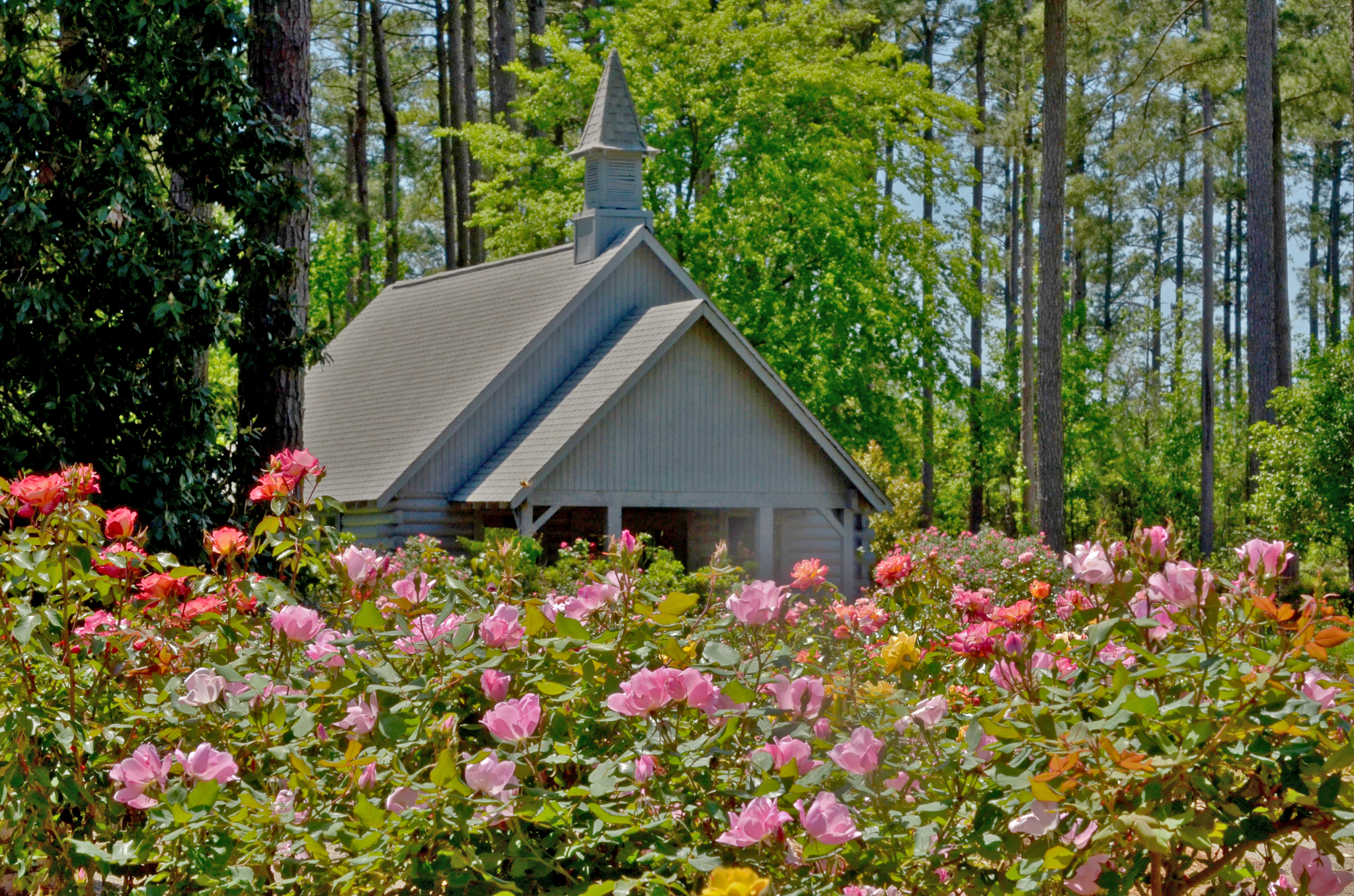
WFRS AWARD OF GARDEN EXCELLENCE
 Rosedal de Palermo
Rosedal de Palermo
Pedro Mont Ave and Infama Isabel St
Buenos Aires, Argentina
The Rosedal de Palermo is located within Parc 3 de Febrero. It was designed in 1914 and restoration on it began in 1994 with a donation of 2000 roses from Meilland of France. The International Trials for New Roses began in 2000 and the restoration was completed in 2008
Today the beds each contain hundreds of roses in a single color, from white to pink to dark red and from yellow to orange. The garden is framed by native tall trees and palms: jacarandas with their blue flowers in spring, yuchanes (chorizia insignis) with their striped flowers reminiscent of orchids and erythrinas crista-galli with their red striped blooms (our national flower) in summer. Eucalyptus give additional interest and shade to the garden.
The International Rose Garden at Adelaide Botanic Garden
Adelaide, South Australia
Entrance: Botanic Road, Plane Tree Drive, Hackney Road und Frome Road
https://botanicgardens.sa.gov.au
Established in 1867, roses have always been a feature of the Adelaide Botanic Garden. Today’s glorious collection has over 2,700 roses consisting of 350 cultivars and is a real attraction receiving over 700,000 visitors per year.
Opened in October 2000, the Internationalen Rosengarten (IRG) is maintained by the horticultural staff of the Botanic Gardens and State Herbarium, with the generous assistance of over 1,200 volunteer hours annually, provided on a weekly basis during the growing season by members of the Rose Society of South Australia to ensure the garden is maintained to the highest standard. In addition, there has been generous support from Neutrog (donating fertiliser and mulch) and rose nurseries (Knight’s Roses, Wagner’s Rose Nursery, Corporate Roses and Treloar Roses).
In 2021, the Adelaide Botanic Gardens Foundation raised and donated more than $65,000 of funding to support the upgrading of both the IRG and the National Rose Trial Garden. Revitalisation works included new plant labels, bedding identification labels, new edged paths, new trellises, hundreds of new rose plants, a fertigator, irrigation upgrades, high quality mulch and signage.
The design is deliberately sunken so as to allow a surprise element. Together with the roses, a range of unfamiliar Australian companion plants add seasonal colour. The IRG collection of roses includes Old Fashioned and Heritage roses, Modern Shrub, Hybrid Tea, Floribunda, Climbing, Polyantha, Tea, Miniature, Australian bred and landscape varieties, including Ground Cover roses. The garden also contains the National Rose Trial Garden of Australia, recognised as one of the best in the world.
The IRG is used for functions, weddings, education and horticultural training purposes with public pruning demonstrations and garden tours. It is an oasis of beautifully landscaped rose gardens, of world class standard, which is open free to the public.
The World Federation of Rose Societies presented an Award of Garden Excellence to the beautiful International Rose Garden. This is a first for South Australia and makes this garden only the fifth rose garden to achieve this award in Australia.
(Photo: ©Melanie Trimper)
 Queensland State Rose Garden
Queensland State Rose Garden
Toowoomba (nicknamed ‘The Garden City’) is a city in the Australian state of Queensland located 125 km (78 mi) west of Queensland’s capital city Brisbane by road. The Queensland State Rose Garden commenced in 1999 with a plan focused on transforming a section of Newtown Park into an International Standard Rose Garden. In 2001, the first 500 roses were planted and the garden was Official Opened. Each year the rose gardens have expanded with new beds being added. There are now 2,230 roses with 350 cultivars.
Stage 2 of the garden was opened in 2017 and included the preservation of part of the Ruston Collection. The Toowoomba Regional Council has supported the Queensland State Rose Garden in Newtown Park, building two garden beds, installing irrigation, lighting, signage and seating for this collection. 100 different varieties were included in the design including 200 plants. Preserving these varieties is essential for the overall history of the rose and its breeding and for the long term survival of this collection, both nationally and internationally.
Another garden bed forming part of stage 2 is the Frank Riethmuller collection containing ten varieties propagated by a descendant of Frank Riethmuller, an Australian rose breeder. The Alister Clark Collection also formed part of the Stage 2 development. This garden comprises a collection of 45 varieties and includes an obelisk, and a timber arbour for the taller growing roses and walk through pathways.
Maintenance: The Queensland State Rose Garden has been built to minimize maintenance and maximise efficiency. Each garden bed has pre-installed underground watering systems and heavily mulched above ground. A team of workers from the Toowoomba Regional Council Parks and Recreation Branch are assigned to maintain these gardens and The Friends of the Queensland State Rose Garden in Newtown Park also assist with ‘dead-heading’ and pruning of the roses.
Impact on the public: The hall which is called “The Rose Cottage” is used on a regular basis by Garden Groups, Darling Downs Rose Society, Toowoomba Bonsai Group, Toowoomba Floral Art Group and members of Queensland’s State Rose Garden in Newtown Park Toowoomba. The public also hire the hall for private functions. A range of seating choices have been strategically placed throughout the park to maximise viewing and general enjoyment of the different varieties of roses. Open and covered seating options are available to accommodate visitors during all weather conditions. Facilities to improve public convenience have recently been constructed ie. Carpark, Barbeques, Toilets and a Wedding Gazebo. The Wedding Gazebo is used by families to celebrate special occasions. Barbecues, tables and seating are scattered throughout the Queensland State Rose Garden for community use. Many different events are held at the garden, where everyone is welcome to participate or simply take time to enjoy the roses. Events such as Weddings, High Teas, Mother’s Day & Father’s Day BBQ’s, Live music shows, Fashion Parades, Fairies in the Park, Community Events ie ANZAC Day Services, Rose Garden Dinners and Birthday Parties are events regularly held at the Rose Garden.
Education: Regular classes are held at the Queensland State Rose Garden for the community to attend. These classes educate the public in correct pruning techniques and how to care for their own roses, producing the best possible plants. Tours of the Queensland State Rose Garden are led by The Friends of the Queensland State Rose Garden in Newtown Park.
Rose Trials: The Queensland State Rose Garden rose trials are the only trials in Australia outside of Adelaide. There is a team of competent assessors who assess each plant, twelve times over the two years. The plants are scored according to specific criteria. In 2017 3 new rose beds were established to house any gold medal winners from the Australian bred roses, demonstrating the strong commitment the garden has in the development of rose breeding in Australia.
(Photo: Paul Hains)
 Mornington Botanical Rose Gardens
Mornington Botanical Rose Gardens
Corner of Dunns Road & Mornington-Tyabb Road
Mornington, Victoria 3931
Australia
https://morningtonrosegardens.com.au/
The Mornington Botanical Rose Gardens is a colourful, well laid out rose garden situated about 60 kilometres south of Melbourne. It features 4000 rose plants comprising 250 varieties creating a beautiful setting on 1.6 hectares, and it’s open to the public every day. The garden’s perimeter is “walled” by native plants and roses of various heights, providing some wind protection but the roses are still visible by passing traffic. This garden received a 2015 WFRS Garden of Excellence Award in Lyon.
As it is near the sea, it was designed in the form of a yacht, with sail, mast and waves. Work commenced in 2004 and the garden was officially opened in 2008. Since then a viewing platform, a fountain, lily pond and Heritage rose collection have been added. The Garden Room works well as a multi-function building.
The Mornington Botanical Rose Gardens is a rose garden “of and for the people” – designed, developed and now maintained by volunteers. A community garden such as this is only as good as its volunteer workers. It is a good sign that the garden continues to grow and so does the membership. Recently the local secondary school was approached for volunteers to work with the group. Two students took up the challenge – this shares the work load and may lead to some long term members!
(Photo: Paul Hains)
 Morwell Centenary Rose Garden
Morwell Centenary Rose Garden
Norman Sharpe Reserve
Commercial Road
Morwell, Victoria, Australia
info@morwellrosegarden.com.au
www.morwellrosegarden.com.au
The Morwell Centenary Rose Garden is located 150km east of Melbourne, in the Latrobe Valley, at Morwell in the State of Victoria. It was the second garden in Australia to be recognised with a WFRS Award of Garden Excellence which was presented in 2009.
The garden was planted to celebrate the centenary of Morwell and opened in 1992. The site chosen was the Norman Sharpe Reserve, a disused railway cutting that had become neglected land. This community project continues to be developed by the “Friends of the Rose Garden” volunteers and sponsors with the generous support and assistance of Latrobe City Council. This is an outstanding example of what a community can achieve with vision, dedication and hard work.
Today the 1.6 hectare rose-filled parkland features 110 garden beds with over 3,500 rose plants, comprising 400 different varieties, representing modern Hybrid Teas, Floribundas, Shrub Roses and old world favourites. In addition, the rose-theme continued with roses planted in various locations around the town.
The garden features a number of significant structures that enhance and complement the roses, including a central gazebo summer house, a pergola, tall decorative climbing frames, rose covered towers and archways. Pathways meander through the garden leading to a large tubular arbour planted with pillar and bedding roses to create a beautiful and abundant display of blooms.
In 1994 an Australian and New Zealand Rose Breeders section was planted at the southern end of the garden. One of the few public displays of its kind in Australia, it contains both historical and modern roses. In particular, the area showcases many of the roses bred by the early and contemporary Victorian rose breeders with emphasis on roses from Australia’s most famous pioneer rose breeder, Alister Clark.
The garden shows roses in all types of landscaping situations including massed beds, roses featured on climbing frames, hung on arches, in median strips and mixed beds with cottage plants and fragrant shrubs to create a haven for all who visit.
 Victoria State Rose Garden
Victoria State Rose Garden
P.O. 2137 Werribee
Victoria, Australia 3030
https://vicstaterosegarden.com.au
The State Rose Garden, west of Melbourne at Werribee, in the State of Victoria, Australia, was officially opened in 1986 and was the first to receive a WFRS Award of Garden Excellence in 2003 for its unique design, size and beauty. It is regarded as the premier rose garden of its type in Australia. The 4.4 hectare garden contains over 5,000 roses in garden beds in the shape of a Tudor Rose, Leaf, Bud and Heritage Border.
The Tudor rose design features Hybrid Teas, Floribundas, Ramblers and Climbers on trellises, tripods and swags. The Federation leaf features Australian bred roses and a donation from David Austin Roses in 2000 added English Shrub roses into a bed shaped like a rose bud. The Heritage border features 500 roses of 250 varieties of Old Garden Roses including a few species.
The original idea for the rose garden came about when the Victorian State Government promoted itself as ‘The Garden State”. When Govt. budget-cuts threatened the viability of the garden, the public showed that there was sufficient interest from volunteers to take on much of the maintenance work. The volunteers work with management to ensure the garden is maintained to a very high standard and this continues today.
(Photo: ©Melanie Trimper)
 Rosarium Baden Doblhoffpark
Rosarium Baden Doblhoffpark
Baden bei Wien, near Vienna, Austria
The relationship with roses in the city of Baden near Vienna can be traced back until 1830. An archduke of the castle of “Weilburg” was engaged with the cultivation of roses. In a publication of 1856 this garden was named as the largest rose garden with 1,800 species in Middle Europe.
Therefore an idea was born to build a rose garden in Baden. This rose garden was inaugurated July 121h 1969, in the so called Doblhoffpark, in the garden of the castle “Weikersdorf’ which was first mentioned in 1233.
In the 19th century the park was created as an English landscape garden in the eastern part. The other part is a typically French garden styled with an axis between the orangery and a fountain at the opposite site.
1830 the park was opened to the public. Since the nineteen-twenties the park was changing to an amusement park. Years later the park broke down until the idea was born to establish a rose garden.
The park has an area of more than 70,000 square metres, with a stock of about 30,000 roses, with more than 800 species. You will also find a lot of interesting trees like Poncirus trifoliata, Catalpa bignonioides, Abies nordmanniana, Liriodendron tulipifera, and an old Platanus acerifolia with 7 metres circumference.
In the meadow south of the plane-tree there is the beautiful collection of 50 different English shrub-roses of David Austin. Typically for these roses are their similarity to old roses with a wonderful fragrance and numerous petals.
In 1983 a memorial stone was erected for Rudolf Geschwind (1829 – 1910), a rose breeder, who’s importance is now generally recognised. Rudolf Geschwind tried to cultivate roses which bloom more than once and are frost-resistant. In the rose garden of Baden one can admire more than 40 different varieties of Geschwind.
Between 2010 and 2013 large parts of the rose garden were remodeled with historic interpretation. The surrounding of the only baroque building in Baden got a central fountain and symmetrical rose beds.
Every year in June the rose days of Baden take place, with different cultural and professional events like guidances through the park and lectures on the cultivation of roses. One of the highlights of these rose days is a three days show of rose arrangements in the baroque orangery. The rose garden can be visited all over the year by free admission.
(Photo: Paul Hains)
 International Rose Garden Kortrijk
International Rose Garden Kortrijk
Doorniksesteenweg 218
Kortrijk 8500
Belgium
Tel: +32 51 273200
info@rozentuinkortrijke.be
www.inagro.be/rozentuin
The International Rose Garden Kortrijk is situated on the grounds of Castle t Hooghe. It was first created in 1959 and was completely redesigned in 2003-2004.
The garden is divided into three sections. The first is an international trials garden. The second is a large demonstration garden of excellent roses that are currently available commercially, and the third is a historic garden which includes a large collection of rose species and historic roses, enabling the visitor to visualize the evolution of the rose.
(Photo: Kamila Szlazkiewicz)
The Rose Garden at Vrijbroek Park

Mechelen, Belgium
Vrijbroek Park, acquired by the government in 1929, was designed as a very formal 19th century landscape park and the one and a half hectare rose garden became its centerpiece. In addition to the 122 rose beds there are standard roses, weeping standards, Climbers, espaliers of lime trees, box parterres and yew pyramids.
In 1994 a second rose garden was opened. This garden allows one to walk through the evolution and history of the rose. Mr. Louis Lens, the renowned rose breeder, provided great support by donating his collection of Old Rose varieties to this garden.
Since then a third garden has been added which showcases the wild roses of Belgium and where roses are planted according to their botanical classification. In 2015 moss roses were planted in a large mixed border together with “bee friendly” plants in another new garden.
 The Garden of Roses at Hex Castle
The Garden of Roses at Hex Castle
Kasteel Hex
B-3870 Heers
Belgium
The Garden of Roses at Hex Castle is a restored formal Renaissance garden, originally begun in 1770 by Prince Bishop Velbruck in 1770.. The gardens are of a formal Renaissance style while the surrounding parkland reflects the ‘natural’ English style. About 250 varieties of roses are found throughout the property.
Since 1970 Countess Michel d’Ursel renewed and increased the collection of roses. Some bushes are originals which date back to the to the construction of the castle. Others are plants which the Countess d’Ursel brought back from her travels to replace those which had died. She also added many modern varieties, but always those that were in harmony with these gracious surroundings.
(Photo: Steve Jones)
The Butchart Rose Garden
Victoria, British Columbia, Canada
The internationally recognized, Butchart Gardens, declared a National Historic Site of Canada, is located about 22 kilometers north of Victoria on Vancouver Island, British Columbia, Canada.
The story of the garden began in 1904 when the Butchart’s purchased the property for the purpose of setting up a limestone quarry to enable the production of Portland cement. Shortly thereafter Jennie Butchart commenced creating a garden round their house on the property. For four generations, the Butchart family has owned and operated the gardens which is currently run by great-granddaughter Robin Clarke. Today the garden welcomes over 1million visitors each year and to date more than 50 million visitors have passed through its gates.
Jennie Butchart started creating the rose garden in what originally was the vegetable garden in 1929.With Jennie’s input, Seattle Landscape architect,Butler Sturdevant, designed the formal rose garden. This garden now contains over 2500 roses comprised of about 250 varieties. The main section is a circular garden round a lawn. The majority of the roses are labeled the exception being the climbers over the walkway to the north side of the main garden. These climbers are older and some may be original. There is a collection of Canadian hybrid roses and the special rose ‘Jennie Butchart’. This rose was created in Victoria and is unique to the garden.
Surrounding the rose garden are companion plants such as Delphiniums and other planting providing a visual boundary. Annual plantings of Alyssum line the path edges to attract beneficial insects and to enhance the overall display. There is a staff of four who meticulously maintain this garden and two other gardens which border on it to a very high standard.
Butchart Gardens are open to the public every day of the year from 8:00 am until dusk and at times is open later under lights.
The Rose Garden at the Montreal Botanical Garden

4101, rue Sherbrooke Est
Montreal, Canada
H1X 2B2
https://m.espacepourlavie.ca/en/gardens-and-greenhouses/rose-garden
Unlike a traditional rose garden, the 10,000 roses in the collection are laid out in winding beds flanked by trees and shrubs and provide a symphony of color in a natural setting.
The original section contains mass plantings of many modern varieties not fully hardy in Canada’s climate. Covered with huge polyfoam blankets during the winter, they provide the general public with valuable lessons on winter care of roses in a northern climate.
The new section of the garden showcases species, Old Garden Roses and hardy modern Shrub roses. These include Canada’s “Explorer” and “Parkland roses, Buck and Austin roses and many others.
The greatness of the Rose Garden at the Montreal Botanical Garden rests on its outstanding modern design, its wide range of varieties, its educational value and its sheer beauty, and the fact that it is in such a harsh northern climate makes it all the more remarkable.
(Photo: Martine Savignet)
The Rose Garden at the Shanghai Chenshan Botanical Garden
No. 3888, Chenhua Gonglu, Songjiang Distirct
Shanghai, China
The Shanghai Chenshan Botanical Garden, which includes the city’s Rose Garden, was opened to the public in 2010 and may be visited daily around the year. The Rose Garden of some 36,000 sq. metres, attracts 300,000 visitors annually in the autumn and particularly in the spring, May being the best month to view the garden.
The garden, the theme of which is, “A Journey of Love”, is divided into two sectors, the Rose Island and the Sky Rose Garden near the tropical glasshouse. The six main areas, from 50 to 700 sq. metres each, display more than 1,000 modern varieties as well of 15 old cultivars and 10 species roses, all electronically labeled. There are a staggering 15,000 rose plants in the garden.
The garden includes a truely awe-inspiring display of the various uses of roses as arches, columns, flower walls and well as flower borders in absolutely immaculate condition, for which the curator and his team are to be heartily congratulated. Amenities and other comforts for visitors, including the disabled, seeking recreation, have been amply provided.
Biennually a Rose Flower Exhibition is held which includes both online and offline rose-themed activities such as rose knowledge quizzes, parent-child flower arrangement, rose painting and photograph exhibitions, gardening lectures, “my family’s rose blooming” competition and other public-orientated activities to enable citizens of all ages and backgrounds to participate.
(Photo: ©Melanie Trimper)
Daxing Rose Garden
 Daxing District, Beijing, China
Daxing District, Beijing, China
Daxing Rose Garden was opened in 2012, covering an area of 43 hectares, located at the bank of Great Dragon River. It has 68,000 rose plants (more than 1770 varieties) . These include wild species roses, heritage roses, modern roses and so on. It is one of the largest rose garden in China. It is the theme park for the 2016 WFRS Regional Convention, where opening ceremony and outdoor exhibition were held. Over 500,000 people visit the garden every year.
According to rose culture and function, it is divided into 15 different themes, International Rose Museum, Gold Medal Rose Avenue, Peace Rose Garden, Celebrity Rose Garden, Beijing Local Rose Garden, Chinese Breeders’ Rose Garden, City Rose Garden, Colorful Rose Garden, Fragrant Rose Garden, Heritage Rose Garden, Rosa rugosa Garden, Rose Flower Avenue, Species Rose Garden, World Rose Garden and Rose Terrace. Of which, the Gold Medal Rose Avenue, where world’s favorite rose varieties and AARS awarded rose varieties are planted with the climbing roses, forming a beautiful avenue; the Peace Rose Garden, which tells the history of ‘Peace Rose’; the Celebrity Rose Garden, with the varieties that named after world celebrity.
As a pioneer themed with roses in the world, the International Rose Museum covers an area of 4875 m2, and the the total construction area is 9760
m2. From the sky, it looks like blooming roses. The core exhibition area consists of the preface hall and eight exhibition halls, the Hall of History, the Hall of Science, the Hall of Culture, the Hall of the Globe, the Hall of Figures, the Hall of Gardens, the Hall of Life and the Hall of Outlook. The professional quality, science and technology, and the pan-rose museum conception are the three notable features.
It is a popular science education base, and about 30,000 students per year come here to learn the history,culture and science knowledge of rose. Besides, A tourist center with an area of 115 m2 is built on the main entrance of the garden, providing counselling room, breakout room, medical treatment room and mother-and-baby room for tourists. All the signs, including all panorama maps, navigation maps and introduction boards are used in four languages, in order to facilitate tourists from different countries.
(Photo: Paul Hains)
Beijing Botanical Garden Rose Garden
Wofosi Road
Xiangshan, Haidian
Beijing
China
information@beijingbg.com
https://www.beijingbg.com/english/e.asp?name=Rose+Garden
The Rose Garden at the Beijing Botanical Garden was built in 1993 and is the largest rose garden in the north of China It has a collection of 53,300 plants and 1598 cultivars.
It is a large-scale rose garden that integrates display, scientific research and education. Gathered in the garden are different types of roses such as original species, heritage and modern roses, each grown in a special area. In the exhibition section of the heritage roses, original species, varieties and ancient cultivars are on display following their evolutionary course. In the display area of modern roses, Hybrid Teas, Floribundas, Climbers, Groundcover roses, Miniatures and Shrub rose are exhibited according to the categorization system of modern roses. In the sunken garden, different cultivars of Floribunda roses are grown according to their various colors.
(Photo: Hayden Foulds)
Zijing Park
231 Zhulin Road
Changzhou, China
More than one million people have visited Zijing Park, which contains 1200 varieties of roses and 25,000 plants.
Visitors not only enjoy the beauty of the flowers but also learn about the rose and its culture through a rose festival every May, rose exhibitions, rose arrangement exhibitions, the selection of the top ten citizens’ rose favorites, the rose wedding, public participation in rose planting, a rose photography competition, and special rose-theme theatrical performances.
(Photo: Steve Jones)
Shenzhen Renmin Park
 3071 Renmin Road
3071 Renmin Road
Shenzhen, Guandong
China
Tel: +86 755-822233
Shenzhen’s Renmin Park in Southern China has more than 10,000 roses (100 species). Its crowning glory is the collection of 23 ancient Chinese roses. The garden also contains a rose exhibition hall, three rose “appreciating zones” and a rose photo exhibition corridor. More than 2, 000,000 people have visited the garden since its inception ten years ago.
Despite hot, rainy and persistently damp summers, rose culture problems have been solved by the construction of a blind drainage system. And by grafting miniature roses onto the old roots of species roses, the park’s gardeners have created some innovative bonsais – a harmonious blend of Chinese traditional bonsai and modern rose culture.
Lidice Memorial Rose Garden

‘Garden of Peace and Friendship’
Lidice, Czech Republic
When officially opened on 19th June 1955 the garden featured 17,000 rose plants on three hectares. During 1956 the garden was extended with additional donated roses from the UK, Europe, Asia and America.
The Lidice Memorial Rose Garden commemorates the massacre of the citizens of Lidice on 10th June, 1942. UK politician Sir Barnett Stross was instrumental in the creation of a large rose garden and the post-war reconstruction of a new village of Lidice. He worked with Harry Wheatcroft and designer Frantisek Marek to establish the ‘Garden of Peace and Friendship’ as a symbolic connection between the old and the new Lidice.
During the 1980s the garden deteriorated and by the 1990s the garden was on the verge of ruin with the remaining roses growing wild. The Minister of Culture, Pavel Dostál, and the Prime Minister, Miloš Zeman, are credited with saving the garden when they established a new institution, The Lidice Memorial, in December, 2000.
The garden renovation was undertaken in 2001 by the Silva Tarouca Research Institute for Landscape and Ornamental Gardening led by chief architect, Pavel Bulír.
Today the rose garden contains more than 24,000 rose plants featuring 240 varieties. The garden’s artistic and visually important features remain as they were when the garden opened in 1955 and understandably its power to inspire has not been diminished by time.
The Lidice Memorial Rose Garden received the WFRS Award of Garden Excellence in 2015.
(Photo: Les Johnson)
Geografisk Have (The Geographical Garden)
Christian 4
Vej 23,
6000 Kolding
Denmark
info@geografiskhave.dk
geografiskhave.dk
This garden was established in 1918 and began as a nusery, that imported new plants into Denmark. Today the garden contains 7,000 plants and 1700 species and cultivars, put in groups by their native geografy The garden contains both a rosarium with more than 100 varietys of historical roses and a rosegarden with 83 different varietes from breeders like Poulsen, Tantau, austin and more. In addition the holds a collection of wild roses from Asia.
Beaujoire Rose Garden
Rte. de St Joseph
Nantes 44000, France
Tel: +33 (0)2 40 41 90 09
Fax: +33 (0)2 40 41 59 51
jardins@mairie-nantes.fr
www.jardinapaysdelaloire.fr
Beaujoire Rose Garden contains approximately 20,000 roses (1547 varieties) in 31 beds. The garden is modern in design and the roses are highlighted by their association with perennials, bulbs and shrubs.
The garden is also the home of the Biennale Internationale de la Rose Parfumée (Biennial International Rose Perfume Trials).
(Photo: Martine Savignet)
La Roseraie de Bagatelle
Le Parc de Bagatelle
Allée de Longchamp, route de Sèvres
Paris 75016
France
https://www.paris.fr/lieux/parc-de-bagatelle-1808
The castle Bagatelle, built by the Comte d’Artois in 1777, and the surrounding lands were acquired by the City of Paris in 1905. The Commissioner of Gardens for Paris at the time, Jean-Claude Nicholas Forestier, built the Roseraie. It is laid out in strict French style, and today boasts more than 9000 roses and over 1000 varieties. It also contains a wonderful collection of antique and species roses.
In 1907 M. Forestier organized the first international competition for new roses. This prestigious event has been held every June since then, and in 2007 celebrated its 100th anniversary.
(Photo: Paul Hains)
Roseraie Internationale du Parc de la Tête d’Or
Ville de Lyon, Direction des Espaces Verts
69006 Lyon, France
The park was created in 1857, and the first international rose trials were held here in 1931. Today the rose garden contains 400 cultivars of roses and 35,000 plants
La Roseraie du Val de Marne
8, rue Albert Watel
94200 L’Hay-les-Roses
France
The world’s oldest existing garden devoted exclusively to roses and a living museum, La Roseraie du Val de Marne celebrated its centenary in 1994. Situated at L’Hay-les-Roses , it was created by architect Eduard André and rosarian Jules Graveraux, who assembled a collection of all species and varieties known at the time. Together they created a rose garden of historical value and breathtaking beauty.
In 1968 ownership of the garden passed to the municipality of Val de Marne, which has conscientiously continued the maintenance and renewal of the collection while encouraging public participation in this setting of unrivaled charm.
(Photo: Melanie Trimper)
Ostdeutscher Rosengarten
Ostdeutscher Rosengarten, Wehrinselstraße 42
03149 Forst (Lausitz), Germany
https://www.rosengarten-forst.de
The garden is located directly at the German-Polish border, almost halfway between Berlin and Breslau/Wroclaw.
An extremely successful “Rose and Horticultural Exhibition” in 1913 with more than 350,000 visitors in 4 months laid the foundation for a history of more than 100 years.
Today, the garden has about 1,000 different varieties of roses in almost 30,000 plants. 10 to 20 new varieties are added every year. The focus of the variety selections is on newer varieties: The East German rose garden is traditionally a “sighting garden” with comparative assortments. The garden is also a tourist flagship for the region, and guests are offered continuous rose blossom from the beginning of June to the end of September.
The garden has been a “citizens garden” from the beginning of its creation. The origin goes back to civic engagement, as well as the efforts to ensure the long-term security and maintenance of the garden.
The East German rose garden is also a test garden for the “General German Rose Novelty Test” and differs from the other test gardens in Germany with a little more of a continental climate.
The garden was set under monument protection more than 50 years ago. The monument authority describes it as follows: “The many new and redesigned parts in the garden on the occasion of the anniversaries and “rose exhibitions” as the restoration work of the post-war years, did not bring about any fundamental change in the basic conception of the rose garden. The rose garden presents itself today as a horticulturally outstanding complex characterized by several design phases typical and of high testimonial value and extraordinary garden-historical significance.”
(Photo: @Annette Schild)
Rosengarten Zweibrücken
Rosengarten Zweibrücken, Rosengartenstraße 50
66482 Zweibrücken, Germany
https://rosengarten-zweibruecken.de/besucher-zentrum/
The Rose Garden in Zweibrücken with more thousand visitors per year is one of the most important attractions of the palatinate region. The intention behind its construction was – in keeping with the modern trends of the time – to set up a permanent rose exhibition, which should always contain the latest varieties of German and international breeders.
Today, the Rose Garden is Germany’s oldest still existing “New Rose Garden”. It is not a simple collection of novelties: only healthy roses of all habits that grow and prosper without harmful substances are planted.
In 2019, the garden received the protected status of a historical monument by the Rhineland-Palatinate Directorate-General for Cultural Heritage as “one of the most important rosaries in Germany”.
Even if the Rose Garden is under protection in terms of its structural design, it is very convertible! Following the ideas of the founders, the rose gardeners still show the masterpieces of the creative works of the rose breeders. And new ones are added every year. The thoughts and intentions of Oskar Scheerer, Zweibrücken’s significant garden designer of the 1950s and 60s, are kept alive by the perennial beds and woody plantations – in the end a “Queen” needs also a court. This court, consisting of numerous perennials, trees and shrubs, had to be adapted to the changing climatic conditions. As with the roses, new types and varieties are planted, which are able to cope with the new weather conditions without any pesticides or a significant addition of water in dry summers.
Since 2012 the garden is managed biologically as the very first rose garden in Germany and therefore it sees itself as a pioneer and role model for an environmentally friendly garden policy, both for public gardens and green spaces and for every hobby gardener at home.
The Rose Garden has dedicated itself – in order to counter climate change – to provide all interested visitors with a blooming guide for the home garden: there are exemplary mixes of roses, perennials, grasses and bulb plants that are adapted to the climatic changes and also give the gardener enough time to properly enjoy these combinations, because the choice of plants is designed in such a way that the maintenance intervention of the gardener can be reduced to a minimum.
Roseninsel Park
Wilhelmshöher Weg 37
34128 Kassel
Germany
This rose garden, the first rose garden to use roses in the landscape rather than formally, dates from 1767. In the 1970s the gardens were restored. It has 900 varieties and 1200 plants.
For a complete history of the rose collections in this ancient garden, please visit the link above.
Rosarium Sangerhausen
Steinberger Weg 3
D-06526 Sangerhausen, Germany
https://www.europa-rosarium.de
This is one of the great rose gardens of the world. With over 60,000 roses, 6300 cultivars and more than 500 species roses, it is one of the major repositories of the genus Rosa. Many varieties exist only in this garden. Consequently it is an important research and budwood source.
The garden is located in the former East Germany and after the Second World War the gardeners did their utmost, in spite of innumerable difficulties, to maintain and expand the collection. In this way many thousands of rose varieties which would otherwise have disappeared were saved and preserved.
(Photo: Kamila Szlazkiewicz)
Rosenneuheitengarten Beutig
Molkestrasse
D 76530
Baden-Baden, Germany
This garden is administered by the city of Baden-Baden and has conducted international rose trials for over 20 years. The garden was started in 1979 and completed in 1981. A flower festival (Landesgartenschau) has been held here every year since then by the city of Baden-Baden.
The trial garden is divided into four squares, each with some 120 varieties planted with roses for competition over a period of four years. Hard paths and grass surround each square.
The 5000 plants in the garden include Shrub, Miniature, Floribunda and Hybrid Tea roses. Climbers and Ramblers cascade over rose arches and fences. There is also a collection of David Austin (English) roses and an area devoted to past trial winners.
(Photo: Melanie Trimper)
David Austin Rose Garden
Bowling Green Lane
Albrighton
Wolverhampton UK WV73HB
England
https://www.davidaustinroses.com/english/Advanced.asp?PageId=1912
We have created a large rose garden which many consider to be one of the most beautiful in the world. Over 700 different varieties of roses are planted in the garden which covers around 2 acres (0.8 HA). The garden is divided into a number of smaller areas, each with its own style. The overall concept is to enclose the exuberant and rather informal growth of the roses within neatly clipped evergreen hedges. Providing focal points in the garden are many fine pieces of sculpture by the late Mrs Pat Austin, a very talented artist.
The Long Garden
The Long Garden forms the central core of the rose garden, with the other gardens leading from it. It contains our collection of old roses, which generally flower once in early summer. The Long Garden also includes modern shrub roses and many English Roses to extend the flowering season. The whole garden is interlaced with pergolas, which display many climbing and rambling roses. Later in the season the rambling roses produce many small hips.
The Victorian Walled Garden
The Victorian Walled Garden is a formal garden made up of three circular borders, which diminish in width towards the centre. They are planted with English Roses and other repeat-flowering shrub roses. The focal point of the garden is the large central stone carving. Visitors can also admire the natural beauty of the English Climbers and Ramblers trained over arches, arbours and along the 2.5m wall which encircles the garden.
The Renaissance Garden
The National Collection of David Austin’s English Roses is held in the gardens at Albrighton. The Renaissance Garden is perhaps the most beautiful of all the gardens, and is devoted to English Roses. These roses start flowering in late May and continue right through to the frosts of early winter. This lovely garden demonstrates the great versatility of the English Roses, with their wide range of flowers, fragrances, habits and sizes.
The Lion Garden
The four long borders mingle shrub roses, including many English Roses, with herbaceous perennials, creating a wonderful contrast of colour, form, texture and scent. The borders are punctuated by magnificent standard roses, which add height and structure to the garden. The large stone lion creates a wonderful focal point.
The Patio Garden
Our patio garden features English specimen roses in a variety of large, decorative terracotta planters. English Roses, with their gracefully rounded, shrubby growth, are ideal for growing in this way. They bring character and interest to the gravelled area around the Plant Centre and their beautiful, deliciously fragrant flowers can be easily enjoyed at close quarters.
The Species Garden
There are two Species Gardens, the smaller at the top of the main garden and a larger in a nearby paddock. They contain the true wild roses and their near hybrids. They start flowering and is at its most beautiful in early summer. After flowering, the hips develop and will be in full colour by the autumn some lasting well into the autumn.
Gardens of the Rose
Chiswell Green Lane
St Albans
England
The Gardens of the Rose, opened in 1963, became the showpiece garden of the Royal National Rose Society. The original garden included beds of modern roses, species roses, roses of historical significance, modern climbers , old climbers and ramblers and the international trials of new roses.
By the early 2000s the garden had become rather antiquated and neglected. It was closed to the public in 2005, razed and completely redesigned. It was reopened in 2007 with a more contemporary design featuring 20,000 rose bushes with mixed companion planting. The garden closed permanently in 2017 due to the financial difficulties of the Royal National Rose Society, which went into administration and sadly no longer exists.
(Photo: Derek Lawrence)
City of Glasgow International Rose Trial Garden, Tollcross Park
254B Wellshot Road
Glasgow G32 7AX
Scotland
https://www.therosesociety.org.uk/rose-trials/
The City of Glasgow International Rose Trial Garden, Tollcross Park contains a collection of modern rose varieties and displays their value as free-blooming, healthy and colourful flowering plants. The garden provides an opportunity to assess new rose varieties and to determine their suitability for use in planting schemes in gardens, parks and general landscaping. The main part of the garden has approximately 7000 plants (more than 350 varieties) in 16 beds.
The garden hosts an International Rose Trials every August.
Coughton Court
Alcester, Warwickshire, B49 5JA
England
The superb new flower garden was opened in 1996 in what was the old walled garden of the Estate of the Throckmortons, a historically important Catholic family in England for over 500 years. It is here that most of the roses grow – over 100 cultivars of old roses and around 40 modern varieties. They are complemented by plantings of shrubs, herbaceous and tender perennials, all contributing to a breathtaking spectacle of colour, shape and texture.
(Picture: Sheenagh Harris)
The City of Belfast International Rose Garden
Sir Thomas & Lady Dixon Park
Belfast, Northern Ireland
A great rose garden and a great Rose Trial Ground. Sir Thomas & Lady Dixon Park was gifted to the City of Belfast Council by Lady Edith Stewart Dixon to perpetuate the long association of her husband and herself with the City of Belfast.
The first roses were planted in 1964 and the Trial roses were judged for the first time in the summer of 1965. Since then the Garden has won acclaim, not only for its thousands of roses but for its fine setting of rolling lawns and splendid trees.
The property is owned and maintained by Belfast City Council’s Parks and Amenities Section under Andrew Hassard. A permanent panel of judges is provided by the Rose Society of Northern Ireland, formed by Craig Wallace in 1964.
(Photo: Hayden Foulds)
Green Valley Rose Garden
Vikarabad,
Hyderabad
India
Established in the year 2014 and inaugurated at the World Regional Conference held at Hyderabad in 2014, situated about 60 kilometres from Hyderabad City, lies the Green Valley Rose Garden at Vikarabad developed and maintained by Mr. Ahmed Alam Khan.
A sprawling Garden set on ten acres, supported with manicured lawns, stone pathways and large beds of roses laid out neatly in rectangular shapes has 35,000 plants of 1500 varieties ranging from wild roses to classic, heritage, hybrid teas, grandifloras, ramblers, climbers, floribundas, miniatures and polyanthus roses, with an exclusive section of Indian bred roses numbering 2,500. Chinese Varieties. European Old timers and All American prize winning roses have also been planted. To add more colour and charm the entrance is lined up with a collection of 106 varieties of vibrant coloured Bougainvilleas.
The garden is set in two layers with immaculate designing and maintenance, supported with drip irrigation. The roses growing to perfection in the dry warm climatic conditions that prevail in this part of India with temperatures, sometimes shooting to 42o C during the summers. The pathways are lined up with Standard Roses and pillars covered with rose climbers. The centre of the garden has a huge fountain with a large sprinkler and set off with lights which when lit up at night throw a subdued light on the roses moist with droplets of dew.
The beauty of the rose garden is set off admirably by the breath taking profusion of other plants like exotic palms, annuals, perennials, bougainvilleas and petunias timed to flower along with the roses, which fill up the air with their heavy fragrance coming from roses and in the evening the atmosphere is redolent with fragrance of the white petunias
The visitors at the flowering season is very heavy with busloads of rose lovers coming from all parts of the Country, students of Botany from Colleges throng the garden for their research projects, which is on a regular basis and sit for hours enjoying the colours and serenity of this rose garden.
The World Federation of Rose Societies, selected this garden for the best and largest private garden, simultaneously it was honoured with the Garden of Excellence award in the year 2015, at the World Convention held at Lyon, France.
Centenary Rose Garden
Vijayanagaram, Udhagamandalam,
The Nilgiris, 643001
Tamil Nadu, India
The Centenary Rose Garden is situated in the town of Udhagamandalam in the Nilgiri Mountains in South India, at an altitude of about 7500 feet (2250 meters.) It is on the slopes of the Elk Hills and covers an area of 4 hectares, divided over five curving terraces. The present collections contain 20,000 plants of 2800 cultivars.
The garden has a unique “tropical mountain climate” for rose growing, with rainfall distributed throughout the year and not much change in temperature. This provides an unbelievably long flowering season, and thousands of visitors throng there throughout the year, even in winter.
(Photo: Paul Hains)
The Wohl Rose Park of Jerusalem
Jerusalem, Israel
The Wohl Rose Park of Jerusalem covers 19 acres and has a wide range of rose varieties (about 400 varieties and 15,000 plants.) Expansive, informal beds dominate the landscape. Probably the only rose park of its kind in the Middle East, it prospers in a hot Mediterranean climate where there is no rainfall in summer.
The rose park includes the Garden of Nations, which is made up of sections donated by countries or communities around the world. Each section has rose varieties characteristic of, or grown in, the respective country. The park also has an Experimental Section where new varieties of roses are tested for their suitability for public and private gardens in Israel.
(Photo: Sheenagh Harris)
Roseto di San Giovanni
via G. De Pastrovich 1
34127 Trieste, Italy
https://www.parcodisangiovanni.it/page/ambiente-e-natura
A relatively new garden, modern roses were added in 2009. Today there are 6000 plants and 3000 cultivars.
Il Roseto ‘Niso Fumagalli’
Villa Reale
20052 Monza, Italy
www.airosa.it
In 1964 Niso Fumagalli persuaded the Municipality of Monza to provide the newly formed Associazione Italiana della Rosa with space for a “paradisical” garden in front of the abandoned Villa Reale, where once Eugéne de Beauhernais, Empress Josephine’s son, had been at home as Viceroy of Italy.
From the outset, Niso Fumagalli insisted on the importance of the garden as a Trials ground. Because of his belief in the importance of perfume in roses, the perfume prize, “La Corona della Regina Teodolinda” is the most important prize awarded at these Monza Trials.
More than just a Trials ground, Il Roseto ‘Niso Fumagalli’ is also a beautiful display garden with standards, climbers, pillars, shrub and heritage roses.
(Photo: Les Johnson)
Il Roseto Botanico ‘Carla Fineschi’
Casalone 76
52022 Cavriglia (Arezzo)
Italy
Tel: +39 366 20 63 941
info@rosettofineschi.it
www.rosetofineschi.it
Professor Gianfranco Fineschi started collecting roses more than 30 years ago and toda ythis garden is one of the worlds largest private collections of roses – more than 6500 varieties, each represented by a single plant. . In this living museum the genus Rosa is presented from a historical and a botanical point of view. Species, sub-species and later hybrids are systematically presented, while climbers and ramblers form ‘walls’ between the scientific divisions. Many of the beds of modern varieties are grouped according to their hybridizers.
In this garden overlooking the hills of Tuscany one may trace the history of the rose from antiquity to the present day while marveling at the beauty of the garden itself.
(Photo: Les Johnson)
Yokohama English Garden
6-1 TVK Ecom Park, Nishi-Hiranuma-cho,
Nishi-ku, Yokohama, 220-0024, Japan
Noboru Shirakashi
noboru.shirakashi@tvk-yokohama.com
The Yokohama English Garden, located in Japan’s second largest city, is beautifully designed and is a most attractive garden set on approximately 0.66 Hectares. The garden was first established in 2009 and named ‘Yokohama English Garden’ in March 2012.
It has a comprehensive collection of over 1,800 varieties of roses including heritage, ramblers, climbers, shrubs, hybrid teas, floribundas, miniatures, polyanthas and a collection of species roses. The climbers are displayed over arches in a long arbor or allowed to weave their stems gracefully through the foliage of the many varieties of trees in the garden.
The garden layout incorporates various themed ‘rooms’ often based on colour, such as the ‘Rose and Herb Garden’, ‘Rose and Shrub Garden’, ‘Rose and Clematis Garden’, ‘Rose and Perennial Garden’, Rose Hall of Fame’ and ‘Roses named after celebrities’. A particular feature is the superb collection of 500 Japanese bred varieties from the past through to current times. This collection is a great conservation effort and is commended.
All rose varieties are very well labelled and show the cultivar name, type and year of introduction in English and Japanese. The garden runs a number of Educational programs for its 72 volunteers, the general public and particularly school children.
These programs are often based on key seasonal themes or dates, for example – Spring Care, Halloween decorations, Christmas and in January Rose Pruning.
A significant feature is the presence of companion planting. Hundreds of varieties of trees, shrubs, perennials and annuals are superbly displayed among the roses.
Around every corner there is a new feature plant which is very eye-catching among the roses.
The garden provides good public amenities and an excellent cafeteria as well as a shop with rose related products including plants, cosmetics and other souvenirs.
Whilst the Yokohama English Garden is on a relatively confined site of 6,600 square metres, it is a delightful garden which is exemplary for its size. The maintenance and attention to detail are of a very high standard and its staff and garden volunteers clearly enjoy their job and take great pride in their work .
Acao Spa & Resort
ACAO FOREST consists of 13 unique theme gardens on a more than 66,000㎡ hill
City of Sakura Rose Garden 
820 Iino Sakura City
Chiba Pref 285-003
Japan
Katsuhiko Maebara
This garden was opened in 2006 and was expanded in 2008. It contains 2500 plants (780 varieties of wild roses and old garden roses, 470 varieties of modern roses). The core of the collection consists of the precious heritage roses inherited from the late Mr. Seizo Suzuki (a rose breeder who was beloved as “Mr. Rose”), as well as many rare varieties donated by rose lovers from all over the world.
This garden is not just a pleasant place to enjoy roses, but also aims to be a “museum of roses”. The garden is divided into 16 zones according to different themes, enabling people to learn about the long history of roses while enjoying the flowers.
(Photo: Ms Ichino Inaoka )
Keisei Rose Garden
755 Owadashinden, Yachiyo-shii
Chiba-ken 276-0046
Japan
This large and beautiful rose garden is part of Keisei Rose Nurseries Inc. It was founded in 1971 and restored in 1999 and it contains 1600 varieties and 10,000 plants.
(Photo: Melanie Trimper)
The Rose Garden in the Tokyo Metropolitan Government Jindai Botanical Park
5- 31-10, Jindaiji Motomachi
Chofu-shi, Tokyo,
182-0017, Japan
Tel: +81 42-483-2300
Fax: +81 42-488-5832
The Jindai Rose Garden, located in a residential area on the outskirts of Tokyo, is a beautiful garden that attracts hundreds of thousands of visitors every year. It is a sunken garden, rectangular in shape, with roses planted in beds around a spray pond.
The garden preserves roses donated by the City of Los Angeles nearly six decades ago, as well as more recent varieties. It also displays wild roses native to Japan and some Old Garden Roses. There are 4000 plants (280 varieties) of modern roses and 160 plants (100 varieties or species) of OGRs and wild roses. An area of 480 square metres located beside the Rose Garden is the trial ground for the Japan Rose Concours, held in cooperation with the Japan Rose Society.
Bara Koen (The Rose Park)
1-chome Hanazono-cho
Fukuyama City, Japan
Fukuyama is known as the “City of Roses” and Bara Koen is a favorite resort of its citizens. The park was the starting point of this “City of Roses” and has played a leading role in its development. The Rose Park began when the citizens of Fukuyama started to plant 1,000 rose bushes in a corner of South Park in 1956 as part of post-war reconstruction work. They hoped that the roses would soothe the hearts of the citizens of Fukuyma, which suffered serious damage during the Second World War. Since then the park has been improved year by year and has come to be known as the Rose Park.
The Rose Park features a well-balanced arrangement of climbing roses, Hybrid Teas, Floribundas and “International Corners” consisting of beds each displaying roses raised in a particular country
Utsubo Koen: Bara-en (Utsubo Park – The Rose Garde n)
n)
Osaka City Western District Parks Office
2-1-4, Utsubo-Honmachi, Nishi-ku
Osaka, 550-004 Japan
The Rose Garden in Utsubo Park is the most outstanding rose garden in Osaka. Begun in 1952 as a post-war reconstruction project, the garden was extensively renovated in 2003. The renewed Rose Garden was expanded to 9,000 square metres and contains 3,200 roses in 151 varieties. These range from the wild roses of Japanese and Oriental origin to present-day roses. Colorful, labeled roses are displayed in a natural and harmonious arrangement under the theme “natural and casual”. The Rose Garden functions as an urban oasis for the citizens of Osaka.
Gifu World Rose Garden
1584-1 Seta Kani City
Gifu, Japan 509-0213
The Gifu World Rose Garden is one of the most magnificent rose gardens in Japan, with 7000 varieties and 30,000 plants. It consists mainly of two outstanding gardens. The first is the Rose Theme Garden which contains 14 themed gardens such as the Fragrant Rose Garden, the Royal Rose Garden and the Blue Rose Garden. The second is the Old Rose Garden.
Visitors are warmly greeted by a profusion of vibrant colors from these varied collections of roses.
(Photo: Les Johnson)
Rose Garden Château de Munsbach
Grand-Duche of Luxembourg
Conservatory of Luxembourg Roses
Lëtzebuerger Rousefrënn asbl
The conservatory was created in 2017 by the Luxembourg Rose society “Lëtzebuerger Rousefrënn asbl” and the municipality of Schuttrange on a property made available by the Luxembourg State. Here, the historic roses of former Luxembourg breeders that are threatened with disappearance are preserved and the modern Luxembourg roses are collected.
This collection, which is unique in the Grand Duchy and symbolises the history of roses in Luxembourg, is gradually being enriched. Since its creation in 1980, the “Lëtzebuerger Rousefrënn asbl” association has been actively searching for rare and old Luxembourg rose varieties to plant in the rose garden of the Castle in Munsbach, thus ensuring the continuity of this floral heritage.
Between 1855 and 1942, the Luxembourg breeders Soupert & Notting, Ketten Frères, Gemen & Bourg and Jean-Baptiste Lamesch made our country famous by creating around 380 rose varieties. No less than 6 million rose plants left the Luxembourg rose nurseries every year to blossom in parks and gardens all over the world. This is why, at that time, Luxembourg was known worldwide as the “Land of Roses”.
Some of these rose varieties were lost over the years. The roses that could still be found in private gardens in Luxembourg, in the Europa-Rosarium Sangerhausen, in the Rosarium L’Haÿ-les-Roses or elsewhere in the world, were planted here in Munsbach.
The “Roseraie Château de Munsbach” captivates with its concept: the different roses are arranged in the conservatory chronologically according to the date they were obtained. The old varieties are in the center and the outer rows are planted with modern roses. The roses alternate with perennials, which lend the garden lightness and a subtle play of colors.
The “Roseraie Château de Munsbach” is constantly maintained by the tireless efforts of volunteer members of the association, in an ecological manner.
The history of Munsbach Castle dates back to 1775, when Luxembourg was under Austrian rule. It has been home to many families and politicians who played a prominent role in the country’s contemporary history. Today, the castle houses government services. The park and the rose garden are open to the public.
Roseraie Princesse Grace de Monaco
Avenue des Papalins
Fontvielle
Monaco
This garden was founded in 1984 and restored in 2013. It contains 301 varieties and 8000 plants. Visitors can discover roses such as the rose of the Grimaldi Royal Family and roses named after princes and princesses and other celebrities.
The rose garden will be maintained in an eco-friendly way.
(Photo: Steve Jones)
Westbroekpark
Kapelweg, Den Haag / Scheveningen
Netherlands
In addition to being a beautiful example of an English landscaped style of park, Westbroekpark is renowned for its international rose trials. New varieties of roses not yet in commerce are submitted from around the world for testing for a period of two years. In addition, varieties already in commerce are planted in the rosary – each in a separate plot- where they are observed for three years. The city of The Hague awards certificates to the outstanding roses in each category, and these certificate winners compete for the highest award, The Golden Rose of The Hague.
(Photo: Kamila Szlazkiewicz)
Christchurch Botanic Garden
Central Rose Garden and the Heritage Rose Garden
Rolleston Avenue, Christchurch, New Zealand
The Christchurch Botanic Gardens have a long and proud history of growing roses. The first Rosery was created in 1896 on the Armstrong Lawn. It was a formal circular design which was made possible from a generous number of roses gifted by local nurserymen and the public. These included hybrid perpetuals,tea roses popular varieties and newly released species. It was removed in 1912 two years after James Young’s Rose Garden was formed in 1910.
This garden was located in the central part of the Gardens by the curator of the time, James Young . It was a large rectangular design covering over an acre and thought to be the largest in Australasia. The garden consisted of circular beds with standard and weeping roses. These were blended with rectangular beds of hybrid tea and hybrid perpetual roses. Numerous rustic pergolas and arches supported a mix of climbers, ramblers and pillar roses. The garden boasted between 800 – 1000 roses.
In 1934 it became necessary to redesign the Rosery due to aging roses,exhausted soils and lack of irrigation. Prior to this in 1924, an elaborate winter garden had been sited opposite the Rosery. It was therefore considered of upmost importance that the redesigned garden should have the right balance of size and form in proportion with that of the winter garden as this would be a direct focal point. The Rosary became a much smaller garden to that of its predecessor. Of circular design, it contained 100 beds as it does today, and bisected by four garden paths originally leading to a mirror pool, replaced in 1954 by a large sundial. The entire garden was surrounded by a yew hedge which today is rather grand in size. It contains nearly 1100 roses, including both standard and climbers of hybrid teas and floribunda’s.
The Heritage Rose Garden was developed in 1952. Originally called the Rose Species Garden, it was laid out in part of the former North Canterbury Acclimatisation Society’s grounds. The garden contained 68 species and varieties of roses numbering 297 plants in total. This was a wild garden with rustic fences supporting the vigorous rambling species. In 1960 a number of roses were gifted by Nancy Steen from her own famous Rosery in Auckland, New Zealand. Nancy Steen was among the world authorities on old roses and dedicated much of her life to the study and cultivation of them. In 1999, the garden was redesigned, which brought about significant changes. The most important of these was to reduce the depth of the garden beds so visitors can get closer to individual plants to appreciate their beauty and fragrance. Containing over 200 heritage roses, most categories of old world roses are represented. To add seasonal interest and to extend the flowering period to this garden many herbaceous perennials have been planted. Included here are Phlox, Paeonia, Campanula, Salvia and Geranium.
The Rose garden collection is managed within a traditional programme of plant health measures for fungal problems. An integrated pest management programme is in place to the control of insect pests, using organic garlic concentrate .
New rose cultivars are trialled in the Central Rose Garden. Plantings of three roses of the same cultivar are grown for a period of five years. During this time records are kept itemising plant health and vigour, pest and disease resistance and general suitability for the Canterbury climate. There are 29 cultivars on trial at any one time. Interpretation panels are placed beside these plantings to provide this information, alongside a full and up to date planting plan.
Lady Norwood Rose Garden
Wellington Botanical Garden
101 Glenmore
Wellington 6012
New Zealand
www.nzroses.org.nz/lady-norwood-rose-garden/
The Lady Norwood Rose Garden is situated in the Wellington Botanical Gardens. There are 110 beds with 300 cultivars and 3000 plants set out in a formal geometric design with colonnades on three sides and the Begonia House as a backdrop. The flowering season starts in November and continues until the end of April.
Each bed contains a different variety of rose, ranging from old favourites to recently released varieties. David Austin, patio and climbing roses are on show around the perimeter of the gardens. A trial garden on the western side monitors new varieties for three years before a decision is made on their inclusion in the gardens.
The roses are cared for using an Integrated Pest Management (IPM) program which uses monitoring to determine pest and disease control, with low toxicity chemicals and natural predators such as ladybirds used.
(Photo: Hayden Foulds)
Trevor Griffiths Rose Garden
1 Virtue Avenue
Caroline Bay
Timaru
New Zealand
Tel: +64 (3) 687-7200
Fax: +64 (3) 687-7206
https://www.gardens.org.nz/christchurch-canterbury-gardens/trevor-griffiths-rose-garden/
Opened in 2001, this garden was established to preserve and honour the collection of old roses collected by world renown rosarian Trevor Griffiths. Besides the old roses English roses are planted in twos and threes to provide continuous flowering with a gradual progression of colour from one end of the garden to the other.
The garden is best viewed in November and December when the ramblers and noisettes are in flower. This garden is owned by the community and maintained by the Timaru District Council and volunteers.
(Photo: Les Johnson)
Roger’s Rose Garden
Hamilton Gardens
Cobham Drive
Hamilton, New Zealand
https://hamiltongardens.co.nz/
Roger’s Rose Garden is part of the Hamilton Gardens, whose theme is “the story of gardens”. In Roger’s Rose Garden this theme is addressed through the rose collections demonstrating the history and development of the rose from species to the latest varieties.
Surrounded by mature specimen trees, the garden is on undulating land beside the mighty Waikato River. The garden contains large informal beds of Hybrid Teas and Floribundas planted for mass colour, complemented by large lawn areas and single specimen trees with a backdrop of climbing roses displayed on frames, weeping roses on hoops and procumbent roses in a bed near the garden entrance.
The Roger’s Rose Garden contains approximately 4,200 roses. In addition to species roses, Old Garden Roses and Climbers and Ramblers, the garden is made up of modern collections. There are three collections representing famous French breeders, collections of non-trial “classic” roses and a large collection of trial roses from the world’s breeders that are judged annually.
(Photo: Hayden Foulds)
Dugald MacKenzie Rose Gardens
Victoria Esplanade
Palmerston North, New Zealand
The Dugald MacKenzie Rose Gardens is divided into three main areas. The Plant Variety Rights (PVR) rose variety reference collection is at one end. The central section features roses in formal rectangular beds arranged in a circle around a central water feature. The other end of the garden holds the trial beds for the New Zealand Rose Society Inc.’s International Rose Trials.
The International Rose Trial Grounds are of world repute. A special noticeboard explains to visitors how the trials are conducted, and the winning roses are kept in the gardens for six years.
(Photo: Hayden Foulds)
Gulab Bagh
Aab Para
Islamabad
Pakistan
This is the garden of the Pakistan National Rose Society. It was established in 1992 and is open to the public throughout the year. It contains approximately 200 varieties of roses and 15,000 plants.
Roseraie da Quinta do Arco
Sitio da Lagoa
9230 Arco de São Jorge
Madeira, Portugal
Tel: +351 291-570-270
Fax: +351 291-570-276
info@quintadoarco.com
www.quintadoarco.com
The Roseraie da Quinta do Arco is one of the largest collections of roses in Portugal. There are more than 17,000 plants, including modern roses, climbing roses and some very ancient roses.
(Photo: Sheenagh Harris)
The Rose Garden in the Arboretum of Volcjipotok
Arboretum Volčji Potok, Volčji Potok 3
1235 Radomlje, Slovenia
This public rose garden has the immense advantage of being situated in the National Arboretum of Slovenia, which has been state-owned since 1952. The beautiful grounds, with a collection of mature trees, were formerly privately owned and are situated not far from the capital city of Ljubljana.
The rose garden was initiated in 1965 and to date boasts collections of some 1,178 cultivars and 5,000 plants of all historical and modern classes, most particularly Floribundas and Hybrid Teas. The goals of these collection are, above all, disease resistance and the unique assortment of central and eastern European-bred varieties, all of which have very little or no need of chemical treatments.
The architectural layout of the upper garden, some 0,7 hectare with 600 varieties, is extremely pleasing with ample space to enjoy an overall display of the numerous ways to use roses to their best advantage,embellishing the garden structures and landscape. Each plant is labeled with an electronic application for easy identification. In 2003 the Slovenian Rose Society started organizing regular events in the garden in order to attract local interest. Classes are regularly offered so that novices, but not only, may appreciate the expertise emparted with regard to caring for roses.
The lower garden has as its backdrop the slightly higher standing, former private country residence from which a panoramic landscape may be viewed. Informal beds of roses are densely planted with seasonal ‘companions’, making their relationship so much more significant and enjoyable.
The garden attracts many visitors – not least because it is in an excellent state of maintenance.
(Photo: ©Matjaž Mastnack)
Bosky Dell
Farm 34, Holt Hill
Plettenberg Bay, Western Cape
South Africa
Bosky Dell, the home of Rae and Greg Gilbert is a small farm of 230 hectares situated in a peaceful valley with the backdrop of mountains near Plettenberg Bay. Baboons can be heard in the nearby hills and guinea fowl make themselves at home in the garden while other birds, including a large variety of water birds, that frequent this colourful oasis, make this a bird lover’s paradise. Ponds and entrances to the garden boast a collection of magnificent bronze sculpted local birds, giving the garden additional interest. This area was disused farm land and the clay soil was tested and found to be sterile waste due to the prolonged use of chemicals. Consequently it has been an uphill battle to render the soil fertile and sufficiently healthy to grow roses, apart from controlling the water logged clay.
The rose garden which adjoins the dwelling garden, large ponds and tree lined drive is about 2.5 Hectares. The first rose – a climbing ‘Artista’ – was planted in this meticulously laid out formal rose garden in December, 2007 which is now home to at least 400 cultivars and about 6000 plants which bloom from October to May making this an ideal wedding venue. Rose Lovers’ Walk, covered in pastel shades of climbing roses is the perfect entrance for the brides. The wooden archway is flanked by four or five rows of roses on either side starting with low growing roses to standards and then heightening to pillar roses.
The car park is surrounded by roses. On one side ramblers are planted on a raised bank and interspersed with spire roses trained up wooden obelisks giving height to the outer boundary. The pedestrian entrances and exits are tunnel like artistic wooden pergolas covered in climbing roses. In between, the long beds separating the car park from the drive are beds of low growing roses of all shades of pink with toning companion plants.
More rose covered wooden arches lead to two terraces of lawn each with geometrically designed rose gardens. Rose beds are surrounded with neat hedges and trees are well placed to give shade and height. The main path is bordered with Yellowwood trees shaped in wooden triangular frames making a statement as it leads to the pavillion where delicious cream scones and tea are served during the blooming season.
The Old Garden Rose area is separate but only separated by a narrow road. The focal point is a charming little gazebo which is covered in pink roses in season – the perfect place to sit and smell the roses.
The garden is a popular venue for weddings attracting brides from all over the world, and for gatherings and events such as the annual charity days, concerts, Rose Society functions and tourist destinations.
Bosky Dell is one of two WFRS Award Gardens in South Africa and they are two of three private gardens to receive this award in the world. The WFRS Award of Garden Excellence was bestowed on Bosky Dell in 2015.
(Sheenagh Harris)
Fresh Woods
Elgin Valley, Western Cape, South Africa
Fresh Woods is the home and private garden belonging to Peter and Barbara Knox-Shaw. Here they personally welcome visitors from all corners of the world to share their love and wide knowledge of this special garden.
Gardening on this 2 to 2.5 ha property on a windy hilltop in the Elgin Valley started with 50 hybrid teas in 1950. It was soon discovered that heritage roses growing nearby had survived under these difficult growing conditions better than hybrid teas. A gift of ten heritage roses from Graham Thomas’s nursery in Berkshire was the deciding factor to make this a natural or wild garden for these old roses.
Peter and Barbara returned from England to Fresh Woods in the 1970s and renewed the hunt for old roses in mission stations and other ancient sites in the Cape. Ten years later the well-known Gwen Fagan took the search further afield and Fresh Woods soon became the holding ground for these exciting finds.
Thus Fresh Woods grew into the interesting and inviting garden it is today with its paths on a goosefoot pattern, interesting axes, exhedras and traditional gambits giving a profusion of intricate vistas. It contains a remarkable rose collection of both species and old and new hybrids, many raised from seed from the wild or from cuttings of wild-collected species. Roses are planted informally and are allowed to grow wherever the mood takes them making it a very natural garden.
They cover old apple trees, climb along fences, cascade from trees and are mixed with other shrubs and herbaceous perennials. All this against a backdrop of woodland.
Species from the warmer parts of Asia have done superbly well, wild Rosa gigantea, Rosa longicuspis from Yunnan, Rosa cymosa, wild forms of Rosa banksiae and the original form of Rosa chinensis var spontanea. Other rare species which thrive are several forms of Rosa abyssinica from Ethiopia and the wild Rosa gallica. Cultivars of old China roses and ramblers have done equally well.
This garden is particularly valuable for the conservation of old roses from the Cape, and for preserving collections of wild roses. It is known throughout the world and is a source of propagation material and a centre for the exchange of rare and valuable varieties.
In Glasgow, Scotland in 2003, Fresh Woods was the first private garden worldwide to receive the World Federation of Rose Societies’ Award of Garden Excellence.
(Sheenagh Harris)
The Everland Rose Garden
99, Everland-ro, Pogok-eup, Cheoin-gu, Yongin-si,
Gyeonggi-do 17023, Korea.
https://www.everland.com/web/intro.html
The Everland Rose Garden is a high-quality garden with a great history located within the Everland Resort in Yongin, South Korea. It is part of a theme park which has 5.8 million visitors annually.
A wide range of varieties are collected to give a balanced distribution of kinds, different categories and types of roses like Hybrid Tea, Polyantha, Climber, Floribunda, Standard and Shrub rose, Miniature, including some heritage and historical roses and others characterized by features are presented. Signage is well presented with the display of the majority of cultivars identified with the countries from which they originated, each being given a common name, botanical name, type of cultivars, breeders, and the year of its introduction.
Information service for visitors is excellent. It gives information on fragrance profile, rosarians training course, amateur breeder class, rose-gardening experience, docent programme, rose christening ceremony.
This is the first rose garden and was opened in 1975. During its existence it hosted rose festivals and played a crucial role in the development of rose culture in the country. It provided guidance to the promotion of rose gardens.
There are themed gardens in the Everland Rose Garden itself. There are parts where you can find Korean rose varieties that are specially adapted to the Korean climate and soil. Other parts of the garden show rose varieties bred in other parts of the world.
(Photo: ©Melanie Trimper)
Roserar Amargos – Jardin del Teatre Grec
Passeig de Santa Madrona – Jardins Laribal
Barcelona
Spain
This garden was part of the gardens that were built on the mountain of Montjuïc for the International Exposition of 1929. The garden was restored in 2008-2009 and now contains 9 cultivars and 2000 plants.
(Photo: Steve Jones)
Roserar de Cervantes
Avinguda Diagonal 706
08034 Barcelona
Spain
Tel: +34 93 413 24 00
www.bcn.cat/parcsijardins
The Roserar in the Parc de Cervantes has over 12,000 roses (more than 2000 varieties). These include wild species roses, old roses, modern hybrids and climbers and a special section for fragrant roses. The mild climate in Barcelona ensures that the garden is in bloom from April to November.
The garden is also home to an annual International Rose Trials.
(Picture: Sheenagh Harris)
Ramon Ortis Rosaleda
Ayuntamiento de Madrid
28008 Madrid, Spain
Ramon Ortis Roselada is a magnificent, formal rose garden containing 500 cultivars and 15,000 plants. It was contructed and planted in 1956, and is the home to the Madrid International Rose Trials.
(Photo: Steve Jones)
Rosenlunds Rosarium, Jönköping
Rosenlund Rosarium, Huskvarnavägen
551 86 Jönköping, Sweden
Rosenlunds Rosarium in Jönköping is beautifully situated close to one of Sweden’s largest lakes, Vättern in Småland. The Rosarium is one of the finest in Scandinavia.
The Rose Garden is built in the grounds of Rosenlund Manor, 1788 by Gustaf Posse. Over time it has been renovated and new varieties have been added. Between 1997 and 1999 the Rose Garden was given a complete makeover by the Jönköping municipal landscape architect Björn Kalin. Today you can find over 600 varieties of roses.
Rosenlund Rosarium contains the clone archive with 36 selected varieties for the Småland region in partnership with POM, Sweden’s National Programme for Cultivated Plant Diversity.
The ambience and natural beauty of the area with exotic trees and bushes, perennials and works of art is to be experienced. The Gardens of Jönköping are also famous because of the impact of Linné and his most prominent “student”, Carl Peter Thunberg, born in Jönköping, 1743.
The maintenance and quality of the rose display is par excellence and outstanding for this Rosarium at this northern latitude. To teach is to inspire and by incorporating our living heritage with new ideas the Rosenlunds Rosarium will engage even the next generation of rose lovers. Education and new experiences are core values for the Team in charge. It is also very close to the city centre and the oasis of water and lush green in between.
(Photo: ©Camilla Lagerstedt)
Roseraie at Au Diable Vert
Route de Magny 45
Bex 1880
Switzerland
The Roseraie at Au Diable Vert is a garden that contains only highly fragrant roses. It has 120 varieties and 1700 plants.
(Photo: Steve Jones)
Laura Conyers Smith Rose Garden
Jacob L. Loose Park
5200 Pennsylvania Avenue
Kansas City, Missouri, 64112 USA
T: 816-513-8590
The Laura Conyers Smith Municipal Rose Garden is an exquisitely designed and maintained garden set amongst the gently rolling hills of the Jacob L. Loose Park in Kansas City, Missouri. Not merely a place of beauty, the garden plays many roles in the community: serving as an iconic public space open to all; a gathering place where people come to celebrate and enjoy nature and the arts; and a place for learning, enriching the eyes and minds of those who visit.
The garden is a superb example of the stewardship of a rose garden through a partnership between public and non-profit entities. Situated on public park property, the general maintenance of the garden is performed by the staff of the Kansas City Department of Parks & Recreation. The Kansas City Rose Society (KCRS), the local chapter of the American Rose Society, serves as stewards of the garden by raising capital improvement funds, furnishing rose plants, and hosting a variety of cultural and educational activities in the garden.
The garden serves as a vital horticultural resource to the community. Due to its location in a meteorological transition zone, growing roses in Kansas City can be a challenge. Growing conditions, diseases, and pest problems vary greatly from year to year. The garden, which now contains approximately 3,000 plants of about 150 varieties, serves as a demonstration garden for the community by showcasing roses that grow well in the region and how to grow them.
The design of the garden follows the beaux-arts style; typical of park design in the early to mid-20th century. The radial plan for the garden was created by S. Herbert Hare of Hare & Hare Landscape Architects, a prominent American design firm based in Kansas City. The garden was formally dedicated in May 1939, eight years after originally conceived. The garden’s first significant addition, the west terrace garden, was dedicated on June 4, 1944, to honor those serving in World War II.
The garden plays host to a wide variety of public events as well. In June, the garden hosts Rose Day, a family-oriented, community-wide festival celebrating the rose. In late summer, the garden celebrates Kansas City’s heritage as one of the birthplaces of jazz, with an annual concert featuring some of the area’s greatest musicians of that genre. Poetry readings, photography workshops, art classes, and educational classes for students are held regularly and staff guided tours of the garden are always available. The garden is an iconic Kansas City setting that attracts people for milestone events in life. The first wedding was held in the garden in 1940, and today the garden now hosts over 300 scheduled weddings a year at a nominal fee making it an affordable venue for most couples. The garden is also a popular backdrop for engagement photos, yearbook photos, and baby pictures.
The Laura Conyers Smith Municipal Rose Garden is one of Kansas City’s greatest treasures and will continue to enrich and delight the community for years to come.
Biltmore Rose Garden
One Lodge Street
Asheville, North Carolina
28803
United States of America
https://www.biltmore.com/visit/biltmore-house-gardens/gardens-grounds
The Rose Garden on the Biltmore Estate has been in continuous cultivation since 1895. It features roses grown at the end of the 19th Century as well as modern roses and an international trial grounds. There are 120 cultivars and 1800 plants.
(Photo: Susan Fox)
Rudolf W. van der Goot Rose Garden
Colonial Park, Lot A
156 Mettlers Road
Somerset, New Jersey
08873
United States of America
Tel: +1 732-873-2459
https://www.somersetcountyparks.org/parksFacilities/colonial/RoseGarden.html
In the heart of New Jersey lies one of America’s hidden treasures – the Rudolf W. van der Goot Rose Garden. The garden was named in honor of Mr. Rudolf W. van der Goot, the first Horticulturalist with the Somerset County Park Commission, as a tribute to his efforts in designing and developing the garden.
The rose garden and surrounding Arboretum were part of the original Mettler Estate, which was once a working farm. While remodeling the garden in 2012, the Somerset County Park Commission has taken great care in keeping intact the walks and stone pool in the Front Garden, which was original to the historic Mettler Estate’s formal garden. The end result is a stunning rose garden with modern amenities in a historic setting with more than 3000 roses of 325 varieties all clearly labeled for public education and enjoyment.
The main entrance to the garden leads visitors to the Front Garden which mainly features hybrid teas, grandifloras, floribundas and shrub roses. A charming gazebo offers a sheltered spot to take in the breathtaking beauty of the entire garden.
The second section of the garden is framed by a trellis which supports a variety of climbing roses. The main feature of this garden is the central walk. The walk is planted with polyanthas and along the garden’s perimeter are Species roses and Old Garden Roses which include Albas, Bourbons, Centifolias, Damasks, Hybrid Gallicas, Hybrid Perpetuals, Hybrid Foetidas, Hybrid Multifloras, Hybrid Spinosissimas, Moss and Portland roses.
The Dutch Garden which is the third section is designed in the formal Dutch style with raised beds featuring both modern hybrids including Hybrid Rugosas, Hybrid Wichuranas and Old Garden Roses such as Chinas.
From June to early October, the roses present a kaleidoscope of color, form and fragrance. The peak bloom time is between early to mid-June when the annual Rose Day Festival is celebrated with garden tours and lectures by Consulting Rosarians against a backdrop of musicians performing alongside food vendors. The garden hours are from 8 a.m. to sunset daily; except Wednesday, noon to sunset. There is no admission fee and there is access for the disabled.
The garden used to be an accredited All America Rose Selections display garden until the AARS Trial program was discontinued in 2012. It is now home to the American Rose Society’s Award of Excellence Rose Trials.
The garden is a popular venue not only for local residents but also for national and international visitors each year. Also located in nearby Colonial Park are the Arboretum, the Fragrance and Sensory Garden, the Perennial Garden, the miniature golf course and boat rentals on the lake. Immediately beyond the rose garden is access to the historic D & R canal which offers a great hiking trail for those interested in the rich flora and fauna of New Jersey.
In 2015, the Rudolf W. van der Goot Rose Garden was awarded the World Federation of Rose Societies’ Award of Garden Excellence recognizing its international status as a leading rose garden.
(Photo & Text: Dr Suni Bolar)
Woodland Library Rose Club Public Garden
Corners of College Court, North & First Street
Woodland, California
95695
United States of America
This garden offers a wide range of rose types so that visitors learn about the history of roses while enjoying them. Among its 250 cultivars and 600 plants are a number of historic and rare varieties from the early 19th century and earlier.
(Photo: Sheenagh Harris)
Peggy Rockefeller Rose Garden
New York Botanical Garden
2900 Southern Blvd.
Bronx, New York
10458-5126
United States of America
Tel: +1 781-817-8700
www.nybg.org/gardens/rose-garden/
This garden, designed in 1916 and completed in 1988, was extensively renovated in 2006. It has more than 4000 plants and over 680 varieties of roses.
The garden is being transformed with a mission of increased disease resistance and sustainability. Over the past three years high maintenance roses have been replaced with more than 2,500 new, hardy roses, chosen for disease resistance, long flowering time and easy care. The entire back border was redesigned as a Heritage Rose Collection.
The garden also hosts the Northeast version of the Earth-kind rose Trials.
(Photo: The New York Botanical Garden)
San Jose Municipal Rose Garden
Intersection of Naglee Ave. and Dana Ave.
San Jose, California
95126
United States of America
Tel: +1 408-535-3570
This garden was officially dedicated in 1937. In 2007 it was “adopted” by a non-profit volunteer organization which rescued and renovated it. Since then over 4000 volunteers have participated in maintaining it.
The garden is designed for maximum display. Roses are planted in masses of the same variety for maximum impact. They are pruned high to keep bushes large to produce maximum bloom and visual display. Frequent educational events are held in the garden and public outreach is extensive through newspapers and online.
(Photo: Terry Reilly)
Pageant of Roses Garden
3888 South Workman Mill Road
Whittier, California 90601-1626
United States of America
www.rosehills.com/eventsContent/rosePageant.aspx
The Pageant of Roses Garden was established over 50 years ago, and today boasts approximately 10,000 plants and 300 cultivars in a creative landscape of over 70 beds. Incorporated into the overall garden design there are test garden areas displaying future varieties currently under test by the All-America Rose Selections (AARS) and the American Rose Society Award of Excellence Miniature program (AOE). Previous winners of these prestigious awards are displayed throughout the garden.
In 2000 the garden initiated the first ever International Rose Trials in the USA and has quickly gained international recognition for the quality and maintenance of the entries among breeders and introducers alike.
Washington Park International Rose Test Garden
400 SW Kingston,
Portland, Oregon, 97205-5883
United States of America
www.portlandonline.com/parks/finder/index.cfm?action=ViewPark&PropertyID=1113
Washington Park International Rose Test Garden is the oldest public garden of its kind in the United States. The park was opened in 1916 and today hosts at least 250,000visitors annually.
In 1901 Portland, Oregon adopted the designation “the City of Roses” and the first Rose Festival was held in 1907. Washington Park International Test Garden has over 7500 plants comprised of 550 varieties of roses. The garden serves as a backdrop for many community events, Rose Festival programs, Portland’s Best Rose Trials, the Gold Award Trials, the All American Rose Selection Trials and the Award of Excellence Miniature Rose Trials.
(Photo: Hayden Foulds)
Inez Parker Memorial Rose Garden
Park Blvd. at Plaza de Balboa
San Diego, United States of America, 92101
The Inez Parker Memorial Rose Garden was planned to be of modest size capable of being staffed by one full-time gardener. This garden was carefully planned to be a model municipal rose garden which would stand the test of time in good as well as hard times of municipal and park department funding. It was placed in the most prominent part of Balboa Park for the purpose of the maximum enjoyment by the public and exposure to critical review so that it could not be ignored if it were not well tended.
The garden is unique in America because the first bloom occurs about April 10 and the garden is rarely out of fine colour through the end of November. The garden is a popular wedding location, television site and teaching tool for rose horticulture.
(Photo: Dona Martin)
The Gardens of the American Rose Society
8877 Jefferson Paige Road
Shreveport, Louisiana
United States of America, 71119-8811
The Gardens of the American Rose Society at the American Rose Center in Shreveport, Louisiana are in a naturalistic, park-like setting and are composed of many different rose gardens.It is the largest park in the United States devoted to America’s national flower – the Rose. Visitors experience nature at its finest with winding paths, babbling fountains and thousands of glorious roses.There are gardens devoted to the All-America Rose Selections, Miniature Roses, single pettaled roses, “What’s New” – the nation’s newest hybrids and 62 “backyard” rose gardens.
The Gardens also serve as a Trial Grounds for amateur hybridizers and as the American Rose Society Miniature Rose Test Garden.
(Photo: Beth Smiley)
